Paul van Yperen's Blog, page 174
January 1, 2021
Recently acquired
Before Covid-19, we regularly did posts at EFSP on what we had recently acquired on collector fairs, etc. But there are no fairs anymore and hopefully, they will once return. Nowadays we only buy vintage postcards online, at eBay, at Delcampe, at the Dutch website Marktplaats, and so on. Today, an eclectic glimpse of what we recently acquired: a selection of 17 postcards.
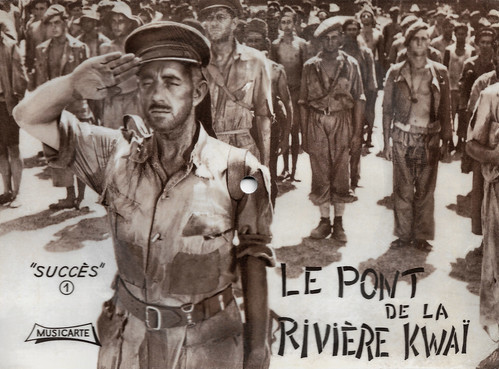
French singing postcard by Musicarte, Paris, no. 501. Photo: Alec Guinness in The Bridge on the River Kwai (David Lean, 1957). Caption: Succès. One can use this singing postcard (in French: La Carte qui chante) as a record 45 R.P.M. The song is 'Colonel Bogey' by Oscar Denayer and his Orchestra.
English actor Sir Alec Guinness (1914–2000) was one of the most versatile and subtle actors of his time, in the cinema and on television no less than on the stage. He was master of disguise in several of the classic Ealing Comedies, including Kind Hearts and Coronets (1949) in which he played eight different characters. He later won the Academy Award for Best Actor for his role as Colonel Nicholson in The Bridge on the River Kwai (1957), and he is probably even better known for playing Obi-Wan Kenobi in the original Star Wars trilogy (1977-1983).
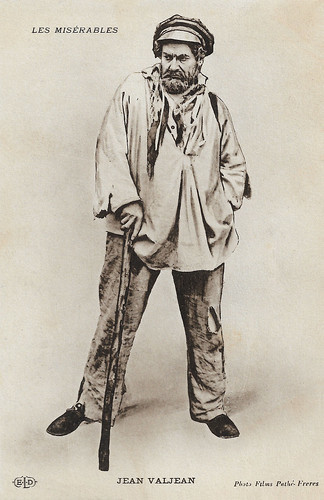
French postcard by ELD. Photo: Films Pathé-Frères. Henry Krauss in Les Misérables (Albert Capellani, 1913). Sent by mail in 1916.
French actor and director Henry Krauss (1866-1935) was a veteran of European cinema. From 1908 on, he starred in several powerful character roles in early silent films.
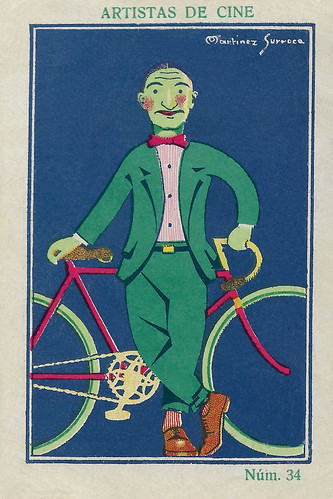
Spanish collectors card in the Artistas de Cine Series by Chocolate Amattler, Barcelona, no. 34. Image: Martinez Surroca.
Georges Biscot (1886-1945) was a popular French music-hall and revue singer and actor, who also knew a career in French silent and sound film.
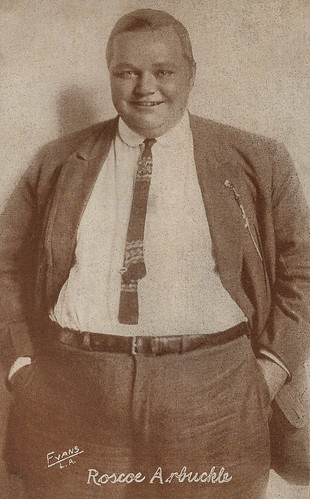
American Arcade card. Photo: Evans, L.A.
American silent film actor, comedian Roscoe ‘Fatty’ Arbuckle (1887-1933) was one of the most popular silent stars of the 1910s. He started at the Selig Polyscope and moved to Keystone Studios, where he worked with Mabel Normand and Harold Lloyd. Arbuckle mentored Charlie Chaplin and discovered Buster Keaton and Bob Hope. In 1920, he signed a contract with Paramount Pictures for US$1 million. Between November 1921 and April 1922, Arbuckle was the defendant in three widely publicised trials for the rape and manslaughter of actress Virginia Rappe. Following the trials, his films were banned and he was publicly ostracized. Arbuckle only later worked as a film director under the alias William Goodrich. He was finally able to return to acting, making short two-reel comedies in 1932 for Warner Bros. He died in his sleep of a heart attack in 1933 at age 46, reportedly on the same day he signed a contract with Warner Brothers to make a feature film.
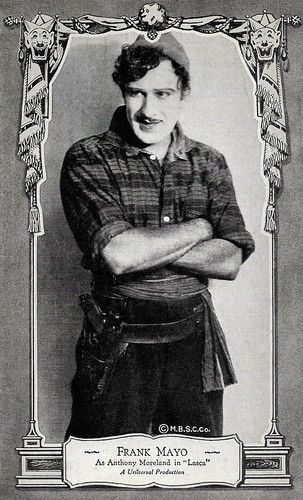
American postcard by M.B.S.C. Co. Photo: Universal. Frank Mayo as Anthony Moreland in Lasca (Norman Dawn, 1919).
Frank Mayo (1889–1963) was an American actor, who appeared in 310 films between 1911 and 1949. He was one of the major stars of the American silent film in the 1910s and 1920s. He also worked as a director.
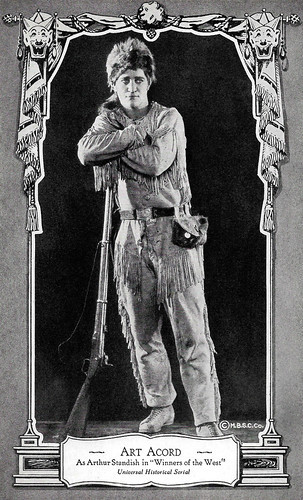
American postcard by Max B. Sheffer Card Co., Chicago (M.B.S.C.Co.). Photo: Universal. Art Acord as Arthur Standish in Winners of the West (Edward Laemmle, 1921). Caption: Universal Historical Serial.
American silent star Art Acord (1890-1931) was known as "The Cowpuncher King". He was a rodeo champion and as a film star, he was known for such Westerns as The White Horseman (1921), The Set-Up (1926), and Set Free (1927).
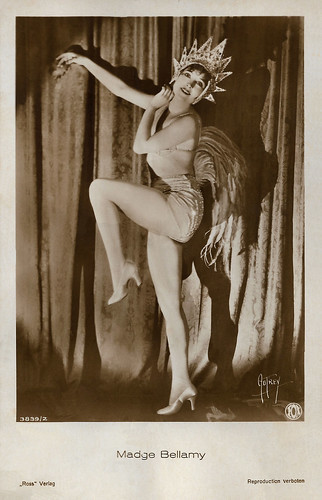
German postcard by Ross Verlag, no. 3839/2, 1928-1929. Photo: Max Munn Autrey / Fox Film.
Madge Bellamy (1899-1990) was a beautiful and temperamental leading lady of the silent era, known for such classics as John Ford's first Western The Iron Horse (1924). She appeared in about fifty silent films and also in a dozen sound films, including the cult favourite White Zombie (1932). By the late 1930s, her film career had virtually ended, but in 1943 she became again fodder for the press when she was arrested for shooting her former lover.
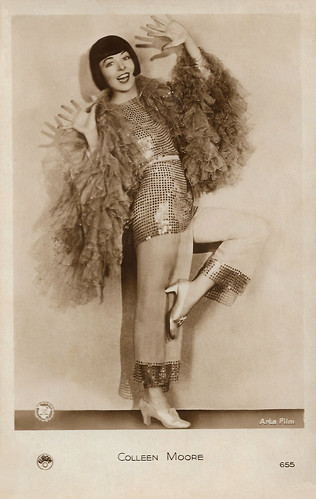
French postcard by Europe, no. 655. Photo: First National / Arta Film.
American actress Colleen Moore (1899-1988) was a star of the silent screen who appeared in about 100 films beginning in 1917. During the 1920s, she put her stamp on American social history, creating in dozens of films the image of the wide-eyed, insouciant flapper with her bobbed hair and short skirts.
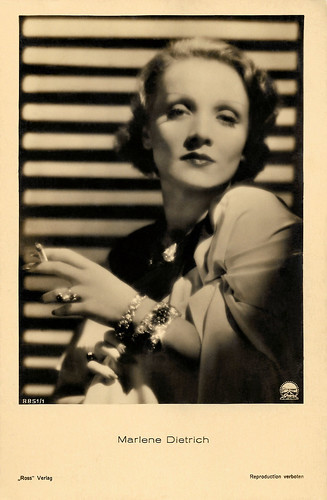
German postcard by Ross Verlag, no. 8851/1, 1933-1934. Photo: Paramount.
Marlene Dietrich (1901-1992) was the first German actress who became successful in Hollywood. Throughout her long career, she constantly re-invented herself. In 1920s Berlin, she started as a cabaret singer, chorus girl, and film actress. In the 1930s, she became a Hollywood star, then a World War II frontline entertainer, and finally, she was an international stage show performer from the 1950s till the 1970s. Now we remember her as one of the icons of the 20th century.
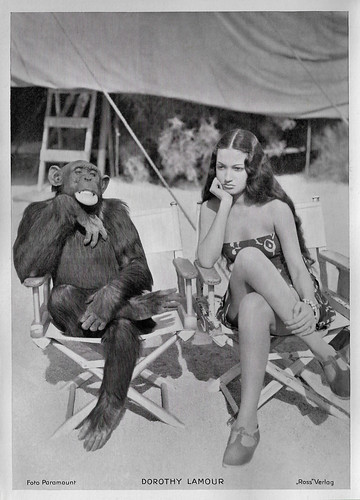
Big German card by Ross Verlag. Photo: Paramount.
American actress and singer Dorothy Lamour (1914-1996) is best remembered for appearing in the Road to... comedies, starring Bing Crosby and Bob Hope. During World War II, Lamour was among the most popular pin-up girls among American servicemen.
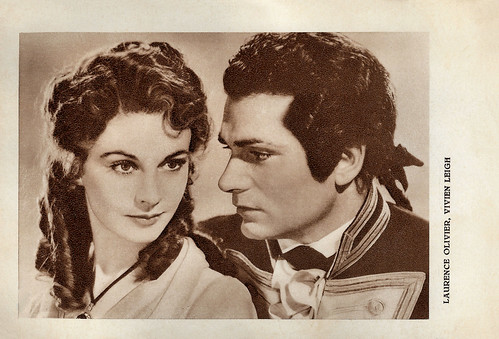
Vintage postcard. Photo: Vivien Leigh and Laurence Olivier in Lady Hamilton (Alexander Korda, 1941).
Extraordinarily beautiful British actress Vivien Leigh (1913-1967) won two Academy Awards for playing ‘Southern belles’: Scarlett O'Hara in Gone with the Wind (1939) and Blanche DuBois in A Streetcar Named Desire (1951). On stage, she starred – often with her husband, Laurence Olivier - in parts that ranged from the heroines of Noël Coward and George Bernard Shaw comedies to Shakespearean characters like Ophelia, Juliet, and Lady Macbeth.
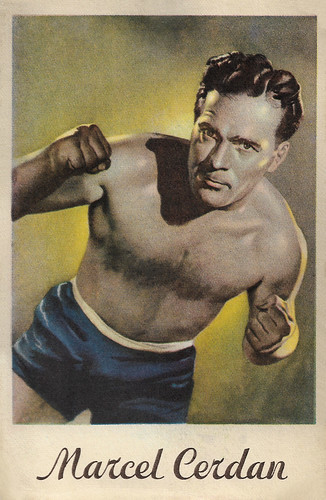
French postcard by J. Henzen, Paris / C.F., Paris. Caption: Marcel Cerdan, European Champion Middle Weight.
World boxing champion Marcel Cerdan (1916-1949)' nicknamed ‘The Casablanca Clouter’, was France's greatest boxer. His life was marked by his sporting achievements, his passionate love affair with Édith Piaf, and his tragic death. He appeared in two films and was portrayed in two films.
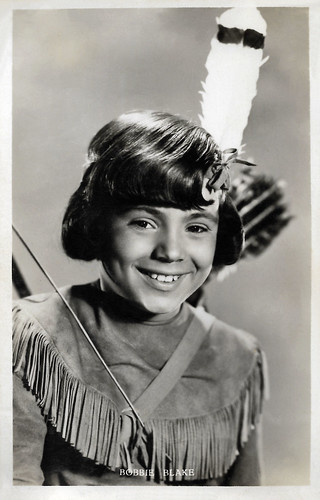
Belgian postcard by Nieuwe Merksemsche Chocolaterie S.P.R.L., Merksem (Anvers). Photo: Republic Pictures. Robert 'Bobby' Blake as Little Hunter.
American actor Robert Blake (1933) began acting as a child in the Little Rascals series (1939-1944) and the Red Ryder Westerns, as Little Beaver and later Little Hunter. Later, he became known for his stunning portrayal of killer Perry Smith in the film In Cold Blood (1966) and as street-wise detective Baretta in the TV series Baretta (1975-1978).
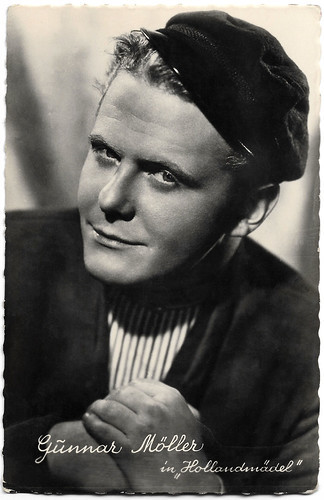
Austrian postcard by Verlag Hubmann (HDH Verlag), Wien (Vienna), no. 2948. Gunnar Möller in Hollandmädel/Dutch Girl (J.A. Hübler-Kahla, 1953).
German actor Gunnar Möller (1928-2017) was one of the stars of the Wirtschaftswunder Kino of the 1950s. He appeared in over 160 film and television productions between 1940 and 2016. He later turned to character roles and worked for a number of years in England.
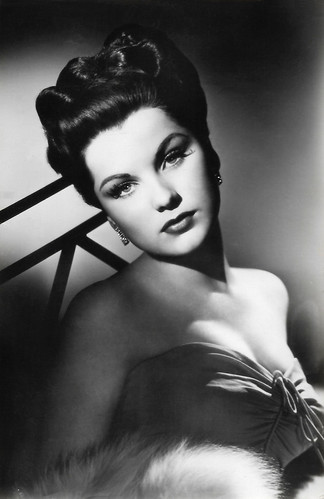
Yugoslavian postcard by Studio Sombor, no. 264.
Exotic American actress Debra Paget (1933) is perhaps best known for Cecil B. DeMille's epic The Ten Commandments (1956) and Elvis Presley’s film debut Love Me Tender (1956). Later, she had a career in Europe too. In Germany, she starred in Fritz Lang's two-film adventure saga Der Tiger von Eschnapur/The Tiger of Eschnapur (1959) and Das Indische Grabmal/The Indian Tomb (1960) and in Italy, she also made a pair of films.
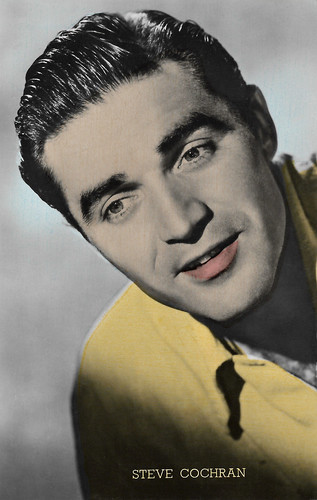
Swedish postcard by Äkta handkolorerade fotokort, no. 20014.
Husky, darkly handsome Steve Cochran (1917-1965) was an American film, television, and stage actor, who often played boxers and gangsters during the 1940s and 1950s. One of his best-known roles is the troubled drifter in Michelangelo Antonioni's Il Grido (1957), produced in Italy.
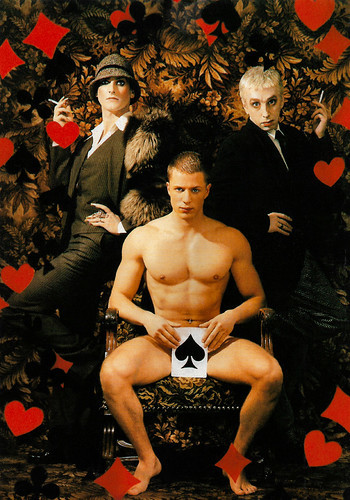
French postcard. Photo: Pierre et Gilles. Laurent Chemda, Eliane Pine Carrington and Nini Crépon in Le Traité du Hasard/The Treaty of Chance (Patrick Mimouni, 1998).
Le Traité du Hasard/The Treaty of Chance (Patrick Mimouni, 1998) is a little-known Parisian gay dramatic comedy. It chronicles the lives of a small band of "crazy" homosexuals in Paris, between 1995 and 1997. They are confronted with seropositivity, each in his own way. One of them will develop the disease, but without succumbing to it, thanks to the arrival of triple therapies.
The most notable reason for acquiring this postcard was the wonderful poster image by Pierre et Gilles. Pierre et Gilles is the pseudonym of a couple of French visual artists formed by the photographer Pierre Commoy, (1950) and the painter Gilles Blanchard (1953). Since 1976, they have been developing four-handed works between painting and photography. Their paintings feature their relatives, anonymous or famous, in sophisticated settings built life-size in the workshop. Once the photograph is printed on canvas, a meticulous painting work begins. They have created a unique iconography exploring the border between the history of art and popular culture. They designed several film 'affiches', including posters for Les Amants criminels/Criminal lovers (François Ozon, 1999), and Presque Rien/Almost Nothing (Sébastien Lifshitz, 2000).

French singing postcard by Musicarte, Paris, no. 501. Photo: Alec Guinness in The Bridge on the River Kwai (David Lean, 1957). Caption: Succès. One can use this singing postcard (in French: La Carte qui chante) as a record 45 R.P.M. The song is 'Colonel Bogey' by Oscar Denayer and his Orchestra.
English actor Sir Alec Guinness (1914–2000) was one of the most versatile and subtle actors of his time, in the cinema and on television no less than on the stage. He was master of disguise in several of the classic Ealing Comedies, including Kind Hearts and Coronets (1949) in which he played eight different characters. He later won the Academy Award for Best Actor for his role as Colonel Nicholson in The Bridge on the River Kwai (1957), and he is probably even better known for playing Obi-Wan Kenobi in the original Star Wars trilogy (1977-1983).

French postcard by ELD. Photo: Films Pathé-Frères. Henry Krauss in Les Misérables (Albert Capellani, 1913). Sent by mail in 1916.
French actor and director Henry Krauss (1866-1935) was a veteran of European cinema. From 1908 on, he starred in several powerful character roles in early silent films.

Spanish collectors card in the Artistas de Cine Series by Chocolate Amattler, Barcelona, no. 34. Image: Martinez Surroca.
Georges Biscot (1886-1945) was a popular French music-hall and revue singer and actor, who also knew a career in French silent and sound film.

American Arcade card. Photo: Evans, L.A.
American silent film actor, comedian Roscoe ‘Fatty’ Arbuckle (1887-1933) was one of the most popular silent stars of the 1910s. He started at the Selig Polyscope and moved to Keystone Studios, where he worked with Mabel Normand and Harold Lloyd. Arbuckle mentored Charlie Chaplin and discovered Buster Keaton and Bob Hope. In 1920, he signed a contract with Paramount Pictures for US$1 million. Between November 1921 and April 1922, Arbuckle was the defendant in three widely publicised trials for the rape and manslaughter of actress Virginia Rappe. Following the trials, his films were banned and he was publicly ostracized. Arbuckle only later worked as a film director under the alias William Goodrich. He was finally able to return to acting, making short two-reel comedies in 1932 for Warner Bros. He died in his sleep of a heart attack in 1933 at age 46, reportedly on the same day he signed a contract with Warner Brothers to make a feature film.

American postcard by M.B.S.C. Co. Photo: Universal. Frank Mayo as Anthony Moreland in Lasca (Norman Dawn, 1919).
Frank Mayo (1889–1963) was an American actor, who appeared in 310 films between 1911 and 1949. He was one of the major stars of the American silent film in the 1910s and 1920s. He also worked as a director.

American postcard by Max B. Sheffer Card Co., Chicago (M.B.S.C.Co.). Photo: Universal. Art Acord as Arthur Standish in Winners of the West (Edward Laemmle, 1921). Caption: Universal Historical Serial.
American silent star Art Acord (1890-1931) was known as "The Cowpuncher King". He was a rodeo champion and as a film star, he was known for such Westerns as The White Horseman (1921), The Set-Up (1926), and Set Free (1927).

German postcard by Ross Verlag, no. 3839/2, 1928-1929. Photo: Max Munn Autrey / Fox Film.
Madge Bellamy (1899-1990) was a beautiful and temperamental leading lady of the silent era, known for such classics as John Ford's first Western The Iron Horse (1924). She appeared in about fifty silent films and also in a dozen sound films, including the cult favourite White Zombie (1932). By the late 1930s, her film career had virtually ended, but in 1943 she became again fodder for the press when she was arrested for shooting her former lover.

French postcard by Europe, no. 655. Photo: First National / Arta Film.
American actress Colleen Moore (1899-1988) was a star of the silent screen who appeared in about 100 films beginning in 1917. During the 1920s, she put her stamp on American social history, creating in dozens of films the image of the wide-eyed, insouciant flapper with her bobbed hair and short skirts.

German postcard by Ross Verlag, no. 8851/1, 1933-1934. Photo: Paramount.
Marlene Dietrich (1901-1992) was the first German actress who became successful in Hollywood. Throughout her long career, she constantly re-invented herself. In 1920s Berlin, she started as a cabaret singer, chorus girl, and film actress. In the 1930s, she became a Hollywood star, then a World War II frontline entertainer, and finally, she was an international stage show performer from the 1950s till the 1970s. Now we remember her as one of the icons of the 20th century.

Big German card by Ross Verlag. Photo: Paramount.
American actress and singer Dorothy Lamour (1914-1996) is best remembered for appearing in the Road to... comedies, starring Bing Crosby and Bob Hope. During World War II, Lamour was among the most popular pin-up girls among American servicemen.

Vintage postcard. Photo: Vivien Leigh and Laurence Olivier in Lady Hamilton (Alexander Korda, 1941).
Extraordinarily beautiful British actress Vivien Leigh (1913-1967) won two Academy Awards for playing ‘Southern belles’: Scarlett O'Hara in Gone with the Wind (1939) and Blanche DuBois in A Streetcar Named Desire (1951). On stage, she starred – often with her husband, Laurence Olivier - in parts that ranged from the heroines of Noël Coward and George Bernard Shaw comedies to Shakespearean characters like Ophelia, Juliet, and Lady Macbeth.

French postcard by J. Henzen, Paris / C.F., Paris. Caption: Marcel Cerdan, European Champion Middle Weight.
World boxing champion Marcel Cerdan (1916-1949)' nicknamed ‘The Casablanca Clouter’, was France's greatest boxer. His life was marked by his sporting achievements, his passionate love affair with Édith Piaf, and his tragic death. He appeared in two films and was portrayed in two films.

Belgian postcard by Nieuwe Merksemsche Chocolaterie S.P.R.L., Merksem (Anvers). Photo: Republic Pictures. Robert 'Bobby' Blake as Little Hunter.
American actor Robert Blake (1933) began acting as a child in the Little Rascals series (1939-1944) and the Red Ryder Westerns, as Little Beaver and later Little Hunter. Later, he became known for his stunning portrayal of killer Perry Smith in the film In Cold Blood (1966) and as street-wise detective Baretta in the TV series Baretta (1975-1978).

Austrian postcard by Verlag Hubmann (HDH Verlag), Wien (Vienna), no. 2948. Gunnar Möller in Hollandmädel/Dutch Girl (J.A. Hübler-Kahla, 1953).
German actor Gunnar Möller (1928-2017) was one of the stars of the Wirtschaftswunder Kino of the 1950s. He appeared in over 160 film and television productions between 1940 and 2016. He later turned to character roles and worked for a number of years in England.

Yugoslavian postcard by Studio Sombor, no. 264.
Exotic American actress Debra Paget (1933) is perhaps best known for Cecil B. DeMille's epic The Ten Commandments (1956) and Elvis Presley’s film debut Love Me Tender (1956). Later, she had a career in Europe too. In Germany, she starred in Fritz Lang's two-film adventure saga Der Tiger von Eschnapur/The Tiger of Eschnapur (1959) and Das Indische Grabmal/The Indian Tomb (1960) and in Italy, she also made a pair of films.

Swedish postcard by Äkta handkolorerade fotokort, no. 20014.
Husky, darkly handsome Steve Cochran (1917-1965) was an American film, television, and stage actor, who often played boxers and gangsters during the 1940s and 1950s. One of his best-known roles is the troubled drifter in Michelangelo Antonioni's Il Grido (1957), produced in Italy.

French postcard. Photo: Pierre et Gilles. Laurent Chemda, Eliane Pine Carrington and Nini Crépon in Le Traité du Hasard/The Treaty of Chance (Patrick Mimouni, 1998).
Le Traité du Hasard/The Treaty of Chance (Patrick Mimouni, 1998) is a little-known Parisian gay dramatic comedy. It chronicles the lives of a small band of "crazy" homosexuals in Paris, between 1995 and 1997. They are confronted with seropositivity, each in his own way. One of them will develop the disease, but without succumbing to it, thanks to the arrival of triple therapies.
The most notable reason for acquiring this postcard was the wonderful poster image by Pierre et Gilles. Pierre et Gilles is the pseudonym of a couple of French visual artists formed by the photographer Pierre Commoy, (1950) and the painter Gilles Blanchard (1953). Since 1976, they have been developing four-handed works between painting and photography. Their paintings feature their relatives, anonymous or famous, in sophisticated settings built life-size in the workshop. Once the photograph is printed on canvas, a meticulous painting work begins. They have created a unique iconography exploring the border between the history of art and popular culture. They designed several film 'affiches', including posters for Les Amants criminels/Criminal lovers (François Ozon, 1999), and Presque Rien/Almost Nothing (Sébastien Lifshitz, 2000).
Published on January 01, 2021 22:00
December 31, 2020
Stars who passed away in 2020
On the first day of 2021, EFSP remembers the stars of the international cinema we had to say farewell to in 2020. Thank you, for your films and postcards. We salute you!
31 December 2019: Milan Beli (1931-2019)
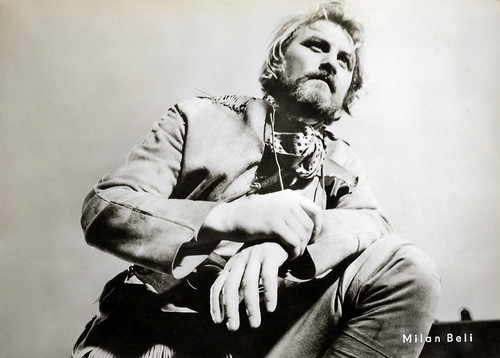
East-German postcard by VEB Progress Film-Vertrieb, Berlin, no. 42/72. Photo: Schütz / DEFA. Milan Beli in Tecumseh (Hans Kratzert, 1972).
Serbian actor Milan Beli or Milan Bosiljcic passed away on the last day of 2019, at the age of 88. He was best known as the villain in such East-German films as the Eastern Tecumseh (1972), Das Licht auf dem Galgen (1976), and Das Ding im Schloß (1979). He appeared in more than 50 European films.
12 January 2020: Aart Staartjes (1938-2020)
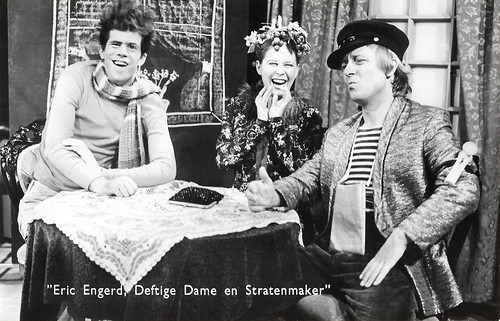
Dutch postcard by Vara. Photo: Fotoatelier Nederlandse Omroep Stichting. Joost Prinssen as Erik Engerd (Eerie Eric), Wieteke van Dort as Deftige Dame (Posh Lady) and Aart Staartjes as Stratemaker op zee (Bricklayer at sea), in De Stratemaker op zee show/The bricklayer at sea show" (Frans Boelen, Aart Staartjes, 1972).
Dutch actor and TV icon Aart Staartjes is known in The Netherlands for such innovative children's TV classics as De stratenmaker op zee show/The bricklayer at sea show" (1972), De film van ome Willem (1974), J.J. de Bom voorheen: 'De kindervriend' (1979) and the Dutch version of Sesame Street, Sesamstraat. On 10 January, Staartjes was involved in a collision between a car and a quadricycle in Leeuwarden. He was taken to the hospital in critical condition and died two days later. Aart Staartjes was 81 years old.
28 January: Monique Van Vooren (1927-2020)
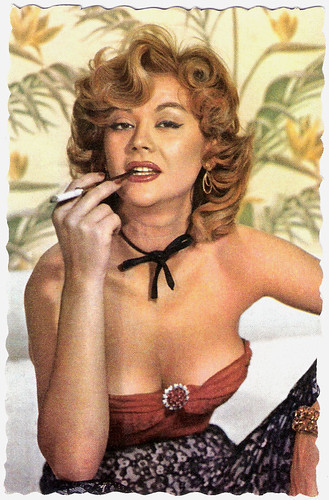
French postcard by De Marchi Frères, Marseille. Photo: Bernard of Hollywood.
Belgian-born model, singer, and actress Monique Van Vooren gained notoriety for her many celebrity appearances on the game and variety show circuit in the 1950s and 1960s. She became a cult star, best remembered for her role as Baroness Katrin Frankenstein in Flesh for Frankenstein (1973).
5 February: Kirk Douglas (1916-2020)
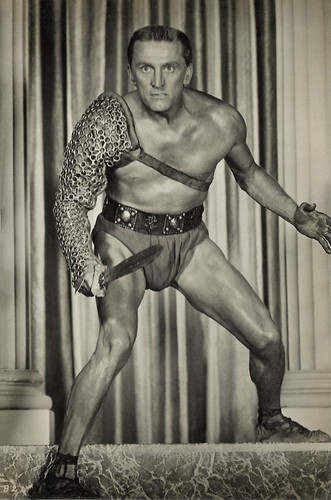
Spanish postcard by Archivo Bermejo, no. 7143. Photo: Universal International, 1960. Kirk Douglas in Spartacus (Stanley Kubrick, 1960).
Cleft-chinned and steely-eyed American superstar Kirk Douglas passed away in Los Angeles, at the age of 103. The legendary actor, producer, and director made his film debut in The Strange Love of Martha Ivers (1946) with Barbara Stanwyck. Douglas soon developed into a leading box-office star throughout the 1950s, known for serious dramas, Westerns, and war films. Our favourites are the two classics he made with Stanley Kubrick, Paths of Glory (1957), and Spartacus (1960). During his long career, he appeared in more than 90 films.
17 February: Sonja Ziemann (1926-2020)
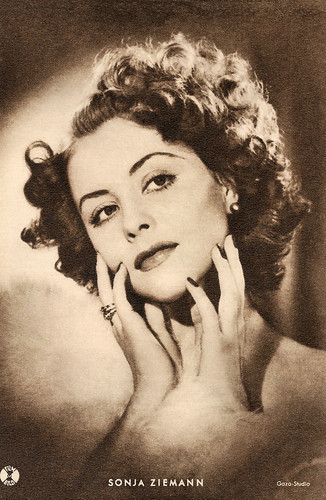
German postcard by Film und Bild, Frankfurt-Main. Photo: Gaza-Studio.
German film and television actress, singer, and dancer Sonja Ziemann passed away at the age of 94. The delicately lovely, dark-haired, and innocent-looking Ziemann was one of the first stars of Germany's post-war cinema. She starred in film operettas and Heimatfilms as Schwarzwaldmädel/The Black Forest Girl (1950) and Grün ist die Heide/The Heath is Green (1951). Her private life knew several tragedies.
24 February: Baby Peggy (1918-2020)
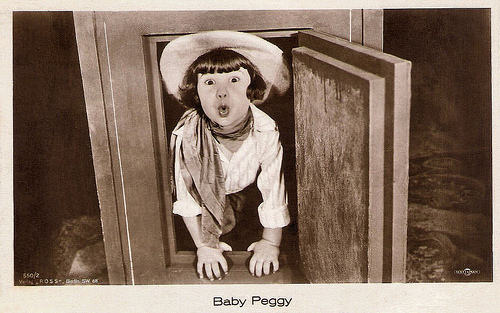
German postcard by Ross Verlag, Berlin, no. 550/2, 1919-1924. Photo: Unifilman.
One of the last superstars of the silent film era died in 2020. Diana Serra Cary (1918), best known as Baby Peggy passed away in Gustine, California. She was one of the three major American child stars of the Hollywood silent movie era along with Jackie Coogan and Baby Marie. She spent decades coming to terms with a bizarre childhood of triumphs, heartbreaks, and parents who squandered her fortune. Diana Serra Cary was 101.
27 February: Burkhard Driest (1939-2020)
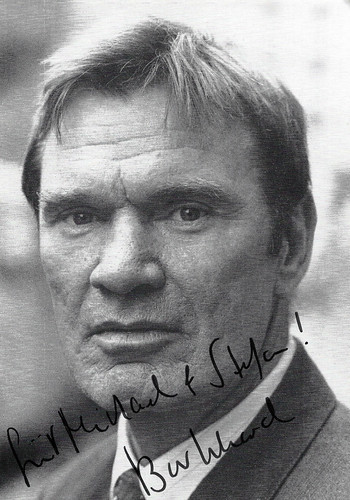
German autograph card.
German actor, writer, and director Burkhard Driest was known for his roles in Sam Peckinpah's Cross of Iron (1977) and Rainer Werner Fassbinder's Querelle (1980), but in Germany, he was best known as a former bank-robber. Hyper-virile, tall, square-shouldered, and rough-faced, he was one of Germany's favourite bad guys.
15 March: Suzy Delair (1917-2020)
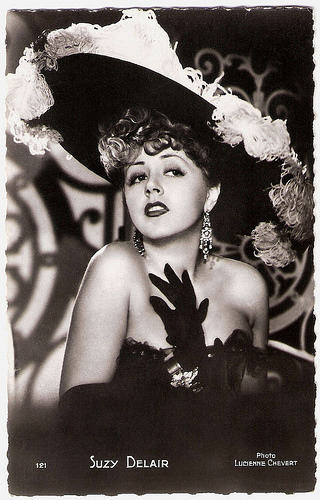
French postcard by Editions P.I., offered by Les Carbones Korès, no. 121. Photo: Lucienne Chevert. Publicity still for Quai des Orfèvres (Henri-Georges Clouzot, 1947).
Vivacious French actress and singer Suzy Delair starred in many different films and was also famous in France as a singer of songs like Avec son Tra-la-la. For several years, the saucy star was the companion of film director Henri-Georges Clouzot, in whose films of the 1940s she appeared, including the masterpiece Quai des Orfèvres/Quay of the Goldsmiths (1947). La Delair was 102.
23 March: Lucia Bosé (1931-2020)
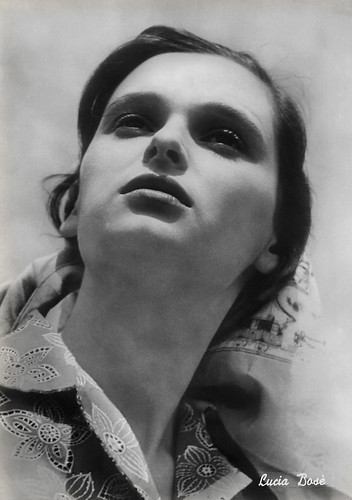
Italian postcard by Bromofoto, Milano, no. 270.
Italian actress Lucia Bosé passed away in Brieva, Spain. She died of pneumonia caused by the coronavirus (COVID-19). Bosé was famous for her films from the 1950s with a.o. Giuseppe De Santis and Michelangelo Antonioni. In the same years and after, she also worked with other famous directors such as Juan Bardem, Luis Buñuel, the Taviani brothers, Liliane Cavani, Francesco Rosi, and Ferzan Özpetek. Lucia Bosé was 89.
24 March: Albert Uderzo (1927-2020)
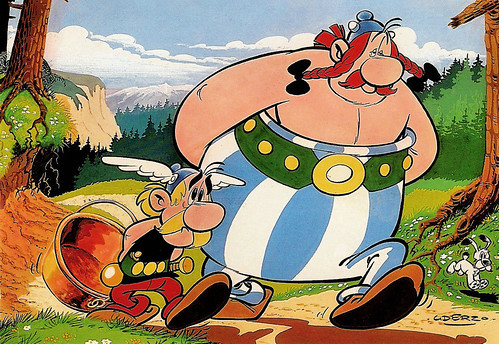
French postcard by Franceco, Paris, no. 0963013. Image: Editions Albert Rene / Goscinny / Uderzo, 1984. Caption: Goscinny-Uderzo, Le chaudron vide. (The empty cauldron).
The French comic book artist and scriptwriter Albert Uderzo was best known for his work on Astérix. At the age of 92, he died in his sleep at his home in Neuilly from a heart attack unrelated to the coronavirus. Astérix has also become a major film franchise, both in animated and live-action form. Most notable is the feature Astérix & Obélix contre César/Asterix & Obelix Take on Caesar (Claude Zidi, 1999), starring Christian Clavier, Gerard Depardieu, and Roberto Benigni.
25 March: Liesbeth List (1941-2020)

West-German autograph card, 1967. Photo: Philips.
Dutch singer and actress Liesbeth List (1941) was known as the Grande Dame of the Dutch chanson, thanks to songs like 'Pastorale', 'Aan de andere kant van de heuvels' (On the other side of the hills), and 'Kinderen een kwartje' (Children a quarter). She became popular during the 1960s and frequently collaborated with Ramses Shaffy. List sang Jacques Brel's chansons in a Dutch translation, and also acted in a few Dutch films. Liesbeth List was 78.
28 March: Barbara Rütting (1927-2020)
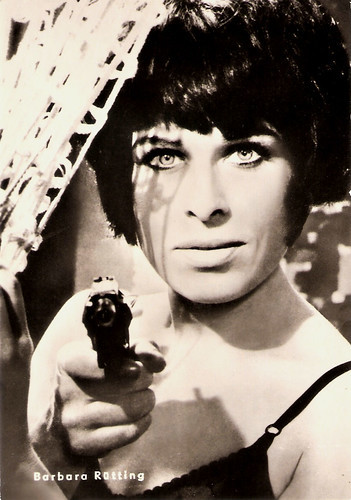
East-German postcard by VEB Progress Film-Vertrieb, Berlin, no. 172/70, 1970. Photo: Progress. Barbara Rütting in Neues vom Hexer/Again the Ringer (Alfred Vohrer, 1965).
German film actress, politician and author Barbara Rütting appeared in 50 films between 1952 and 1983. She was a star of German cinema in the 1950s and 1960s, appearing in Canaris (1954) with O. E. Hasse and in Die Letzte Brücke/The Last Bridge (1954) with Maria Schell. In 1961, she played the female lead as a journalist in the American-German film Town Without Pity (1961), co-starring Kirk Douglas and Christine Kaufmann. Later she became a well-known human rights and animal welfare activist, and a politician for The Greens.
6 April: Honor Blackman (1925-2020)
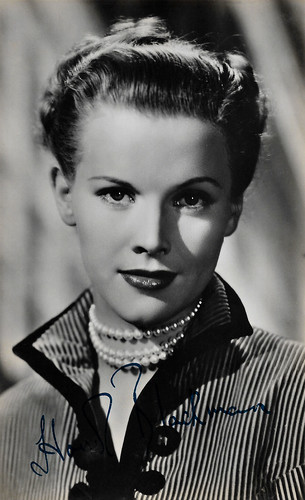
British autograph card.
British actress Honor Blackman was best known for playing the Bond girl Pussy Galore opposite Sean Connery in Goldfinger (1964). Blackman became a household name in the 1960s as Cathy Gale in The Avengers in which she showed an extraordinary combination of beauty, brains, and physical prowess. After a career spanning eight decades, she died of natural causes unrelated to coronavirus, at the age of 94.
16 April: Christophe (1945-2020)
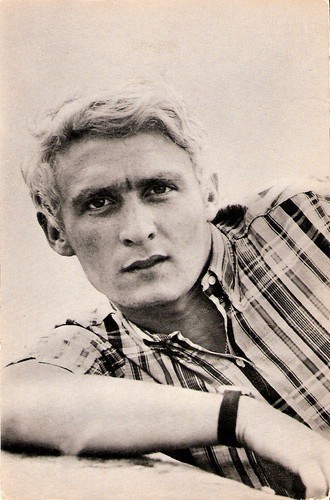
Vintage postcard.
French Chanson singer and composer Christophe (1945) a.k.a. Daniel Bevilacqua became famous in the early 1960s with his hits 'Aline' and 'Oh!... Mon Amour' which he sang in French and Italian. He died of complications by the Coronavirus at the age of 74.
22 April: Shirley Knight (1936-2020)
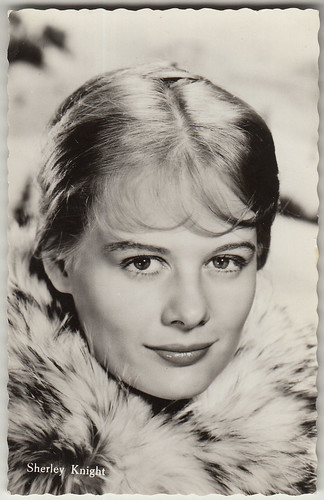
Dutch postcard. Collection: Marlene Pilaete.
American actress Shirley Knight appeared in more than 50 feature films, television films, television series, and Broadway and Off-Broadway productions in her career, playing leading and character roles. Knight was nominated twice for the Oscar for Best Supporting Actress: for The Dark at the Top of the Stairs (1960) and Sweet Bird of Youth (1962). She received the Volpi Cup for Best Actress for her role in the British film Dutchman (1966). In 1976, Knight won a Tony for 'Kennedy's Children', a play by Robert Patrick. Knight was also nominated eight times for an Emmy (winning three), and she received a Golden Globe.
2 May: John Ericson (1926-2020)
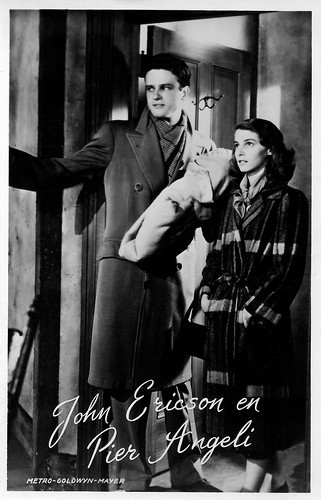
Dutch postcard by Takken, Utrecht, no. 709. Photo: Metro-Goldwyn-Mayer (MGM). John Ericson and Pier Angeli in Teresa (Fred Zinnemann, 1951).
In the 1950s, John Ericson (1926-2020) was a young an promising star with wavy-haired good looks and an athletic build who made a series of films for MGM, including Teresa (1951) and The Student Prince (1954). Later, the German-American actor worked mostly for television, most memorably as the partner of Anne Francis in Honey West (1965-1966). He was 93.
9 May: Little Richard (1932-2020)
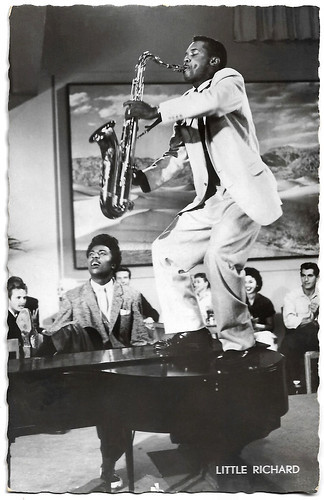
Dutch postcard by Uitg. Int. Filmpers (I.F.P.), Amsterdam, no. 1525. Little Richard performs with his band as his saxophone player Grady Gaines stands on the piano in Mister Rock And Roll (Charles S. Dubin, 1957).
American pianist-singer Little Richard was one of the first crossover black artists, reaching audiences of all races. In the mid-1950s, his dynamic songs like 'Tutti Frutti' and 'Good Golly Miss Molly' and his charismatic showmanship laid the foundation for rock and roll. Little Richard was 87.
12 May: Michel Piccoli (1925-2020)
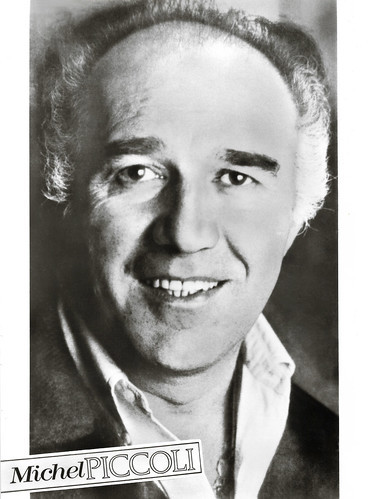
Big East-German collectors card by Progress Film-Verleih, Berlin, no. 31/83, 1983.
Michel Piccoli , one of the most original and versatile French actors of the last half-century, died aged 94. He appeared in many different roles, from seducer to cop to a gangster to Pope in more than 200 films and TV films. Among the directors he worked with are Jean Renoir, Jean-Pierre Melville, Jean-Luc Godard, Agnès Varda, Luis Buñuel, and Alfred Hitchcock.
26 May: Irm Hermann (1942-2020)

German postcard by Franz Josef Rüdel, Filmpostkartenverlag, Hamburg. Photo: Margarete Redl-von Peinen.
German actress and assistant director Irm Hermann passed away in Berlin after a short illness. She was the muse and a close friend of Rainer Werner Fassbinder and played roles in 24 of his films including Die bitteren Tränen der Petra von Kant (1972). Overall, she appeared in over 160 film and television productions until 2018. Irm Hermann was 77.
18 June: Vera Lynn (1917-2020)
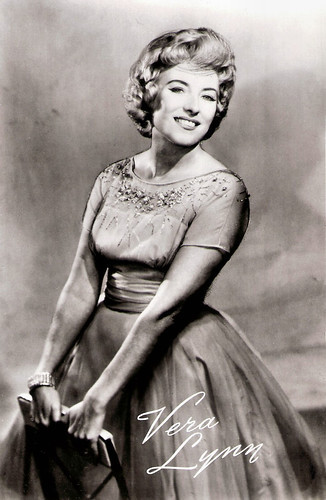
Dutch postcard by Takken, Utrecht, no. AX 5267. Photo: M.G.M. Promotional picture for her L.P. 'Hits of the blitz'.
Dame Vera Lynn, known as 'the Forces' Sweetheart', passed away at the age of 103. Lynn was a British singer of traditional popular music, songwriter, and actress, whose musical recordings and performances were enormously popular during the Second World War. The songs most associated with her are 'We'll Meet Again', 'The White Cliffs of Dover', 'A Nightingale Sang in Berkeley Square' and 'There'll Always Be an England'. She remained popular after the war, appearing on radio and television internationally and recording such hits as 'Auf Wiederseh'n Sweetheart' and 'My Son, My Son'.
18 June: Claus Biederstaedt (1928-2020)
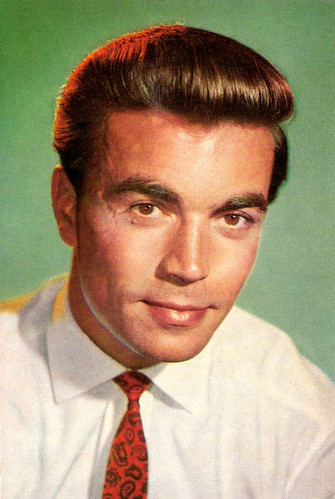
German postcard by WS-Druck, no. F 2. Photo: Ringpress / Vogelmann / Bavaria.
German actor Claus Biederstaedt passed away at the age of 91. He was a typical 'sonny boy', the nice & friendly star of the Wirtschaftswunder cinema of the 1950s. With his twinkling eyes, he was the charming and funny young man in many German-language comedies and melodramas and even in some war films.
27 June: Linda Cristal (1934-2020)
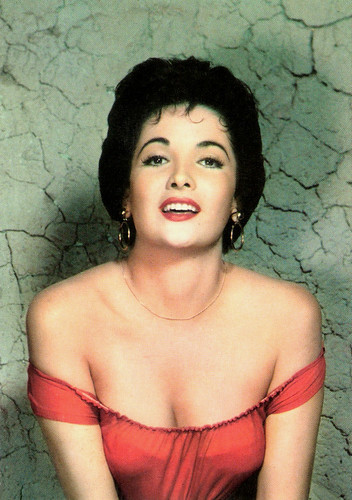
Italian postcard by Rotalcolor, Milano, no. 115.
Argentine-American actress Linda Cristal passed away in her sleep in Beverly Hills. She appeared in a number of Westerns during the 1950s, before winning a Golden Globe Award for her performance in the comedy The Perfect Furlough (1958). From 1967 to 1971, Cristal starred as Victoria Cannon in the popular TV series The High Chaparral, for which she won a Golden Globe Award in 1968. Linda Cristal was 86.
2 July: Tilo Prückner (1940-2020)
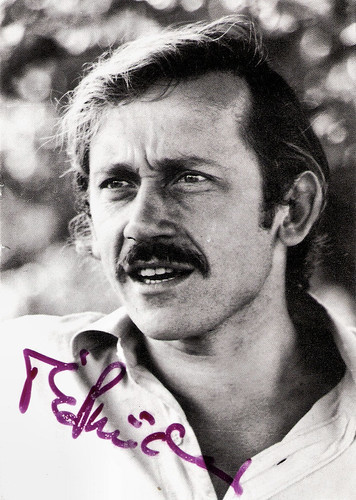
German postcard by Franz Josef Rüdel, Filmpostkartenverlag, Hamburg. Photo: Volker Kimstädt.
The career of German television and film actor Tilo Prückner spanned five decades and more than 100 films. Prückner died of sudden heart failure in Berlin at the age of 79.
6 July: Ennio Morricone (1928-2020)
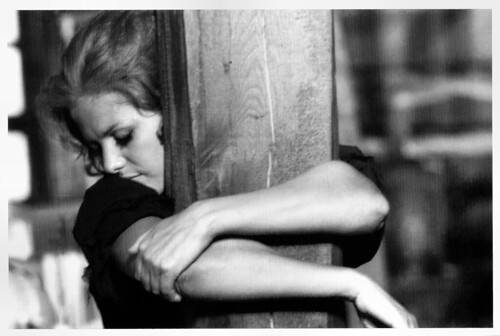
Italian postcard by Cineteca Bologna, 2007. Photo: A. Novi / Cineteca di Bologna. Claudia Cardinale in C'era una volta il West/Once Upon a Time in the West (Sergio Leone, 1968).
Italian film composer Ennio Morricone was a classmate of director Sergio Leone with whom he would form one of the great director/composer partnerships, right up there with Eisenstein & Prokofiev, Hitchcock & Herrmann, Fellini & Rota. Our favourite Morricone music is his score for C'era una volta il West/Once Upon a Time in the West (Sergio Leone, 1968). He has written nearly 400 film scores. Morricone died in the aftermath of a fall. He was 92.
17 July: Zizi Jeanmaire (1924-2020)
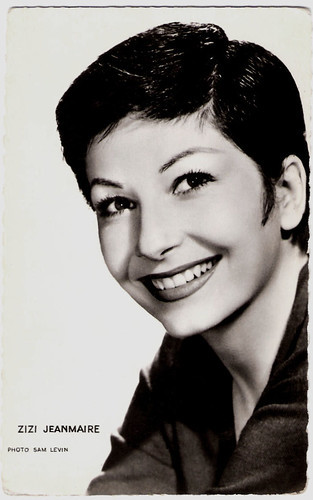
French postcard by Editions P.I., Paris, no. 797. Photo: Sam Lévin.
Glamorous ballet dancer and film star Zizi Jeanmaire passed away in Tolochenaz, Switzerland. She became famous in the 1950s after playing the title role in the ballet version of 'Carmen', produced in London in 1949. She went on to appear in films in France and Hollywood. She was the widow of dancer and choreographer Roland Petit, one of the major creative forces in ballet during the 1940s and 1950s. Zizi Jeanmaire was 96.
25 July: Olivia de Havilland (1916-2020)

Belgian postcard by Victoria, Brussels, no. 639/24. Photo: Paramount.
Olivia de Havilland (1916), passed away in her hometown Paris. The Japanese-born British-American former actress had a career that spanned from 1935 to 1988. She appeared in 49 feature films and was one of the leading stars during the golden age of Classical Hollywood. She is best known for her early screen performances in The Adventures of Robin Hood (1938) and Gone with the Wind (1939), and her later award-winning performances in To Each His Own (1946), The Snake Pit (1948), and The Heiress (1949). Olivia de Havilland was 104!
25 July: John Saxon (1935-2020)
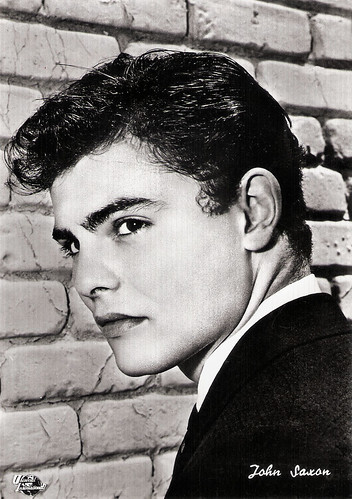
Italian postcard by Bromofoto, Milano, no. 1428. Photo: Universal International.
John Saxon worked on over 200 film and TV projects during the span of seven decades. His portrayal of a brutal Mexican bandit opposite Marlon Brando in The Appaloosa (1966) earned him a Golden Globe. The Italian-American actor played in many Italian films, mainly in Spaghetti Westerns. The rugged star also kicked around with Bruce Lee in Enter the Dragon and appeared in three Nightmare on Elm Street films for director Wes Craven. John Saxon was 83.
11 August: Trini Lopez (1933-2020)

French postcard by E.D.U.G., no. 388. Photo: Reprise / Disques Vogues.
American singer, guitarist, and actor Trini Lopez died at the age of 87. His first hit was 'If I Had a Hammer' in 1963, which earned him a Golden Disc. His other hits included 'Lemon Tree', 'I'm Comin' Home, Cindy' and 'La Bamba'. He appeared in several films and designed two guitars for the Gibson Guitar Corporation, which are now collectors’ items.
11 August: Anneliese Kaplan (1933-2020)
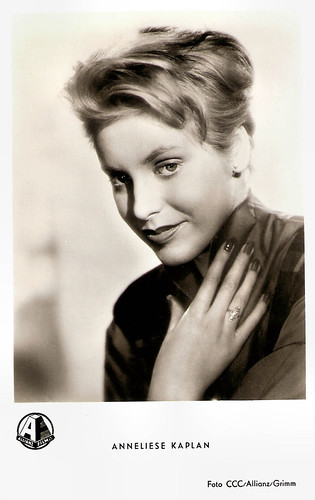
West-German postcard by Kunst und Bild, Berlin, no. A 1054. Photo: CCC / Allianz / Grimm. Anneliese Kaplan in Der Raub der Sabinerinnen/The Robbery of the Sabine Women (Kurt Hoffmann, 1954).
German actress Anneliese Kaplan played supporting parts in several films during the 1950s. Kaplan was married to the prolific film composer Martin Böttcher. She was 87.
23 August: Lori Nelson (1933-2020)
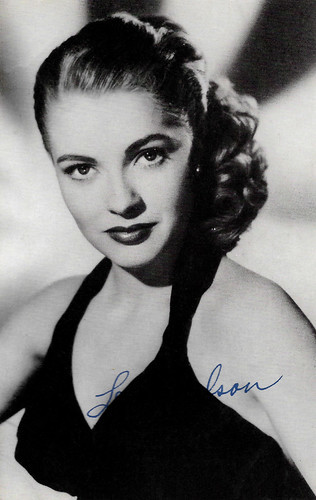
British postcard in the Celebrity Autograph Series by L.D. Ltd., London, no. 165. Photo: Universal-International.
Beautiful blonde American actress and former model Lori Nelson started acting at the age of 2 and she was Miss Encino at age 17. Nelson played the lead in several Universal films of the 1950s and is best known for her roles in B-films like the 3D fantasy Revenge of the Creature (1955) and Day the World Ended (1955). After several years at Universal, she freelanced in films and TV. She was 87.
4 September: Annie Cordy (1928-2020)
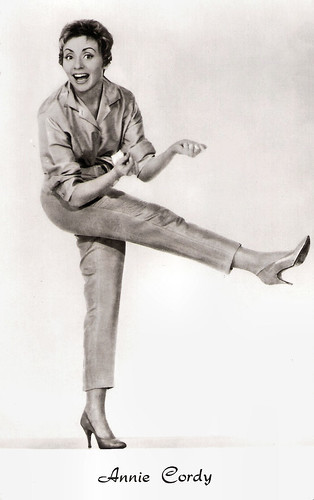
Dutch postcard by Gebr. Spanjersberg N.V., Rotterdam, no. 5724.
Belgian actress and singer Annie Cordy was an energetic and zany performer. She starred in more than 30 French film operettas, comedies, and dramas. Cordy made over 300 records, and did 4000 live appearances worldwide, including several memorable concerts at Paris’ most famous venue, L’Olympia. She was 92.
6 September: Anita Lindblom (1937-2020)

German postcard by Krüger, no. 902/31. Photo: Fontana.
Gorgeous Anita Lindblom was an iconic Swedish singer and actress, who starred in several Swedish entertainment films. She was one of Sweden’s and Germany’s most popular pop artists of the 1960s. Her hit 'Sånt är livet' (That's life) (1961) is an evergreen in Scandinavia. Lindblom died in Mandelieu-La Napoule, France, where she had been living since 1969.
10 September: Diana Rigg (1938-2020)

German postcard by Ludw. Povel & Co, Nordhorn.
Dame Diana Rigg was well known as Emma Peel in the classic TV series The Avengers (1965-1968), and later as Lady Olenna Tyrell in Game of Thrones (2013-2017). In between, the English actress had an extensive career in film and theatre. Between 1959 and 1964, she performed for the Royal Shakespeare Company and won several awards, including a Tony and an Emmy award. In the cinema, she made her mark as Countess Teresa di Vicenzo, the only Bond girl to ever get 007 to the altar, in On Her Majesty's Secret Service (1969). Diana Rigg was 82.
21 September: Michael Lonsdale (1931-2020)
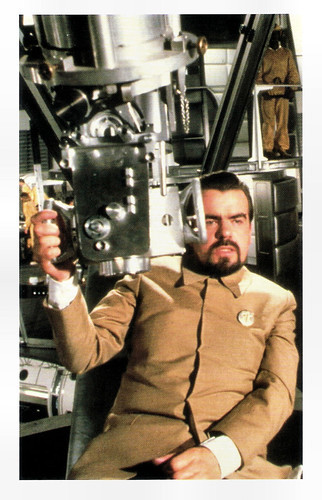
British postcard by Danjaqand United Artists Corporation. Photo: Eon Productions / Danjaq S.A. Michael Lonsdale in Moonraker (Lewis Gilbert, 1979).
French actor Michael Lonsdale (1931), sometimes billed as Michel Lonsdale, is best known for his role as the villainous Sir Hugo Drax in the James Bond film Moonraker (1979). His other acclaimed films include Day of the Jackal (1973) with Edward Fox, Luis Bunuel's Le fantôme de la liberté (1974), The Name of the Rose (1986) with Sean Connery, and Steven Spielberg's Munich (2005) with Daniel Craig and Mathieu Amalric. In a career lasting over fifty years, Lonsdale appeared in over 200 international films and television shows. Michael Lonsdale was 89.
23 September: Juliette Gréco (1927-2020)
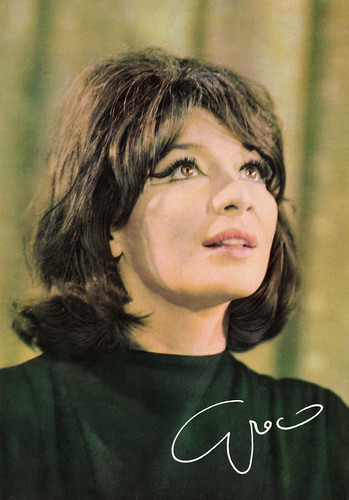
Big East-German card by VEB Lied der Zeit, Berlin, 1969. Photo: Helmut Raddatz.
French actress and chanson singer Juliette Gréco was the muse of the existentialists such as Jean-Paul Sartre. Later she became the protégée of film mogul Darryl F. Zanuck, who cast her in his films. She was 93.
14 October: Rhonda Fleming (1923-2020)
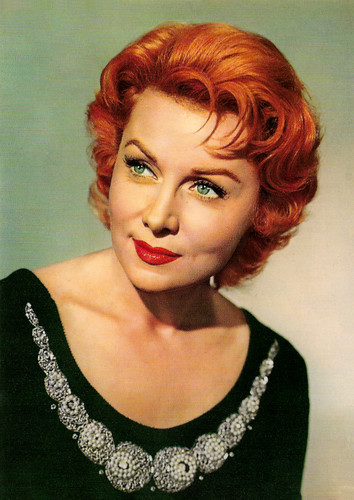
Italian postcard by Rotalcolor / Rotalfoto, Milano, no. N. 58.
American film and television actress Rhonda Fleming (1923-2020) was the 'Queen of Technicolor'. She acted in more than forty films, mostly in the 1940s and 1950s, and worked with directors such as Alfred Hitchcock on Spellbound (1945), Robert Siodmak on The Spiral Staircase (1946), Jacques Tourneur on Out of the Past (1947), and Fritz Lang on While the City Sleeps (1956). She became renowned as one of the most beautiful and glamorous actresses of her day. Rhonda Fleming was 97.
20 October: Irina Skobtseva (1927-2020)
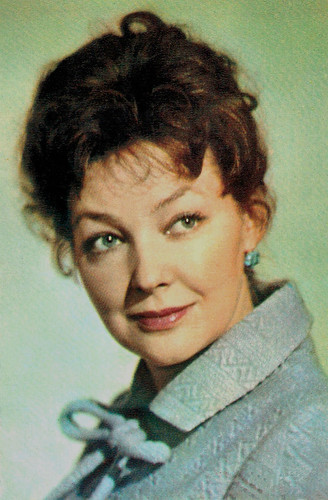
Soviet postcard by Izdanie Bjuro Propagandy Sovetskogo Kinoiskusstva, no. A05978, 1968. The card was issued in 300,000 copies. Retail price: 8 Kop.
Russian actress Irina Skobtseva (1927) was a famous star of the Soviet cinema. She was the second wife of Sergei Bondarchuk and played Helen Kuragina in his epic film Voyna i mir/War and Peace (1966), a powerful adaptation of the eponymous masterpiece by Leo Tolstoy. Skobtseva was 93.
21 October: Marge Champion (1919-2020)
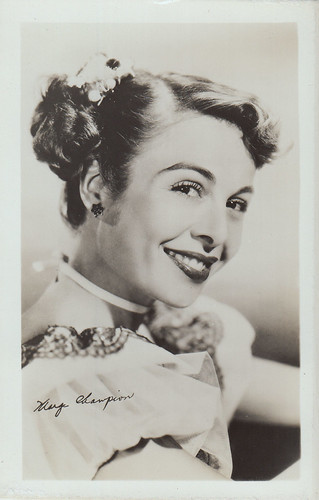
American vintage postcard. Collection: Marlene Pilaete.
Marge Champion was an American dancer and actress. At 14, she was hired as a dance model for Walt Disney's for Snow White and the Seven Dwarfs (1937). Later, Champion formed a highly successfully dancing team with her husband Gower Champion in many MGM musicals of the 1950s, and in their own TV series. She also became a well-known choreographer. Marge Champion was 101.
31 October 2020: Sean Connery (1930-2020)
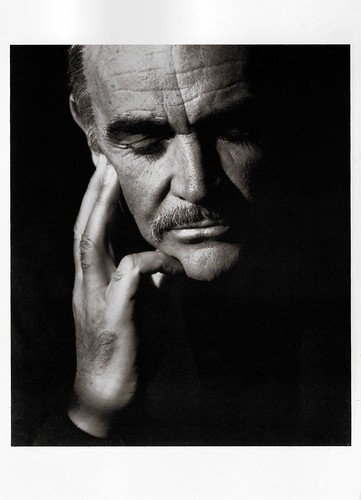
American postcard by Fotofolio, New York, N.Y., no. HR 62. Photo: Herb Ritts. Caption: Sean Connery, Hollywood, 1989.
Scottish superstar Sean Connery was the original secret agent 007, starring in seven James Bond films between 1962 and 1983. His film career also included such notable films as Marnie (1964), The Name of the Rose (1986), The Untouchables (1987), and Indiana Jones and the Last Crusade (1989). Connery won an Academy Award, a Golden Globe, and also a BAFTA Award. He was 90.
26 November: Flor Silvestre (1930-2020)
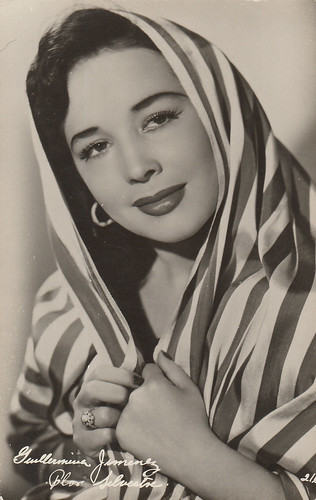
Mexican postcard by Sello, no. 216. Collection: Marlene Pilaete.
Mexican singer and actress Flor Silvestre was one of the most prominent and successful performers of Mexican and Latin American music and was a star of classic Mexican films. Famous for her melodious voice and unique singing style, she was nicknamed "La Sentimental" (The Sentimental One) and "La Voz Que Acaricia" (The Voice That Caresses). Her more than 70-year career included stage productions, radio programs, records, films, television programs, comics, and rodeo shows.
2 December: Pamela Tiffin (1942-2020)
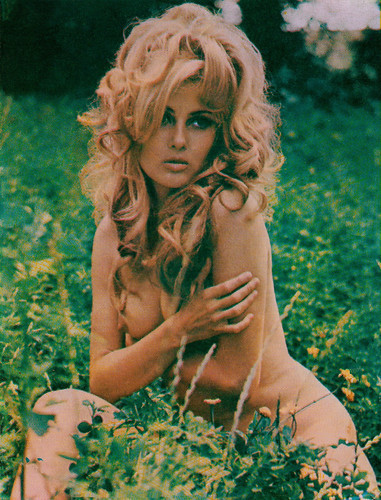
Yugoslavian postcard by Cik-Razglednica. Photo: Paolo Costa / Playboy, 1969.
American actress Pamela Tiffin was a gorgeous and popular starlet of the 1960s. She was discovered by an associate of Hal B. Wallis in the Paramount commissary and made memorable turns in such films as One, Two, Three (1961), State Fair (1962), The Hallelujah Trail (1965), and Harper (1966). She later starred in many Italian films. Pamela Tiffin was 78 when she died in a Manhattan hospital.
5 december: Ildikó Pécsi (1940–2020)
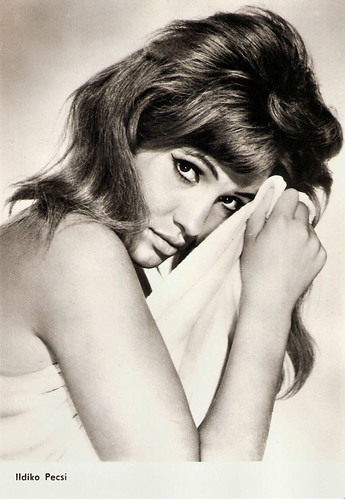
East-German postcard by VEB Progress Film-Vertrieb, Berlin, no. 2.539, 1966. Retail price: 0,290 MDN. Photo: Hungarofilm. Ildikó Pécsi in Mit csinált Felséged 3-tól 5-ig?/Where Was Your Majesty Between 3 and 5 (Károly Makk, 1964).
Hungarian actress Ildikó Pécsi (1940-2020) passed away on 5 December. Between 1961 and 2015, she appeared in ca. 150 films and TV productions. She was 80.
10 December: Barbara Windsor (1937-2020)
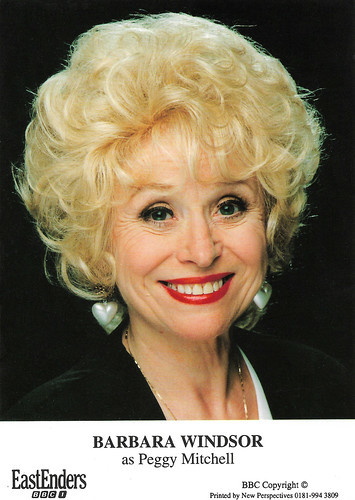
British postcard by new Perspectives. Photo: BBC. Barbara Windsor as Peggy Mitchell in the TV series Eastenders (1994-2016).
Dame Barbara Windsor, DBE passed away on 10 December. The English actress made her film debut as a schoolgirl in The Belles of St. Trinian's (1954). She was known for her appearances in the Carry On films and for playing Peggy Mitchell in the BBC soap opera EastEnders. She joined the cast of EastEnders in 1994 and won the 1999 British Soap Award for Best Actress, before ultimately leaving the show in 2016 when her character was killed off.
15 December: Caroline Cellier (1945-2020)
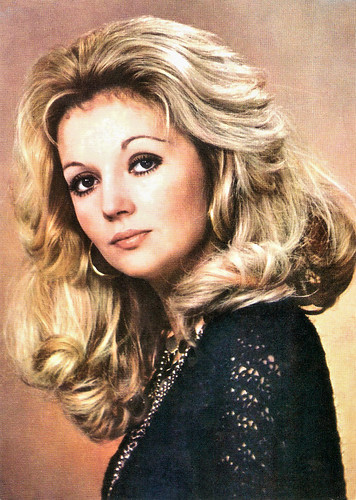
Romanian postcard by Casa Filmului Acin.
On 15 December 2020, French actress Caroline Cellier has passed away. She appeared in such films as Claude Lelouch's La vie, l'amour, la mort/Life Love Death (1969), Claude Chabrol's thriller Que la bête meure/The Beast Must Die (1969), and L'année des méduses/Year of the Jellyfish (1984), for which she won the César Award for Best Supporting Actress. She was married to actor Jean Poiret and their son Nicolas (1978) became a screenwriter. She was 75.
31 December: Robert Hossein (1927-2020)
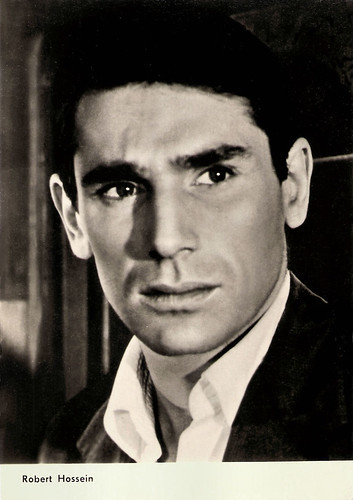
East-German postcard by VEB Progress Film-Vertrieb, Berlin, no. 1840, 1963. Robert Hossein in La liberté surveillée/Provisional Liberty (Henri Aisner, Vladimír Vlcek, 1958).
On New Year’s Eve, 31 December 2020, French film actor, director, and writer Robert Hossein (1927) has passed. He was generally cast as a tough guy beside gorgeous actresses such as Brigitte Bardot, Sophia Loren, and Marina Vlady. Hossein is most famous though as Michèle Mercier's husband in the wildly popular Angélique film series of the 1960s. He died, one day after his 93rd birthday, of complications from COVID-19.
May you all rest in peace.
31 December 2019: Milan Beli (1931-2019)

East-German postcard by VEB Progress Film-Vertrieb, Berlin, no. 42/72. Photo: Schütz / DEFA. Milan Beli in Tecumseh (Hans Kratzert, 1972).
Serbian actor Milan Beli or Milan Bosiljcic passed away on the last day of 2019, at the age of 88. He was best known as the villain in such East-German films as the Eastern Tecumseh (1972), Das Licht auf dem Galgen (1976), and Das Ding im Schloß (1979). He appeared in more than 50 European films.
12 January 2020: Aart Staartjes (1938-2020)

Dutch postcard by Vara. Photo: Fotoatelier Nederlandse Omroep Stichting. Joost Prinssen as Erik Engerd (Eerie Eric), Wieteke van Dort as Deftige Dame (Posh Lady) and Aart Staartjes as Stratemaker op zee (Bricklayer at sea), in De Stratemaker op zee show/The bricklayer at sea show" (Frans Boelen, Aart Staartjes, 1972).
Dutch actor and TV icon Aart Staartjes is known in The Netherlands for such innovative children's TV classics as De stratenmaker op zee show/The bricklayer at sea show" (1972), De film van ome Willem (1974), J.J. de Bom voorheen: 'De kindervriend' (1979) and the Dutch version of Sesame Street, Sesamstraat. On 10 January, Staartjes was involved in a collision between a car and a quadricycle in Leeuwarden. He was taken to the hospital in critical condition and died two days later. Aart Staartjes was 81 years old.
28 January: Monique Van Vooren (1927-2020)

French postcard by De Marchi Frères, Marseille. Photo: Bernard of Hollywood.
Belgian-born model, singer, and actress Monique Van Vooren gained notoriety for her many celebrity appearances on the game and variety show circuit in the 1950s and 1960s. She became a cult star, best remembered for her role as Baroness Katrin Frankenstein in Flesh for Frankenstein (1973).
5 February: Kirk Douglas (1916-2020)

Spanish postcard by Archivo Bermejo, no. 7143. Photo: Universal International, 1960. Kirk Douglas in Spartacus (Stanley Kubrick, 1960).
Cleft-chinned and steely-eyed American superstar Kirk Douglas passed away in Los Angeles, at the age of 103. The legendary actor, producer, and director made his film debut in The Strange Love of Martha Ivers (1946) with Barbara Stanwyck. Douglas soon developed into a leading box-office star throughout the 1950s, known for serious dramas, Westerns, and war films. Our favourites are the two classics he made with Stanley Kubrick, Paths of Glory (1957), and Spartacus (1960). During his long career, he appeared in more than 90 films.
17 February: Sonja Ziemann (1926-2020)

German postcard by Film und Bild, Frankfurt-Main. Photo: Gaza-Studio.
German film and television actress, singer, and dancer Sonja Ziemann passed away at the age of 94. The delicately lovely, dark-haired, and innocent-looking Ziemann was one of the first stars of Germany's post-war cinema. She starred in film operettas and Heimatfilms as Schwarzwaldmädel/The Black Forest Girl (1950) and Grün ist die Heide/The Heath is Green (1951). Her private life knew several tragedies.
24 February: Baby Peggy (1918-2020)

German postcard by Ross Verlag, Berlin, no. 550/2, 1919-1924. Photo: Unifilman.
One of the last superstars of the silent film era died in 2020. Diana Serra Cary (1918), best known as Baby Peggy passed away in Gustine, California. She was one of the three major American child stars of the Hollywood silent movie era along with Jackie Coogan and Baby Marie. She spent decades coming to terms with a bizarre childhood of triumphs, heartbreaks, and parents who squandered her fortune. Diana Serra Cary was 101.
27 February: Burkhard Driest (1939-2020)

German autograph card.
German actor, writer, and director Burkhard Driest was known for his roles in Sam Peckinpah's Cross of Iron (1977) and Rainer Werner Fassbinder's Querelle (1980), but in Germany, he was best known as a former bank-robber. Hyper-virile, tall, square-shouldered, and rough-faced, he was one of Germany's favourite bad guys.
15 March: Suzy Delair (1917-2020)

French postcard by Editions P.I., offered by Les Carbones Korès, no. 121. Photo: Lucienne Chevert. Publicity still for Quai des Orfèvres (Henri-Georges Clouzot, 1947).
Vivacious French actress and singer Suzy Delair starred in many different films and was also famous in France as a singer of songs like Avec son Tra-la-la. For several years, the saucy star was the companion of film director Henri-Georges Clouzot, in whose films of the 1940s she appeared, including the masterpiece Quai des Orfèvres/Quay of the Goldsmiths (1947). La Delair was 102.
23 March: Lucia Bosé (1931-2020)

Italian postcard by Bromofoto, Milano, no. 270.
Italian actress Lucia Bosé passed away in Brieva, Spain. She died of pneumonia caused by the coronavirus (COVID-19). Bosé was famous for her films from the 1950s with a.o. Giuseppe De Santis and Michelangelo Antonioni. In the same years and after, she also worked with other famous directors such as Juan Bardem, Luis Buñuel, the Taviani brothers, Liliane Cavani, Francesco Rosi, and Ferzan Özpetek. Lucia Bosé was 89.
24 March: Albert Uderzo (1927-2020)

French postcard by Franceco, Paris, no. 0963013. Image: Editions Albert Rene / Goscinny / Uderzo, 1984. Caption: Goscinny-Uderzo, Le chaudron vide. (The empty cauldron).
The French comic book artist and scriptwriter Albert Uderzo was best known for his work on Astérix. At the age of 92, he died in his sleep at his home in Neuilly from a heart attack unrelated to the coronavirus. Astérix has also become a major film franchise, both in animated and live-action form. Most notable is the feature Astérix & Obélix contre César/Asterix & Obelix Take on Caesar (Claude Zidi, 1999), starring Christian Clavier, Gerard Depardieu, and Roberto Benigni.
25 March: Liesbeth List (1941-2020)

West-German autograph card, 1967. Photo: Philips.
Dutch singer and actress Liesbeth List (1941) was known as the Grande Dame of the Dutch chanson, thanks to songs like 'Pastorale', 'Aan de andere kant van de heuvels' (On the other side of the hills), and 'Kinderen een kwartje' (Children a quarter). She became popular during the 1960s and frequently collaborated with Ramses Shaffy. List sang Jacques Brel's chansons in a Dutch translation, and also acted in a few Dutch films. Liesbeth List was 78.
28 March: Barbara Rütting (1927-2020)

East-German postcard by VEB Progress Film-Vertrieb, Berlin, no. 172/70, 1970. Photo: Progress. Barbara Rütting in Neues vom Hexer/Again the Ringer (Alfred Vohrer, 1965).
German film actress, politician and author Barbara Rütting appeared in 50 films between 1952 and 1983. She was a star of German cinema in the 1950s and 1960s, appearing in Canaris (1954) with O. E. Hasse and in Die Letzte Brücke/The Last Bridge (1954) with Maria Schell. In 1961, she played the female lead as a journalist in the American-German film Town Without Pity (1961), co-starring Kirk Douglas and Christine Kaufmann. Later she became a well-known human rights and animal welfare activist, and a politician for The Greens.
6 April: Honor Blackman (1925-2020)

British autograph card.
British actress Honor Blackman was best known for playing the Bond girl Pussy Galore opposite Sean Connery in Goldfinger (1964). Blackman became a household name in the 1960s as Cathy Gale in The Avengers in which she showed an extraordinary combination of beauty, brains, and physical prowess. After a career spanning eight decades, she died of natural causes unrelated to coronavirus, at the age of 94.
16 April: Christophe (1945-2020)

Vintage postcard.
French Chanson singer and composer Christophe (1945) a.k.a. Daniel Bevilacqua became famous in the early 1960s with his hits 'Aline' and 'Oh!... Mon Amour' which he sang in French and Italian. He died of complications by the Coronavirus at the age of 74.
22 April: Shirley Knight (1936-2020)

Dutch postcard. Collection: Marlene Pilaete.
American actress Shirley Knight appeared in more than 50 feature films, television films, television series, and Broadway and Off-Broadway productions in her career, playing leading and character roles. Knight was nominated twice for the Oscar for Best Supporting Actress: for The Dark at the Top of the Stairs (1960) and Sweet Bird of Youth (1962). She received the Volpi Cup for Best Actress for her role in the British film Dutchman (1966). In 1976, Knight won a Tony for 'Kennedy's Children', a play by Robert Patrick. Knight was also nominated eight times for an Emmy (winning three), and she received a Golden Globe.
2 May: John Ericson (1926-2020)

Dutch postcard by Takken, Utrecht, no. 709. Photo: Metro-Goldwyn-Mayer (MGM). John Ericson and Pier Angeli in Teresa (Fred Zinnemann, 1951).
In the 1950s, John Ericson (1926-2020) was a young an promising star with wavy-haired good looks and an athletic build who made a series of films for MGM, including Teresa (1951) and The Student Prince (1954). Later, the German-American actor worked mostly for television, most memorably as the partner of Anne Francis in Honey West (1965-1966). He was 93.
9 May: Little Richard (1932-2020)

Dutch postcard by Uitg. Int. Filmpers (I.F.P.), Amsterdam, no. 1525. Little Richard performs with his band as his saxophone player Grady Gaines stands on the piano in Mister Rock And Roll (Charles S. Dubin, 1957).
American pianist-singer Little Richard was one of the first crossover black artists, reaching audiences of all races. In the mid-1950s, his dynamic songs like 'Tutti Frutti' and 'Good Golly Miss Molly' and his charismatic showmanship laid the foundation for rock and roll. Little Richard was 87.
12 May: Michel Piccoli (1925-2020)

Big East-German collectors card by Progress Film-Verleih, Berlin, no. 31/83, 1983.
Michel Piccoli , one of the most original and versatile French actors of the last half-century, died aged 94. He appeared in many different roles, from seducer to cop to a gangster to Pope in more than 200 films and TV films. Among the directors he worked with are Jean Renoir, Jean-Pierre Melville, Jean-Luc Godard, Agnès Varda, Luis Buñuel, and Alfred Hitchcock.
26 May: Irm Hermann (1942-2020)

German postcard by Franz Josef Rüdel, Filmpostkartenverlag, Hamburg. Photo: Margarete Redl-von Peinen.
German actress and assistant director Irm Hermann passed away in Berlin after a short illness. She was the muse and a close friend of Rainer Werner Fassbinder and played roles in 24 of his films including Die bitteren Tränen der Petra von Kant (1972). Overall, she appeared in over 160 film and television productions until 2018. Irm Hermann was 77.
18 June: Vera Lynn (1917-2020)

Dutch postcard by Takken, Utrecht, no. AX 5267. Photo: M.G.M. Promotional picture for her L.P. 'Hits of the blitz'.
Dame Vera Lynn, known as 'the Forces' Sweetheart', passed away at the age of 103. Lynn was a British singer of traditional popular music, songwriter, and actress, whose musical recordings and performances were enormously popular during the Second World War. The songs most associated with her are 'We'll Meet Again', 'The White Cliffs of Dover', 'A Nightingale Sang in Berkeley Square' and 'There'll Always Be an England'. She remained popular after the war, appearing on radio and television internationally and recording such hits as 'Auf Wiederseh'n Sweetheart' and 'My Son, My Son'.
18 June: Claus Biederstaedt (1928-2020)

German postcard by WS-Druck, no. F 2. Photo: Ringpress / Vogelmann / Bavaria.
German actor Claus Biederstaedt passed away at the age of 91. He was a typical 'sonny boy', the nice & friendly star of the Wirtschaftswunder cinema of the 1950s. With his twinkling eyes, he was the charming and funny young man in many German-language comedies and melodramas and even in some war films.
27 June: Linda Cristal (1934-2020)

Italian postcard by Rotalcolor, Milano, no. 115.
Argentine-American actress Linda Cristal passed away in her sleep in Beverly Hills. She appeared in a number of Westerns during the 1950s, before winning a Golden Globe Award for her performance in the comedy The Perfect Furlough (1958). From 1967 to 1971, Cristal starred as Victoria Cannon in the popular TV series The High Chaparral, for which she won a Golden Globe Award in 1968. Linda Cristal was 86.
2 July: Tilo Prückner (1940-2020)

German postcard by Franz Josef Rüdel, Filmpostkartenverlag, Hamburg. Photo: Volker Kimstädt.
The career of German television and film actor Tilo Prückner spanned five decades and more than 100 films. Prückner died of sudden heart failure in Berlin at the age of 79.
6 July: Ennio Morricone (1928-2020)

Italian postcard by Cineteca Bologna, 2007. Photo: A. Novi / Cineteca di Bologna. Claudia Cardinale in C'era una volta il West/Once Upon a Time in the West (Sergio Leone, 1968).
Italian film composer Ennio Morricone was a classmate of director Sergio Leone with whom he would form one of the great director/composer partnerships, right up there with Eisenstein & Prokofiev, Hitchcock & Herrmann, Fellini & Rota. Our favourite Morricone music is his score for C'era una volta il West/Once Upon a Time in the West (Sergio Leone, 1968). He has written nearly 400 film scores. Morricone died in the aftermath of a fall. He was 92.
17 July: Zizi Jeanmaire (1924-2020)

French postcard by Editions P.I., Paris, no. 797. Photo: Sam Lévin.
Glamorous ballet dancer and film star Zizi Jeanmaire passed away in Tolochenaz, Switzerland. She became famous in the 1950s after playing the title role in the ballet version of 'Carmen', produced in London in 1949. She went on to appear in films in France and Hollywood. She was the widow of dancer and choreographer Roland Petit, one of the major creative forces in ballet during the 1940s and 1950s. Zizi Jeanmaire was 96.
25 July: Olivia de Havilland (1916-2020)

Belgian postcard by Victoria, Brussels, no. 639/24. Photo: Paramount.
Olivia de Havilland (1916), passed away in her hometown Paris. The Japanese-born British-American former actress had a career that spanned from 1935 to 1988. She appeared in 49 feature films and was one of the leading stars during the golden age of Classical Hollywood. She is best known for her early screen performances in The Adventures of Robin Hood (1938) and Gone with the Wind (1939), and her later award-winning performances in To Each His Own (1946), The Snake Pit (1948), and The Heiress (1949). Olivia de Havilland was 104!
25 July: John Saxon (1935-2020)

Italian postcard by Bromofoto, Milano, no. 1428. Photo: Universal International.
John Saxon worked on over 200 film and TV projects during the span of seven decades. His portrayal of a brutal Mexican bandit opposite Marlon Brando in The Appaloosa (1966) earned him a Golden Globe. The Italian-American actor played in many Italian films, mainly in Spaghetti Westerns. The rugged star also kicked around with Bruce Lee in Enter the Dragon and appeared in three Nightmare on Elm Street films for director Wes Craven. John Saxon was 83.
11 August: Trini Lopez (1933-2020)

French postcard by E.D.U.G., no. 388. Photo: Reprise / Disques Vogues.
American singer, guitarist, and actor Trini Lopez died at the age of 87. His first hit was 'If I Had a Hammer' in 1963, which earned him a Golden Disc. His other hits included 'Lemon Tree', 'I'm Comin' Home, Cindy' and 'La Bamba'. He appeared in several films and designed two guitars for the Gibson Guitar Corporation, which are now collectors’ items.
11 August: Anneliese Kaplan (1933-2020)

West-German postcard by Kunst und Bild, Berlin, no. A 1054. Photo: CCC / Allianz / Grimm. Anneliese Kaplan in Der Raub der Sabinerinnen/The Robbery of the Sabine Women (Kurt Hoffmann, 1954).
German actress Anneliese Kaplan played supporting parts in several films during the 1950s. Kaplan was married to the prolific film composer Martin Böttcher. She was 87.
23 August: Lori Nelson (1933-2020)

British postcard in the Celebrity Autograph Series by L.D. Ltd., London, no. 165. Photo: Universal-International.
Beautiful blonde American actress and former model Lori Nelson started acting at the age of 2 and she was Miss Encino at age 17. Nelson played the lead in several Universal films of the 1950s and is best known for her roles in B-films like the 3D fantasy Revenge of the Creature (1955) and Day the World Ended (1955). After several years at Universal, she freelanced in films and TV. She was 87.
4 September: Annie Cordy (1928-2020)

Dutch postcard by Gebr. Spanjersberg N.V., Rotterdam, no. 5724.
Belgian actress and singer Annie Cordy was an energetic and zany performer. She starred in more than 30 French film operettas, comedies, and dramas. Cordy made over 300 records, and did 4000 live appearances worldwide, including several memorable concerts at Paris’ most famous venue, L’Olympia. She was 92.
6 September: Anita Lindblom (1937-2020)

German postcard by Krüger, no. 902/31. Photo: Fontana.
Gorgeous Anita Lindblom was an iconic Swedish singer and actress, who starred in several Swedish entertainment films. She was one of Sweden’s and Germany’s most popular pop artists of the 1960s. Her hit 'Sånt är livet' (That's life) (1961) is an evergreen in Scandinavia. Lindblom died in Mandelieu-La Napoule, France, where she had been living since 1969.
10 September: Diana Rigg (1938-2020)

German postcard by Ludw. Povel & Co, Nordhorn.
Dame Diana Rigg was well known as Emma Peel in the classic TV series The Avengers (1965-1968), and later as Lady Olenna Tyrell in Game of Thrones (2013-2017). In between, the English actress had an extensive career in film and theatre. Between 1959 and 1964, she performed for the Royal Shakespeare Company and won several awards, including a Tony and an Emmy award. In the cinema, she made her mark as Countess Teresa di Vicenzo, the only Bond girl to ever get 007 to the altar, in On Her Majesty's Secret Service (1969). Diana Rigg was 82.
21 September: Michael Lonsdale (1931-2020)

British postcard by Danjaqand United Artists Corporation. Photo: Eon Productions / Danjaq S.A. Michael Lonsdale in Moonraker (Lewis Gilbert, 1979).
French actor Michael Lonsdale (1931), sometimes billed as Michel Lonsdale, is best known for his role as the villainous Sir Hugo Drax in the James Bond film Moonraker (1979). His other acclaimed films include Day of the Jackal (1973) with Edward Fox, Luis Bunuel's Le fantôme de la liberté (1974), The Name of the Rose (1986) with Sean Connery, and Steven Spielberg's Munich (2005) with Daniel Craig and Mathieu Amalric. In a career lasting over fifty years, Lonsdale appeared in over 200 international films and television shows. Michael Lonsdale was 89.
23 September: Juliette Gréco (1927-2020)

Big East-German card by VEB Lied der Zeit, Berlin, 1969. Photo: Helmut Raddatz.
French actress and chanson singer Juliette Gréco was the muse of the existentialists such as Jean-Paul Sartre. Later she became the protégée of film mogul Darryl F. Zanuck, who cast her in his films. She was 93.
14 October: Rhonda Fleming (1923-2020)

Italian postcard by Rotalcolor / Rotalfoto, Milano, no. N. 58.
American film and television actress Rhonda Fleming (1923-2020) was the 'Queen of Technicolor'. She acted in more than forty films, mostly in the 1940s and 1950s, and worked with directors such as Alfred Hitchcock on Spellbound (1945), Robert Siodmak on The Spiral Staircase (1946), Jacques Tourneur on Out of the Past (1947), and Fritz Lang on While the City Sleeps (1956). She became renowned as one of the most beautiful and glamorous actresses of her day. Rhonda Fleming was 97.
20 October: Irina Skobtseva (1927-2020)

Soviet postcard by Izdanie Bjuro Propagandy Sovetskogo Kinoiskusstva, no. A05978, 1968. The card was issued in 300,000 copies. Retail price: 8 Kop.
Russian actress Irina Skobtseva (1927) was a famous star of the Soviet cinema. She was the second wife of Sergei Bondarchuk and played Helen Kuragina in his epic film Voyna i mir/War and Peace (1966), a powerful adaptation of the eponymous masterpiece by Leo Tolstoy. Skobtseva was 93.
21 October: Marge Champion (1919-2020)

American vintage postcard. Collection: Marlene Pilaete.
Marge Champion was an American dancer and actress. At 14, she was hired as a dance model for Walt Disney's for Snow White and the Seven Dwarfs (1937). Later, Champion formed a highly successfully dancing team with her husband Gower Champion in many MGM musicals of the 1950s, and in their own TV series. She also became a well-known choreographer. Marge Champion was 101.
31 October 2020: Sean Connery (1930-2020)

American postcard by Fotofolio, New York, N.Y., no. HR 62. Photo: Herb Ritts. Caption: Sean Connery, Hollywood, 1989.
Scottish superstar Sean Connery was the original secret agent 007, starring in seven James Bond films between 1962 and 1983. His film career also included such notable films as Marnie (1964), The Name of the Rose (1986), The Untouchables (1987), and Indiana Jones and the Last Crusade (1989). Connery won an Academy Award, a Golden Globe, and also a BAFTA Award. He was 90.
26 November: Flor Silvestre (1930-2020)

Mexican postcard by Sello, no. 216. Collection: Marlene Pilaete.
Mexican singer and actress Flor Silvestre was one of the most prominent and successful performers of Mexican and Latin American music and was a star of classic Mexican films. Famous for her melodious voice and unique singing style, she was nicknamed "La Sentimental" (The Sentimental One) and "La Voz Que Acaricia" (The Voice That Caresses). Her more than 70-year career included stage productions, radio programs, records, films, television programs, comics, and rodeo shows.
2 December: Pamela Tiffin (1942-2020)

Yugoslavian postcard by Cik-Razglednica. Photo: Paolo Costa / Playboy, 1969.
American actress Pamela Tiffin was a gorgeous and popular starlet of the 1960s. She was discovered by an associate of Hal B. Wallis in the Paramount commissary and made memorable turns in such films as One, Two, Three (1961), State Fair (1962), The Hallelujah Trail (1965), and Harper (1966). She later starred in many Italian films. Pamela Tiffin was 78 when she died in a Manhattan hospital.
5 december: Ildikó Pécsi (1940–2020)

East-German postcard by VEB Progress Film-Vertrieb, Berlin, no. 2.539, 1966. Retail price: 0,290 MDN. Photo: Hungarofilm. Ildikó Pécsi in Mit csinált Felséged 3-tól 5-ig?/Where Was Your Majesty Between 3 and 5 (Károly Makk, 1964).
Hungarian actress Ildikó Pécsi (1940-2020) passed away on 5 December. Between 1961 and 2015, she appeared in ca. 150 films and TV productions. She was 80.
10 December: Barbara Windsor (1937-2020)

British postcard by new Perspectives. Photo: BBC. Barbara Windsor as Peggy Mitchell in the TV series Eastenders (1994-2016).
Dame Barbara Windsor, DBE passed away on 10 December. The English actress made her film debut as a schoolgirl in The Belles of St. Trinian's (1954). She was known for her appearances in the Carry On films and for playing Peggy Mitchell in the BBC soap opera EastEnders. She joined the cast of EastEnders in 1994 and won the 1999 British Soap Award for Best Actress, before ultimately leaving the show in 2016 when her character was killed off.
15 December: Caroline Cellier (1945-2020)

Romanian postcard by Casa Filmului Acin.
On 15 December 2020, French actress Caroline Cellier has passed away. She appeared in such films as Claude Lelouch's La vie, l'amour, la mort/Life Love Death (1969), Claude Chabrol's thriller Que la bête meure/The Beast Must Die (1969), and L'année des méduses/Year of the Jellyfish (1984), for which she won the César Award for Best Supporting Actress. She was married to actor Jean Poiret and their son Nicolas (1978) became a screenwriter. She was 75.
31 December: Robert Hossein (1927-2020)

East-German postcard by VEB Progress Film-Vertrieb, Berlin, no. 1840, 1963. Robert Hossein in La liberté surveillée/Provisional Liberty (Henri Aisner, Vladimír Vlcek, 1958).
On New Year’s Eve, 31 December 2020, French film actor, director, and writer Robert Hossein (1927) has passed. He was generally cast as a tough guy beside gorgeous actresses such as Brigitte Bardot, Sophia Loren, and Marina Vlady. Hossein is most famous though as Michèle Mercier's husband in the wildly popular Angélique film series of the 1960s. He died, one day after his 93rd birthday, of complications from COVID-19.
May you all rest in peace.
Published on December 31, 2020 22:00
December 29, 2020
Victims of the Spanish Flu
As 2020 is nearing its end, and the Covid-19 pandemic reminds many of the notorious Spanish Flu which wrecked the world in 1918-1920, we thought it is apt to have a post dedicated to victims of this disaster of a century ago. While the famous silent actresses Lilian Gish and Mary Pickford survived, many less-known European and American actors and directors succumbed. Here is a selection of postcards of the victims from our collections. We wish 2021 will bring us hope, progress, and less dark times.
Gilda Langer (1896-1920)
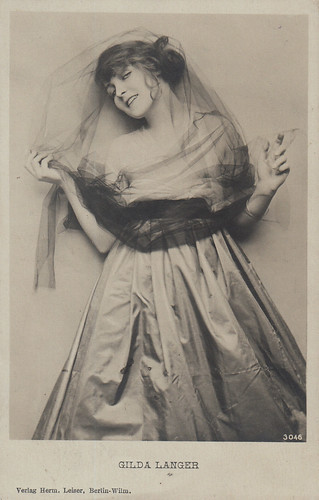
German postcard by Verlag Herm. Leiser, Berlin-Wilm., no. 3046. Collection: Marlene Pilaete.
Gilda Langer (1896-1920) was a German stage and film actress whose career began in the mid-1910s. She appeared both on stage and in silent films. She was directed by such legendary directors as Fritz Lang and Robert Wiene, but all films featuring Langer as an actress are now considered lost. In January 1920, Langer became engaged to Hungarian film director Paul Czinner. Langer fell ill with a lung infection after contracting the Spanish flu shortly after this engagement and died on 31 January 1920, aged 23.
Lia Borré (ca. 1890-1920)
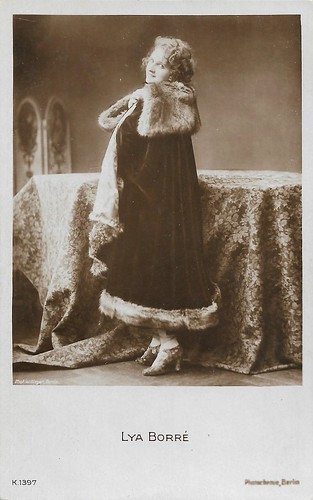
German postcard by Photochemie, no K. 1397. Photo: Willinger, Berlin.
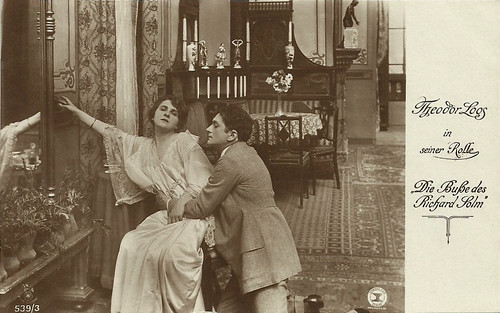
German postcard by Rotophot in the Film-Sterne series, no. 539/3. Photo: Amboß-Film Dworsky & Co. Lia Borré and Theodor Loos in Die Buße des Richard Solm (Arthur Wellin, 1918).
Lia Borré was a German silent film actress who was very active during the First World War but succumbed to the Spanish Flu in 1920.
Betty Gray (c. 1895-1919)
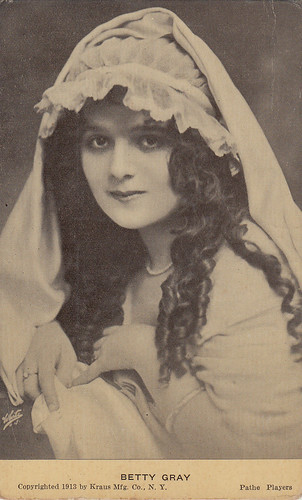
American postcard by Kraus Mfg. Company, New York, 1913. Photo: Pathé. Collection: Marlene Pilaete.
Betty Gray was an American silent film actress of Danish-Swedish descent, who peaked in the 1910s at American Pathé, Biograph, and Vitagraph. In 1919, she became a victim of the Spanish Flu, only 23 years old.
William Courtleigh Jr. (1892–1918)
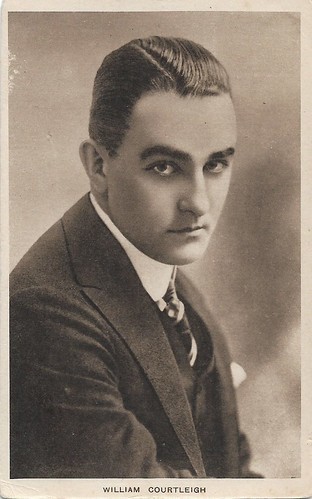
British postcard. Photo: Pathé Frères Cinema Ltd.
American silent film actor William Courtleigh Jr. appeared in at least 14 films over his brief career. He was probably best remembered for playing Neal Hardin in the - now lost - adventure serial Neal of the Navy (1915) with Lillian Lorraine, distributed by Pathé Exchange. In 1918 his career was cut short after he fell victim to the Spanish Flu pandemic.
Mogens Enger (1894-1919)
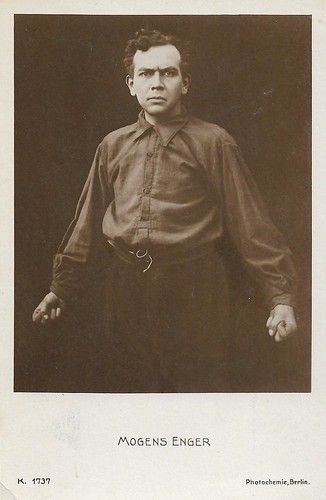
German postcard by Photochemie, Berlin, no K. 1737.
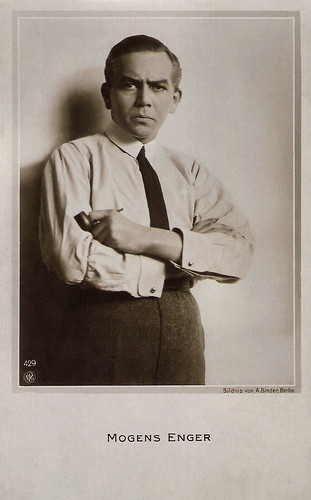
German postcard by NPG, no. 429. Photo: Alex Binder.
Mogens Enger was a Danish actor and director in German silent cinema. Between 1915 and 1918 Enger was active in the German silent cinema. As crime films were popular in Germany during the First World War, Enger would often if not always play detectives and crime police commissioners. During the shooting of Kinder der Liebe I./Children of love I. (Siegfried Dessauer, Mogens Enger, 1919), Mogens Enger died on 9 October 1918, at the age of only 24. He was a victim of the third wave of the pandemic of the Spanish Flu. Siegfried Dessauer had to finish the film.
Einar Zangenberg (1882-1918)
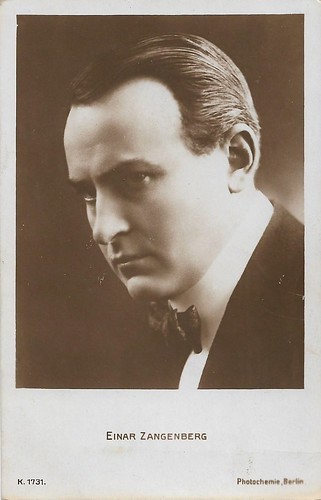
German postcard by Photochemie, no. K. 1731.
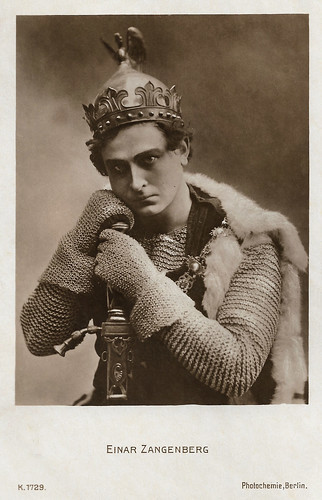
German postcard by Photochemie, no. K.1729. Zangenberg wears the same outfit as on this card. This card refers to the Norwegian play 'Dronning Margaretha' (1834) by Adam Oehlenschläger.
Einar Zangenberg was a Danish actor, film director, film producer, and a pioneer of Central European film. He died of the Spanish flu pandemic.
Louise Vale (1881-1918)
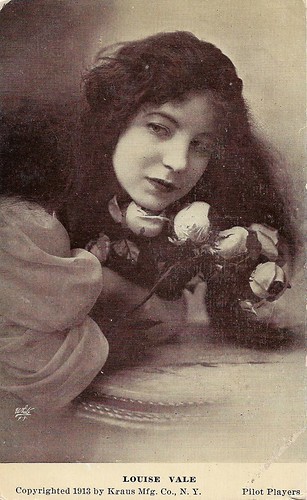
American postcard by Kraus Mfg. Co, New York, 1913. Photo: Pilot Players.
American silent-film actress Louise Vale had a relatively short career - only six years. She made her film debut in 1912 at the Rex Film Co. with The Old Organist (1912). This was followed by a handful of more short films at Rex, which were distributed by Universal. In 1913 Vale moved to the Pilot Films in Westchester, New York, where she acted under the direction of Travers Vale, whom she also married. End of 1913 the Vale couple moved to Reliance and early 1914 to Biograph, where George Morgan was Louise Vale's regular film-partner. After over 50 short films at Biograph, Louise Vale's career slowed down in 1916 and she quit Biograph, but she had now her first roles in features. She had a lead in The Sex Lure (Ivan Abramson, 1916). Louise Vale ended her career with Vengeance (Travers Vale, 1918) On 28 October, 1918, during the Spanish Flu pandemic, Vale died from pneumonia after volunteering as a waitress at the YMCA in Madison, Wisconsin, because of a shortage of help.
Gaby Deslys (1881-1920)
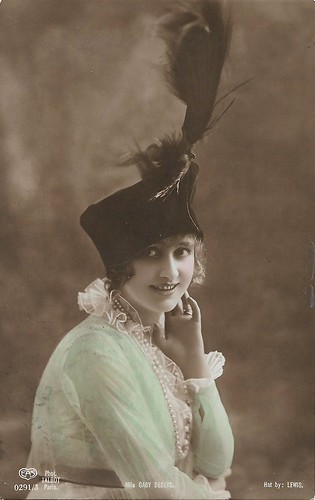
British postcard by E.A.S. (E.A. Schwerdtfeger & Co.), Paris, no. 0291-3. Photo: Talbot. Hat by Lewis. In 1913-1914, Schwerdtfeger did a whole series of coloured postcards of photo portraits of Gaby Deslys by Talbot. These were hand-coloured matte bromide postcard prints. The National Portrait Gallery in London shows them on their site. This card is one of them.
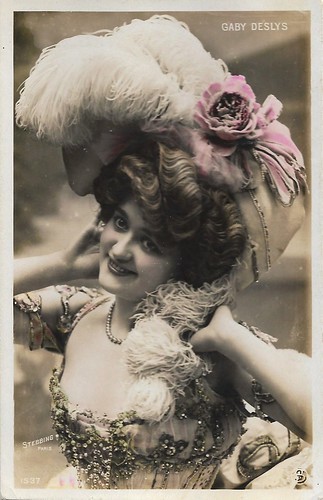
French postcard by S.I.P. (Société Industrielle de Photographie), no. 1537. Photo: Stebbing, Paris.
French dancer and actress Gaby Deslys (aka Gaby Delys) was an internationally celebrated - and notorious - star of the early 20th Century. She was famous for her extravagant clothes, jewels, and millinery. She had many admirers, most notably King Manuel II of Portugal, and during World War I, she reportedly worked as a spy for the French government. Before her tragic early death in 1920, she also made a series of silent films. Deslys contracted a severe throat infection caused by influenza in 1919. She was operated on multiple times in an effort to eradicate the infection, on two occasions without the use of an anaesthetic, but she died in Paris in February 1920 at the age of 38.
Vera Kholodnaya (1893-1919)
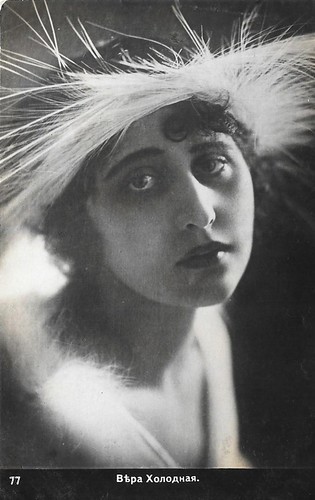
Russian postcard, no. 77. Collection: Didier Hanson.
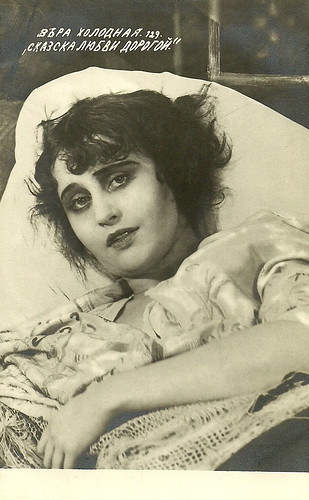
Russian postcard. Collection: Didier Hanson.
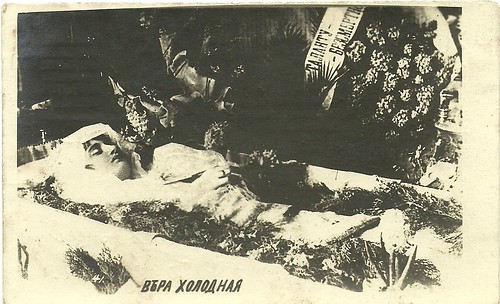
Russian postcard. Collection: Didier Hanson. Vera Kholodnaya on her deathbed.
Vera Kholodnaya was the first star of Russian silent cinema. Only 26, the ‘Queen of Screen’ died of the Spanish flu during the pandemic of 1919. Her husband, Vladimir Kholodny, died 2 months after her. Her mother, Yekaterina Sleptsova, also died shortly after her. Although Vera worked only three years for the cinema, she must have made between fifty and a hundred short films. In 1924, the Soviet authorities ordered to destroy Kholodnaya's films, and only five of her films still exist.
See also this list at IMDb for people associated with the arts (film, theater, literature, etc.) who died during the 1918-1920 Influenza pandemic.
Gilda Langer (1896-1920)

German postcard by Verlag Herm. Leiser, Berlin-Wilm., no. 3046. Collection: Marlene Pilaete.
Gilda Langer (1896-1920) was a German stage and film actress whose career began in the mid-1910s. She appeared both on stage and in silent films. She was directed by such legendary directors as Fritz Lang and Robert Wiene, but all films featuring Langer as an actress are now considered lost. In January 1920, Langer became engaged to Hungarian film director Paul Czinner. Langer fell ill with a lung infection after contracting the Spanish flu shortly after this engagement and died on 31 January 1920, aged 23.
Lia Borré (ca. 1890-1920)

German postcard by Photochemie, no K. 1397. Photo: Willinger, Berlin.

German postcard by Rotophot in the Film-Sterne series, no. 539/3. Photo: Amboß-Film Dworsky & Co. Lia Borré and Theodor Loos in Die Buße des Richard Solm (Arthur Wellin, 1918).
Lia Borré was a German silent film actress who was very active during the First World War but succumbed to the Spanish Flu in 1920.
Betty Gray (c. 1895-1919)

American postcard by Kraus Mfg. Company, New York, 1913. Photo: Pathé. Collection: Marlene Pilaete.
Betty Gray was an American silent film actress of Danish-Swedish descent, who peaked in the 1910s at American Pathé, Biograph, and Vitagraph. In 1919, she became a victim of the Spanish Flu, only 23 years old.
William Courtleigh Jr. (1892–1918)

British postcard. Photo: Pathé Frères Cinema Ltd.
American silent film actor William Courtleigh Jr. appeared in at least 14 films over his brief career. He was probably best remembered for playing Neal Hardin in the - now lost - adventure serial Neal of the Navy (1915) with Lillian Lorraine, distributed by Pathé Exchange. In 1918 his career was cut short after he fell victim to the Spanish Flu pandemic.
Mogens Enger (1894-1919)

German postcard by Photochemie, Berlin, no K. 1737.

German postcard by NPG, no. 429. Photo: Alex Binder.
Mogens Enger was a Danish actor and director in German silent cinema. Between 1915 and 1918 Enger was active in the German silent cinema. As crime films were popular in Germany during the First World War, Enger would often if not always play detectives and crime police commissioners. During the shooting of Kinder der Liebe I./Children of love I. (Siegfried Dessauer, Mogens Enger, 1919), Mogens Enger died on 9 October 1918, at the age of only 24. He was a victim of the third wave of the pandemic of the Spanish Flu. Siegfried Dessauer had to finish the film.
Einar Zangenberg (1882-1918)

German postcard by Photochemie, no. K. 1731.

German postcard by Photochemie, no. K.1729. Zangenberg wears the same outfit as on this card. This card refers to the Norwegian play 'Dronning Margaretha' (1834) by Adam Oehlenschläger.
Einar Zangenberg was a Danish actor, film director, film producer, and a pioneer of Central European film. He died of the Spanish flu pandemic.
Louise Vale (1881-1918)

American postcard by Kraus Mfg. Co, New York, 1913. Photo: Pilot Players.
American silent-film actress Louise Vale had a relatively short career - only six years. She made her film debut in 1912 at the Rex Film Co. with The Old Organist (1912). This was followed by a handful of more short films at Rex, which were distributed by Universal. In 1913 Vale moved to the Pilot Films in Westchester, New York, where she acted under the direction of Travers Vale, whom she also married. End of 1913 the Vale couple moved to Reliance and early 1914 to Biograph, where George Morgan was Louise Vale's regular film-partner. After over 50 short films at Biograph, Louise Vale's career slowed down in 1916 and she quit Biograph, but she had now her first roles in features. She had a lead in The Sex Lure (Ivan Abramson, 1916). Louise Vale ended her career with Vengeance (Travers Vale, 1918) On 28 October, 1918, during the Spanish Flu pandemic, Vale died from pneumonia after volunteering as a waitress at the YMCA in Madison, Wisconsin, because of a shortage of help.
Gaby Deslys (1881-1920)

British postcard by E.A.S. (E.A. Schwerdtfeger & Co.), Paris, no. 0291-3. Photo: Talbot. Hat by Lewis. In 1913-1914, Schwerdtfeger did a whole series of coloured postcards of photo portraits of Gaby Deslys by Talbot. These were hand-coloured matte bromide postcard prints. The National Portrait Gallery in London shows them on their site. This card is one of them.

French postcard by S.I.P. (Société Industrielle de Photographie), no. 1537. Photo: Stebbing, Paris.
French dancer and actress Gaby Deslys (aka Gaby Delys) was an internationally celebrated - and notorious - star of the early 20th Century. She was famous for her extravagant clothes, jewels, and millinery. She had many admirers, most notably King Manuel II of Portugal, and during World War I, she reportedly worked as a spy for the French government. Before her tragic early death in 1920, she also made a series of silent films. Deslys contracted a severe throat infection caused by influenza in 1919. She was operated on multiple times in an effort to eradicate the infection, on two occasions without the use of an anaesthetic, but she died in Paris in February 1920 at the age of 38.
Vera Kholodnaya (1893-1919)

Russian postcard, no. 77. Collection: Didier Hanson.

Russian postcard. Collection: Didier Hanson.

Russian postcard. Collection: Didier Hanson. Vera Kholodnaya on her deathbed.
Vera Kholodnaya was the first star of Russian silent cinema. Only 26, the ‘Queen of Screen’ died of the Spanish flu during the pandemic of 1919. Her husband, Vladimir Kholodny, died 2 months after her. Her mother, Yekaterina Sleptsova, also died shortly after her. Although Vera worked only three years for the cinema, she must have made between fifty and a hundred short films. In 1924, the Soviet authorities ordered to destroy Kholodnaya's films, and only five of her films still exist.
See also this list at IMDb for people associated with the arts (film, theater, literature, etc.) who died during the 1918-1920 Influenza pandemic.
Published on December 29, 2020 22:00
December 28, 2020
Blanche Sweet
Blanche Sweet (1896-1986) was an American actress of the silent screen, who first appeared at Biograph in countless shorts and became known as 'The Biograph Blonde'. She also starred in the feature Judith of Bethulia (1914) by D.W. Griffith. In the 1920s she acted at e.g. Lasky/Paramount, became a highly paid star, and was married to director Marshall Neilan. For both Anna Christie (1923) and Tess of the D'Urbervilles (1924), Sweet received raving reviews.
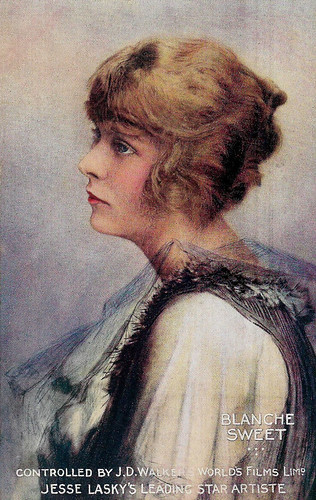
British postcard by J.D. Walker World's Films Ltd. Caption: Jesse Lasky's Leading Star Artiste.
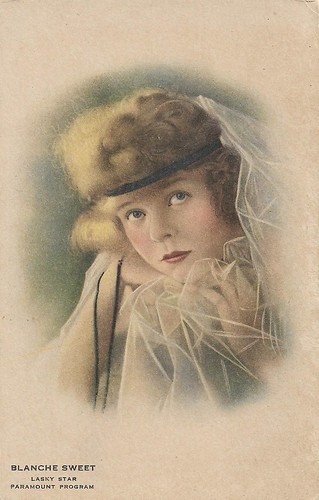
American postcard by Kline Poster Co. Philadelphia. Image: Lasky / Paramount.
A smart and resourceful presence
Sarah Blanche Sweet was born into a family of show people in 1896 in Chicago, Illinois. She was named 'Blanche' after her maternal grandmother, Blanche Alexander. Her father, Gilbert Sweet, deserted the family and her mother Pearl, a dancer, died at age 19. Blanche was raised by her maternal grandmother, who agreed to let her appear on stage when she was only 18 months old.
At the age of four, Blanche toured in a play called 'The Battle of the Strong' with Marie Burroughs and Maurice Barrymore. She was a talented actress by 1909 when she started to work at The Biograph Co. with D.W. Griffith . By 1910, aged 14, she was four years younger than Mary Pickford , but her maturity and appearance soon lead to leading roles. Sweet later remembered: "It never occurred to me that I was different from other children. My wonderful grandmother was both mother and father."
By 1911, she got leads in D.W. Griffith 's films. Sandra Brennan at AllMovie : "Unlike other heroines of her time such as Lillian Gish and Mae Marsh, Sweet did not play fragile shrinking violets in constant need of salvation; instead she played confident and resourceful women who attempted to save themselves."
She starred in countless short films by Biograph, such as the thriller The Lonedale Operator (D.W. Griffith, 1911), as well as the feature Judith of Bethulia (D.W. Griffith, 1914). Her presence was smart and resourceful, and she became known as 'the Biograph Blonde'. In The Lonedale Operator, she pretends a wrench is a gun, to keep burglars at a distance until the rescue party arrives.
The prestigious epic Judith of Bethulia, on the Biblical tale of Judith (Sweet) and the enemy general Holophernes (Henry B. Walthall), was unanimously praised including by ex-president Theodore Roosevelt. The Moving Picture World of 1914 wrote: "A fascinating work of high artistry, Judith of Bethulia will not only rank as an achievement in this country but will make foreign producers sit up and take notice. It has a signal and imperative message, and the technique displayed throughout an infinity of detail, embracing even the delicate film tinting and toning, marks an encouraging step in the development of the new art.
Ancient in story and settings, it is modern in penetrative interpretation - it is a vivid history of one phase of the time it concerns and is redemptive as well as relative, a lesson from one of those vital struggles that made and unmade nations as well as individuals, yet it is not without that inspiring influence that appeals powerfully to the human sense of justice. The entire vigorous action of the play works up to the personal sacrifice of Judith of Bethulia, a perilous chance she takes for the sake of the lives and happiness of her people. She dares expose herself to overwhelming humiliation and dishonor..."
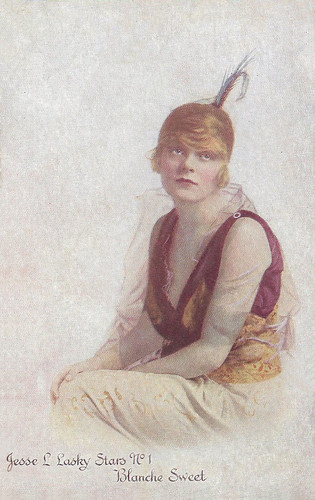
American postcard. Caption: Jesse L. Lasky Stars No. 1.
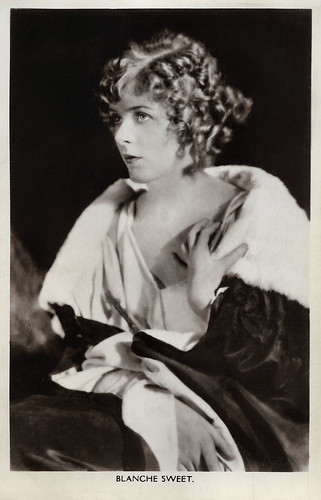
British postcard in the Picturegoer Series, London, no. 118.
A highly publicised affair with director Marshall Neilan
Blanche Sweet left Biograph in 1914 and joined Paramount (then Famous Players-Lasky) for the much higher pay that studio was able to afford. She worked with Cecil B. DeMille in The Warrens of Virginia (1915). A popular and independent actress, she worked for many studios and directors in the age of silent films.
After a highly publicised affair with director Marshall Neilan, Neilan divorced from former actress Gertrude Bambrick and married Sweet in 1922. He would direct her in the Thomas Hardy adaptation Tess of the D'Urbervilles (1924), opposite Conrad Nagel , Stuart Holmes, and George Fawcett.
In 1923, Sweet starred opposite Eugénie Besserer, William Russell , and George Marion in Anna Christie (1923), directed by John Griffith Wray, and the first adaptation of Eugene O'Neill's popular play. In 1930 Greta Garbo would do an early sound adaptation, both in an English and a German version. For both Anna Christie and Tess of the D'Urbervilles, Sweet received raving reviews.
By the mid-1920s, she was a very successful actress, gaining 10.000 dollars per week with acting. Even before the sound film set in, though, her career was in decline. She made three talking pictures, including Show Girl in Hollywood (Mervyn LeRoy, 1930), starring Alice White . This was to be the last film Sweet appeared in before retiring.
Her line, in the film, about being washed up at 32 in Hollywood, was close to the truth for her (she was 34). After that, Sweet retired from the screen and returned to the stage. She appeared in plays on Broadway and with touring companies and also worked in radio during the 1930s.
Eventually, she quit show business and got a job at a department store. Sweet, whose marriage with Neilan had ended in divorce in 1929, married co-star Raymond Hackett in 1936 and they remained happily married until his death in 1958. Both of her marriages were childless. Afterward, Sweet started acting again and appeared in several television shows. She returned to the screen one last time to play a bit part in the Danny Kaye vehicle The Five Pennies (Melville Shavelson, 1959).
In 1975, she was honored with the George Eastman Award for distinguished contribution to the art of film. Blanche worked with film historians such as Kevin Brownlow. She was an important source on his 1980 series Hollywood about the silent era and on his 1993 documentary Griffith, Father of Film. Sweet also gave lectures about the early days of Hollywood.
Sweet is the subject of a documentary by Anthony Slide, titled Portrait of Blanche Sweet (1982), in which she talks of her life and her career. In 1984 she helped a friend, producer Thomas R. Bond II, re-establish The Biograph Co., aka American Mutoscope & Biograph Co., which is the oldest movie company in the US, having been established in 1895.
Blanche Sweet would spend her final years living in New York City. At the age of 90, she died from a stroke in 1986 in New York City. Sweet was cremated and her ashes were scattered in Brooklyn's botanical gardens.
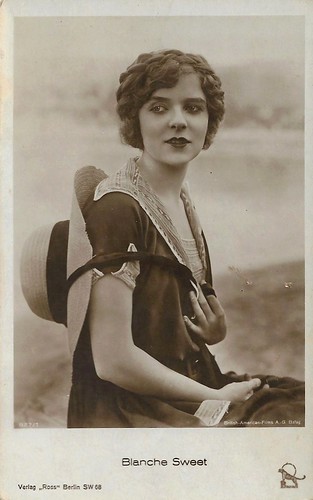
German postcard by Ross Verlag, no. 827/1, 1925-1926. Photo: Bafag (British-American Films A.G.). Sweet's outfit concurs with that in Quincy Adams Sawyer (Clarence Badger, Sawyer-Lubin Pictures Corporation, 1922), also with John Bowers and Lon Chaney .
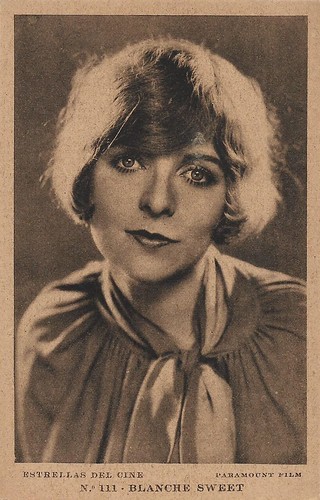
Spanish postcard in the Estrellas del cine series, no. 111. Photo: Paramount Film.
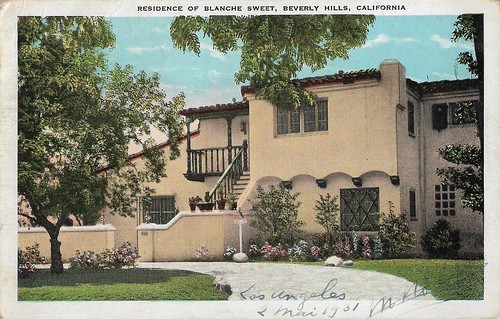
American postcard. Caption: Residence of Blanche Sweet, Beverly Hills, California. The postcard was mailed in 1931. This was the house of Sweet and Marshall Neilan.
Sources: bio's by and on , Sandra Brennan (AllMovie), and Wikipedia. A tinted version (the colour is essential to the plot) of The Lonedale Operator (1911) can be found on the Desmet Playlist of EYE Filmmuseum on YouTube.

British postcard by J.D. Walker World's Films Ltd. Caption: Jesse Lasky's Leading Star Artiste.

American postcard by Kline Poster Co. Philadelphia. Image: Lasky / Paramount.
A smart and resourceful presence
Sarah Blanche Sweet was born into a family of show people in 1896 in Chicago, Illinois. She was named 'Blanche' after her maternal grandmother, Blanche Alexander. Her father, Gilbert Sweet, deserted the family and her mother Pearl, a dancer, died at age 19. Blanche was raised by her maternal grandmother, who agreed to let her appear on stage when she was only 18 months old.
At the age of four, Blanche toured in a play called 'The Battle of the Strong' with Marie Burroughs and Maurice Barrymore. She was a talented actress by 1909 when she started to work at The Biograph Co. with D.W. Griffith . By 1910, aged 14, she was four years younger than Mary Pickford , but her maturity and appearance soon lead to leading roles. Sweet later remembered: "It never occurred to me that I was different from other children. My wonderful grandmother was both mother and father."
By 1911, she got leads in D.W. Griffith 's films. Sandra Brennan at AllMovie : "Unlike other heroines of her time such as Lillian Gish and Mae Marsh, Sweet did not play fragile shrinking violets in constant need of salvation; instead she played confident and resourceful women who attempted to save themselves."
She starred in countless short films by Biograph, such as the thriller The Lonedale Operator (D.W. Griffith, 1911), as well as the feature Judith of Bethulia (D.W. Griffith, 1914). Her presence was smart and resourceful, and she became known as 'the Biograph Blonde'. In The Lonedale Operator, she pretends a wrench is a gun, to keep burglars at a distance until the rescue party arrives.
The prestigious epic Judith of Bethulia, on the Biblical tale of Judith (Sweet) and the enemy general Holophernes (Henry B. Walthall), was unanimously praised including by ex-president Theodore Roosevelt. The Moving Picture World of 1914 wrote: "A fascinating work of high artistry, Judith of Bethulia will not only rank as an achievement in this country but will make foreign producers sit up and take notice. It has a signal and imperative message, and the technique displayed throughout an infinity of detail, embracing even the delicate film tinting and toning, marks an encouraging step in the development of the new art.
Ancient in story and settings, it is modern in penetrative interpretation - it is a vivid history of one phase of the time it concerns and is redemptive as well as relative, a lesson from one of those vital struggles that made and unmade nations as well as individuals, yet it is not without that inspiring influence that appeals powerfully to the human sense of justice. The entire vigorous action of the play works up to the personal sacrifice of Judith of Bethulia, a perilous chance she takes for the sake of the lives and happiness of her people. She dares expose herself to overwhelming humiliation and dishonor..."

American postcard. Caption: Jesse L. Lasky Stars No. 1.

British postcard in the Picturegoer Series, London, no. 118.
A highly publicised affair with director Marshall Neilan
Blanche Sweet left Biograph in 1914 and joined Paramount (then Famous Players-Lasky) for the much higher pay that studio was able to afford. She worked with Cecil B. DeMille in The Warrens of Virginia (1915). A popular and independent actress, she worked for many studios and directors in the age of silent films.
After a highly publicised affair with director Marshall Neilan, Neilan divorced from former actress Gertrude Bambrick and married Sweet in 1922. He would direct her in the Thomas Hardy adaptation Tess of the D'Urbervilles (1924), opposite Conrad Nagel , Stuart Holmes, and George Fawcett.
In 1923, Sweet starred opposite Eugénie Besserer, William Russell , and George Marion in Anna Christie (1923), directed by John Griffith Wray, and the first adaptation of Eugene O'Neill's popular play. In 1930 Greta Garbo would do an early sound adaptation, both in an English and a German version. For both Anna Christie and Tess of the D'Urbervilles, Sweet received raving reviews.
By the mid-1920s, she was a very successful actress, gaining 10.000 dollars per week with acting. Even before the sound film set in, though, her career was in decline. She made three talking pictures, including Show Girl in Hollywood (Mervyn LeRoy, 1930), starring Alice White . This was to be the last film Sweet appeared in before retiring.
Her line, in the film, about being washed up at 32 in Hollywood, was close to the truth for her (she was 34). After that, Sweet retired from the screen and returned to the stage. She appeared in plays on Broadway and with touring companies and also worked in radio during the 1930s.
Eventually, she quit show business and got a job at a department store. Sweet, whose marriage with Neilan had ended in divorce in 1929, married co-star Raymond Hackett in 1936 and they remained happily married until his death in 1958. Both of her marriages were childless. Afterward, Sweet started acting again and appeared in several television shows. She returned to the screen one last time to play a bit part in the Danny Kaye vehicle The Five Pennies (Melville Shavelson, 1959).
In 1975, she was honored with the George Eastman Award for distinguished contribution to the art of film. Blanche worked with film historians such as Kevin Brownlow. She was an important source on his 1980 series Hollywood about the silent era and on his 1993 documentary Griffith, Father of Film. Sweet also gave lectures about the early days of Hollywood.
Sweet is the subject of a documentary by Anthony Slide, titled Portrait of Blanche Sweet (1982), in which she talks of her life and her career. In 1984 she helped a friend, producer Thomas R. Bond II, re-establish The Biograph Co., aka American Mutoscope & Biograph Co., which is the oldest movie company in the US, having been established in 1895.
Blanche Sweet would spend her final years living in New York City. At the age of 90, she died from a stroke in 1986 in New York City. Sweet was cremated and her ashes were scattered in Brooklyn's botanical gardens.

German postcard by Ross Verlag, no. 827/1, 1925-1926. Photo: Bafag (British-American Films A.G.). Sweet's outfit concurs with that in Quincy Adams Sawyer (Clarence Badger, Sawyer-Lubin Pictures Corporation, 1922), also with John Bowers and Lon Chaney .

Spanish postcard in the Estrellas del cine series, no. 111. Photo: Paramount Film.

American postcard. Caption: Residence of Blanche Sweet, Beverly Hills, California. The postcard was mailed in 1931. This was the house of Sweet and Marshall Neilan.
Sources: bio's by and on , Sandra Brennan (AllMovie), and Wikipedia. A tinted version (the colour is essential to the plot) of The Lonedale Operator (1911) can be found on the Desmet Playlist of EYE Filmmuseum on YouTube.
Published on December 28, 2020 22:00
December 27, 2020
Oliver & Company (1988)
Our final post in Disney December at EFSP is about Oliver & Company (George Scribner, 1988), the twenty-seventh animated feature released in the Disney Canon. The film was inspired by Charles Dickens's classic novel 'Oliver Twist' (1838), which has been adapted many other times for the screen. Oliver is here a homeless kitten who joins Fagin's gang of dogs to survive on the streets of 1980s New York City. One of Fagin's gang is Dodger, and Bill Sykes appears as a loan shark. Although it's not one of Disney's best animation classics, Oliver & Company is totally enjoyable.
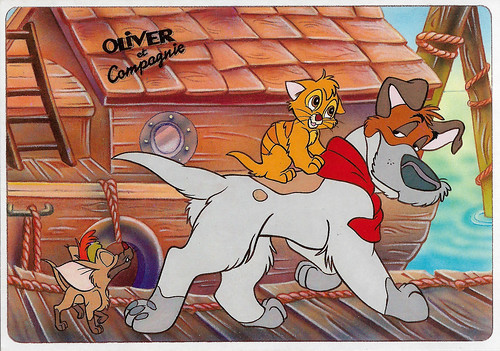
French postcard by MB, Paris, no. D 640, 5/3. Image: Disney. Publicity still for Oliver & Company (1988).

French postcard by MB, Paris, no. D 640, 5/4. Image: Disney. Publicity still for Oliver & Co. (1988).
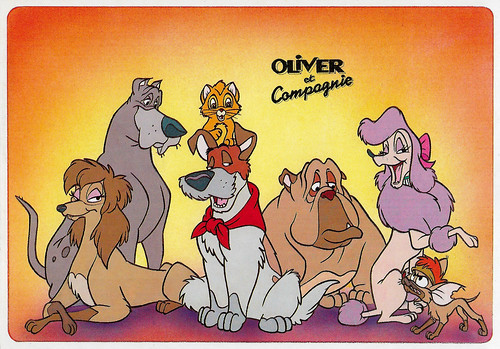
French postcard by MB, Paris, no. D 640, 5/5. Image: Disney. Publicity still for Oliver & Co. (1988).
Oliver Twist with dogs
After the release of The Black Cauldron (Ted Berman, Richard Rich, 1985), Disney's Michael Eisner and Jeffrey Katzenberg invited the animators to pitch potential ideas for upcoming animated features.
After John Musker and Ron Clements suggested "The Little Mermaid" and "Treasure Island in Space", animator Pete Young suggested, "Oliver Twist with dogs".
Originally wanting to produce a live-action adaptation of the musical 'Oliver!' at Paramount Pictures, Katzenberg approved of the pitch. The working title of the film during production was 'Oliver and the Dodger'. It pre-dated the Disney Renaissance.
The original central brain trust of Disney animators, the 'Nine Old Men', had retired in the early 1980s, which signaled the entrance for the next generation of Disney animators, including the film's supervising animators Glen Keane, Ruben A. Aquino, Mike Gabriel, Hendel Butoy, and Mark Henn.
At a certain point, it was to be a sequel to The Rescuers (John Lounsbery, Wolfgang Reitherman, Art Stevens, 1977). If this had happened, it would have given the character of Penny more development, showing her living her new life in New York City with Georgette, as well as her new adoptive parents.
This idea was eventually scrapped because the producers had then felt that the story would not have been convincing. Young was originally assigned to co-direct the film with George Scribner, a Disney newcomer who had recently joined from the Hanna-Barbera studio but suddenly died in mid-October 1985.
Richard Rich, who had previously co-directed The Fox and the Hound (Ted Berman, Richard Rich, Art Stevens, 1981) and The Black Cauldron (Ted Berman, Richard Rich, 1985), was then brought on-board to replace Young, but due to acting belligerent towards the president of Walt Disney Feature Animation, Peter Schneider, as what Schneider claimed, he was fired in 1986. Rich was not replaced after his firing, leaving Scribner as the sole director.
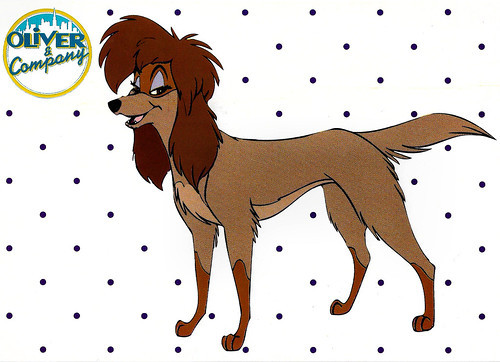
Italian postcard by Grafiche Biondetti S.R.L., Verona, no. 148/2. Image: Disney. Publicity still for Oliver & Company (George Scribner, 1988).

Italian postcard by Grafiche Biondetti S.R.L., Verona, no. 148/3. Image: Disney. Publicity still for Oliver & Company (George Scribner, 1988).
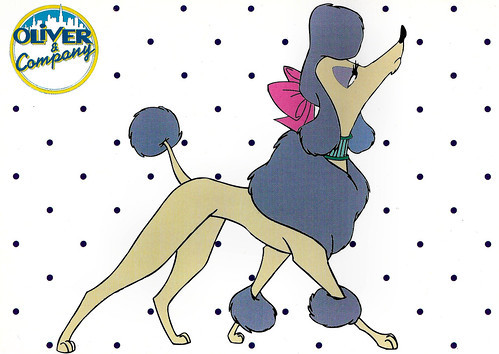
Italian postcard by Grafiche Biondetti S.R.L., Verona, no. 148/4. Image: Disney. Publicity still for Oliver & Company (George Scribner, 1988).
The first Disney film to extensively feature computer animation
Oliver & Company (1988) was the first Disney film to extensively feature computer animation. The two immediately preceding Disney films, The Black Cauldron (Ted Berman, Richard Rich, 1985) and The Great Mouse Detective (Ron Clements, Burny Mattinson, David Michener, John Musker, 1986), only featured it during special sequences. The CGI effects were used for making the skyscrapers, the cars, trains, Fagin's scooter, and the climactic subway chase.
It was also the first Disney film to have a department created specifically for computer animation. The film was a test run one before The Walt Disney Company would fully commit to returning to a musical format for their animated films. It was the first such film to be a musical since The Fox and the Hound (Ted Berman, Richard Rich, Art Stevens, 1981). For the next decade, all of Walt Disney Feature Animation's films, starting with The Little Mermaid (Ron Clements, John Musker, 1989), were also musicals, except for The Rescuers Down Under (Hendel Butoy, Mike Gabriel, 1990).
Oliver & Company (1988) was one of the first animated Disney films to introduce new sound effects for regular use, as replacements for many of the classic sounds originally in the Disney library, which would be used occasionally in later Disney films. However, The Little Mermaid (Ron Clements, John Musker, 1989) became the basis for the introduction of even more new sound effects.
The new sound effects were first introduced with The Black Cauldron (Ted Berman, Richard Rich, 1985), while The Great Mouse Detective (Ron Clements, Burny Mattinson, David Michener, John Musker, 1986), released a year after the previous film, featuring the classic Disney sound effects, including the then fifty-year-old Castle Thunder and the classic Goofy holler. However, the Disney television animation studio continued extensively using the classic Disney sound effects for several years, while the feature animation studio retired the original sound effects.
Certain animal characters from previous Disney films make cameo characters in the film. Four of the dogs shown are Peg, Jock, and Trusty from Lady and the Tramp (Clyde Geronimi, Wilfred Jackson, Hamilton Luske, 1955), and Pongo from One Hundred and One Dalmatians (Clyde Geronimi, Hamilton Luske, Wolfgang Reitherman, 1961).
Opening on the same weekend as Don Bluth's The Land Before Time (1988), which debuted at number one in the United States and Canada grossing $7.5 million, Oliver & Company opened at fourth, grossing $4 million. Nevertheless, Oliver & Company out-grossed The Land Before Time with a total gross in the United States and Canada of $53 million compared to the latter's $46 million, making it the animated film with the highest gross from its initial run.
Oliver & Company was also the first animated film to gross $100 million worldwide in its initial release. Its success prompted Disney's Senior Vice President of Animation, Peter Schneider, to announce the company's plans to release animated features annually.
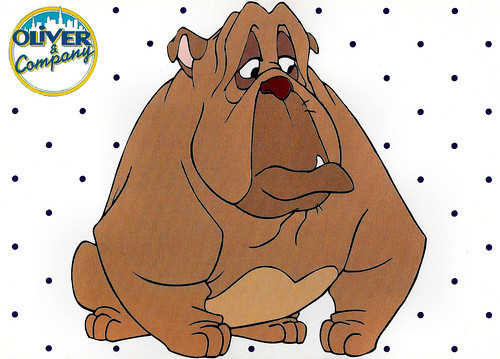
Italian postcard by Grafiche Biondetti S.R.L., Verona, no. 148/5. Image: Disney. Publicity still for Oliver & Company (George Scribner, 1988).
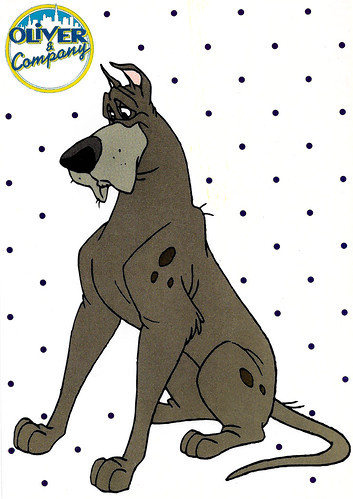
Italian postcard by Grafiche Biondetti S.R.L., Verona, no. 148/7. Image: Disney. Publicity still for Oliver & Company (George Scribner, 1988).
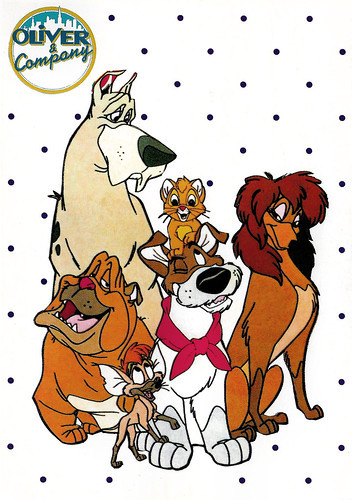
Italian postcard by Grafiche Biondetti S.R.L., Verona, no. 148/8. Image: Disney. Publicity still for Oliver & Company (George Scribner, 1988).
Sources: Disney Wiki, Wikipedia, and IMDb.

French postcard by MB, Paris, no. D 640, 5/3. Image: Disney. Publicity still for Oliver & Company (1988).

French postcard by MB, Paris, no. D 640, 5/4. Image: Disney. Publicity still for Oliver & Co. (1988).

French postcard by MB, Paris, no. D 640, 5/5. Image: Disney. Publicity still for Oliver & Co. (1988).
Oliver Twist with dogs
After the release of The Black Cauldron (Ted Berman, Richard Rich, 1985), Disney's Michael Eisner and Jeffrey Katzenberg invited the animators to pitch potential ideas for upcoming animated features.
After John Musker and Ron Clements suggested "The Little Mermaid" and "Treasure Island in Space", animator Pete Young suggested, "Oliver Twist with dogs".
Originally wanting to produce a live-action adaptation of the musical 'Oliver!' at Paramount Pictures, Katzenberg approved of the pitch. The working title of the film during production was 'Oliver and the Dodger'. It pre-dated the Disney Renaissance.
The original central brain trust of Disney animators, the 'Nine Old Men', had retired in the early 1980s, which signaled the entrance for the next generation of Disney animators, including the film's supervising animators Glen Keane, Ruben A. Aquino, Mike Gabriel, Hendel Butoy, and Mark Henn.
At a certain point, it was to be a sequel to The Rescuers (John Lounsbery, Wolfgang Reitherman, Art Stevens, 1977). If this had happened, it would have given the character of Penny more development, showing her living her new life in New York City with Georgette, as well as her new adoptive parents.
This idea was eventually scrapped because the producers had then felt that the story would not have been convincing. Young was originally assigned to co-direct the film with George Scribner, a Disney newcomer who had recently joined from the Hanna-Barbera studio but suddenly died in mid-October 1985.
Richard Rich, who had previously co-directed The Fox and the Hound (Ted Berman, Richard Rich, Art Stevens, 1981) and The Black Cauldron (Ted Berman, Richard Rich, 1985), was then brought on-board to replace Young, but due to acting belligerent towards the president of Walt Disney Feature Animation, Peter Schneider, as what Schneider claimed, he was fired in 1986. Rich was not replaced after his firing, leaving Scribner as the sole director.

Italian postcard by Grafiche Biondetti S.R.L., Verona, no. 148/2. Image: Disney. Publicity still for Oliver & Company (George Scribner, 1988).

Italian postcard by Grafiche Biondetti S.R.L., Verona, no. 148/3. Image: Disney. Publicity still for Oliver & Company (George Scribner, 1988).

Italian postcard by Grafiche Biondetti S.R.L., Verona, no. 148/4. Image: Disney. Publicity still for Oliver & Company (George Scribner, 1988).
The first Disney film to extensively feature computer animation
Oliver & Company (1988) was the first Disney film to extensively feature computer animation. The two immediately preceding Disney films, The Black Cauldron (Ted Berman, Richard Rich, 1985) and The Great Mouse Detective (Ron Clements, Burny Mattinson, David Michener, John Musker, 1986), only featured it during special sequences. The CGI effects were used for making the skyscrapers, the cars, trains, Fagin's scooter, and the climactic subway chase.
It was also the first Disney film to have a department created specifically for computer animation. The film was a test run one before The Walt Disney Company would fully commit to returning to a musical format for their animated films. It was the first such film to be a musical since The Fox and the Hound (Ted Berman, Richard Rich, Art Stevens, 1981). For the next decade, all of Walt Disney Feature Animation's films, starting with The Little Mermaid (Ron Clements, John Musker, 1989), were also musicals, except for The Rescuers Down Under (Hendel Butoy, Mike Gabriel, 1990).
Oliver & Company (1988) was one of the first animated Disney films to introduce new sound effects for regular use, as replacements for many of the classic sounds originally in the Disney library, which would be used occasionally in later Disney films. However, The Little Mermaid (Ron Clements, John Musker, 1989) became the basis for the introduction of even more new sound effects.
The new sound effects were first introduced with The Black Cauldron (Ted Berman, Richard Rich, 1985), while The Great Mouse Detective (Ron Clements, Burny Mattinson, David Michener, John Musker, 1986), released a year after the previous film, featuring the classic Disney sound effects, including the then fifty-year-old Castle Thunder and the classic Goofy holler. However, the Disney television animation studio continued extensively using the classic Disney sound effects for several years, while the feature animation studio retired the original sound effects.
Certain animal characters from previous Disney films make cameo characters in the film. Four of the dogs shown are Peg, Jock, and Trusty from Lady and the Tramp (Clyde Geronimi, Wilfred Jackson, Hamilton Luske, 1955), and Pongo from One Hundred and One Dalmatians (Clyde Geronimi, Hamilton Luske, Wolfgang Reitherman, 1961).
Opening on the same weekend as Don Bluth's The Land Before Time (1988), which debuted at number one in the United States and Canada grossing $7.5 million, Oliver & Company opened at fourth, grossing $4 million. Nevertheless, Oliver & Company out-grossed The Land Before Time with a total gross in the United States and Canada of $53 million compared to the latter's $46 million, making it the animated film with the highest gross from its initial run.
Oliver & Company was also the first animated film to gross $100 million worldwide in its initial release. Its success prompted Disney's Senior Vice President of Animation, Peter Schneider, to announce the company's plans to release animated features annually.

Italian postcard by Grafiche Biondetti S.R.L., Verona, no. 148/5. Image: Disney. Publicity still for Oliver & Company (George Scribner, 1988).

Italian postcard by Grafiche Biondetti S.R.L., Verona, no. 148/7. Image: Disney. Publicity still for Oliver & Company (George Scribner, 1988).

Italian postcard by Grafiche Biondetti S.R.L., Verona, no. 148/8. Image: Disney. Publicity still for Oliver & Company (George Scribner, 1988).
Sources: Disney Wiki, Wikipedia, and IMDb.
Published on December 27, 2020 22:00
December 26, 2020
The Many Adventures of Winnie the Pooh (1977)
The anthology film The Many Adventures of Winnie the Pooh is Disney's 22nd animated feature, based upon the Winnie-the-Pooh books by A. A. Milne and E. H. Shepard. The film is comprised of three previously released animated Disney featurettes: Winnie the Pooh and the Honey Tree (1966), Winnie the Pooh and the Blustery Day (1968), and Winnie the Pooh and Tigger Too (1974). Extra material was used to link the three featurettes together to allow the stories to merge into each other. The Many Adventures of Winnie the Pooh was first released on a double bill with The Littlest Horse Thieves in 1977.
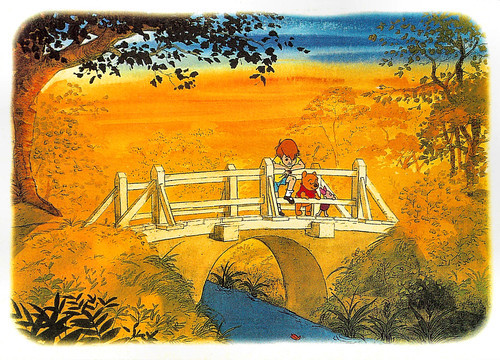
Finnish postcard. Image: Disney. Publicity still for The Many Adventures of Winnie the Pooh (John Lounsbery, Wolfgang Reitherman, 1977). Caption: Greetings from the Hundred Acre Wood!
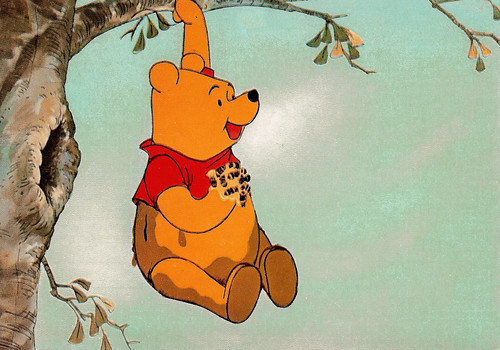
French postcard by Les Presses de Belleville, Paris / LYNA, Paris. Image: Walt Disney Productions, 1965. Publicity still for the short film Winnie the Pooh and the Honey Tree (Wolfgang Reitherman, 1966), later incorporated in the feature The Many Adventures of Winnie the Pooh (John Lounsbery, Wolfgang Reitherman, 1977). Caption: The honey thief.
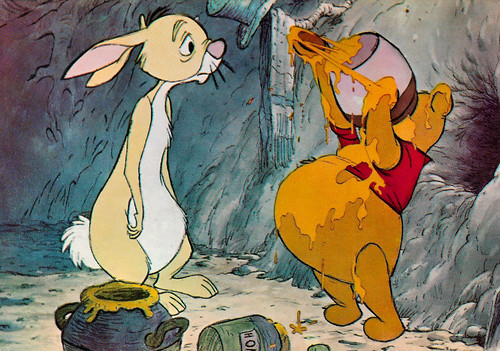
French postcard by Les Presses de Belleville, Paris / LYNA, Paris. Image: Walt Disney Productions, 1965. Publicity still for the short film Winnie the Pooh and the Honey Tree (Wolfgang Reitherman, 1966), later incorporated in the feature The Many Adventures of Winnie the Pooh (John Lounsbery, Wolfgang Reitherman, 1977). Caption: What a gourmand!
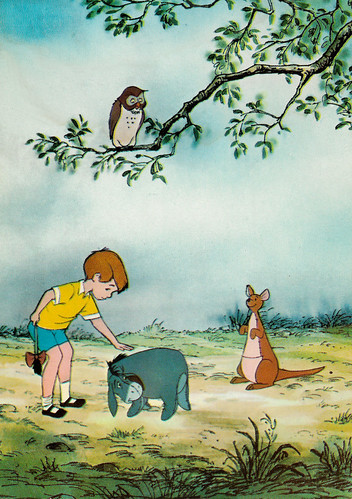
French postcard by Les Presses de Belleville, Paris / LYNA, Paris. Image: Walt Disney Productions, 1965. Publicity still for the short film Winnie the Pooh and the Honey Tree (Wolfgang Reitherman, 1966), later incorporated in the feature The Many Adventures of Winnie the Pooh (John Lounsbery, Wolfgang Reitherman, 1977). Caption: Winnie the Pooh.
The magical world of the Hundred Acre Wood
In the short film Winnie the Pooh and the Honey Tree (Wolfgang Reitherman, 1966), Winnie the Pooh and his friends have adventures in the magical world of the Hundred Acre Wood.
Winnie, Christopher Robin's silly old bear attempts to get honey from a bee tree. After climbing the tree didn't work, Winnie borrows Christopher Robin's balloon, dunks himself in mud, and floats to the top of the honey tree incognito as a little black rain cloud.
After escaping the angry bees, Pooh decides to get honey the old fashion way: getting some from Rabbit, so after stuffing his face with all of Rabbit's honey, Pooh attempts to climb out Rabbit's front door but becomes stuck!
No matter how hard everyone tries, they can't get him out, so Pooh is stuck for a week until he can lose the excess baggage. Then along comes Gopher who agrees to help get Pooh out and almost feeds him more honey! But then one morning, Pooh is finally freed from the doorway and ends up in another sticky situation-quite literally!
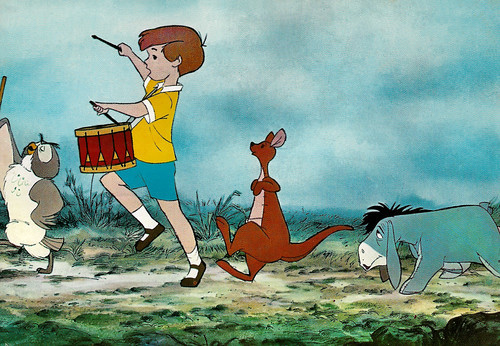
French postcard by Les Presses de Belleville, Paris / LYNA, Paris. Image: Walt Disney Productions, 1965. Publicity still for the short film Winnie the Pooh and the Honey Tree (Wolfgang Reitherman, 1966), later incorporated in the feature The Many Adventures of Winnie the Pooh (John Lounsbery, Wolfgang Reitherman, 1977). Caption: The brass band.

French postcard by Les Presses de Belleville, Paris / LYNA, Paris. Image: Walt Disney Productions, 1965. Publicity still for the short film Winnie the Pooh and the Honey Tree (Wolfgang Reitherman, 1966), later incorporated in the feature The Many Adventures of Winnie the Pooh (John Lounsbery, Wolfgang Reitherman, 1977). Caption: Winnie the Pooh.
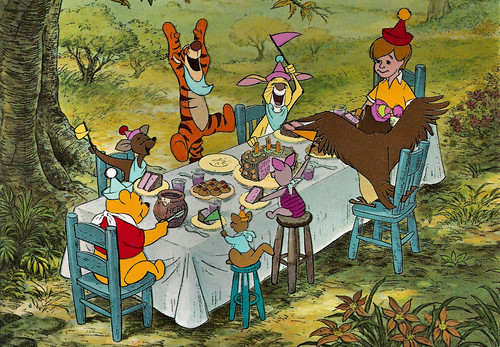
British postcard by J. Arthur Dixon Ltd / Lotus Production, no. PCD/21286. Image: Walt Disney Productions, 1965. Publicity still for the short film Winnie the Pooh and the Blustery Day (Wolfgang Reitherman, 1968), later incorporated in the feature The Many Adventures of Winnie the Pooh (John Lounsbery, Wolfgang Reitherman, 1977). Caption: For deeds well done, Christopher Robin throws a party for heroes Pooh Bear and Piglet and their Hundred Acre Wood friends.
Rumbly in My Tumbly
Winnie the Pooh and the Honey Tree (Wolfgang Reitherman, 1966) is the first of the four Winnie the Pooh short films by the Disney studio, based on the A. A. Milne stories. Each character is introduced nicely in this charming short classic. The animation is excellent and the Sherman Brothers composed great songs such as 'Little Black Rain Cloud', 'Up, Down and Touch the Ground', 'Rumbly in My Tumbly' and 'Winnie the Pooh'.
Pooh's determination to get some honey remains amusing. Although he is a bear with very little brain, he's not the sort of bear to give up easily. The honey-loving bear tries various schemes to get his golden delight. It's funny how he often thinks of something, but no matter how hard he tries to think, the only thing that comes to his simple mind is honey.
And it's funny that he does physical exercises, but not for the reasons you could think. Do you think he does physical exercises to get thinner? You better think again! He does physical exercises to get hungry, as an excuse to eat honey. Each different character in the film has a unique trait. The donkey Eeyore shows the depressing side of human nature, always finding the downside of anything.
The other characters succeed in cheering him up. The owl is the 'educated' one who loves to hear himself talk. Tigger, happy-go-lucky tiger bounces around exuberantly on his coil-spring tail, greeting everyone, and sometimes accidentally knocking them over.
Winnie the Pooh and the Honey Tree (Wolfgang Reitherman, 1966) immediately became a popular phenomenon, and lead to more Pooh shorts which later made up the feature film The Many Adventures of Winnie the Pooh (John Lounsbery, Wolfgang Reitherman, 1977).
A fourth, shorter scene was added to bring the film to a close, originally made during production of Blustery Day. The sequence was based on the final chapter of 'The House at Pooh Corner', where Christopher Robin must leave the Hundred Acre Wood behind as he is starting school. In it, Christopher Robin and Pooh discuss what they liked doing together and the boy asks his bear to promise to remember him and to keep some of the memories of their time together alive. Pooh agrees to do so, and the film closes with The Narrator (Sebastian Cabot) saying that wherever Christopher Robin goes, Pooh will always be waiting for him whenever he returns.
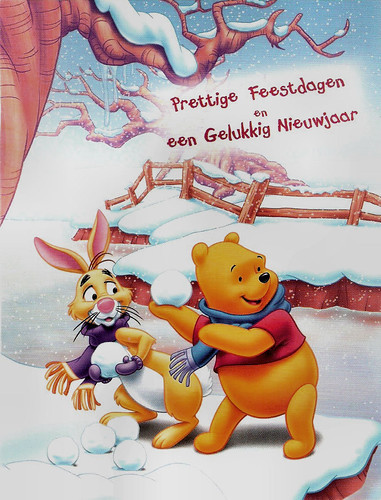
Dutch postcard. Caption: Happy Holidays and Happy New Year.

French postcard by Cartoon Collection, Paris, Réf. 26289. Image: Disney. Based on the "Winnie the Pooh" works by A.A. Milne and E.H. Shepard. Caption: Party.
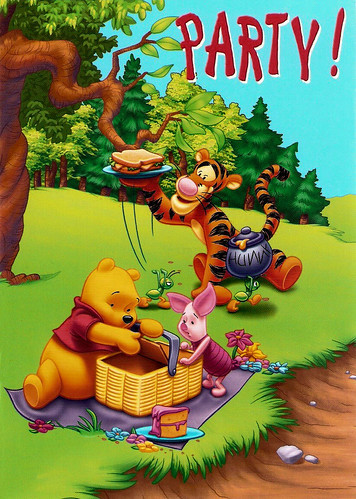
French postcard by Cartoon Collection, Paris, Réf. 24225. Image: Disney. Based on the "Winnie the Pooh" works by A.A. Milne and E.H. Shepard. Caption: Party.
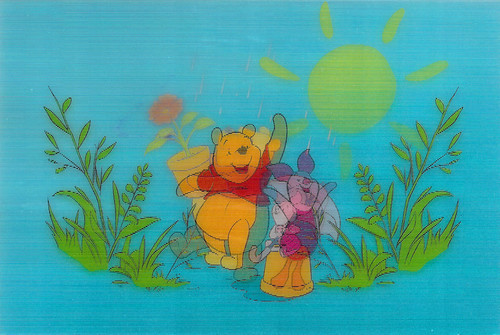
Italian lenticular postcard by Dedit srl, no. 2803474. Image: Disney, based on the "Winnie the Pooh" works by A.A. Milne and E.H. Shepard. Lenticular printing is a technology in which lenticular lenses are used to produce printed images with an illusion of depth, or the ability to change or as for this postcard move as the image is viewed from different angles. Like today, the weather changes on the card from rain to sunshine and back. Sadly, we can't scan the effect.
Sources: Wikipedia and IMDb.

Finnish postcard. Image: Disney. Publicity still for The Many Adventures of Winnie the Pooh (John Lounsbery, Wolfgang Reitherman, 1977). Caption: Greetings from the Hundred Acre Wood!

French postcard by Les Presses de Belleville, Paris / LYNA, Paris. Image: Walt Disney Productions, 1965. Publicity still for the short film Winnie the Pooh and the Honey Tree (Wolfgang Reitherman, 1966), later incorporated in the feature The Many Adventures of Winnie the Pooh (John Lounsbery, Wolfgang Reitherman, 1977). Caption: The honey thief.

French postcard by Les Presses de Belleville, Paris / LYNA, Paris. Image: Walt Disney Productions, 1965. Publicity still for the short film Winnie the Pooh and the Honey Tree (Wolfgang Reitherman, 1966), later incorporated in the feature The Many Adventures of Winnie the Pooh (John Lounsbery, Wolfgang Reitherman, 1977). Caption: What a gourmand!

French postcard by Les Presses de Belleville, Paris / LYNA, Paris. Image: Walt Disney Productions, 1965. Publicity still for the short film Winnie the Pooh and the Honey Tree (Wolfgang Reitherman, 1966), later incorporated in the feature The Many Adventures of Winnie the Pooh (John Lounsbery, Wolfgang Reitherman, 1977). Caption: Winnie the Pooh.
The magical world of the Hundred Acre Wood
In the short film Winnie the Pooh and the Honey Tree (Wolfgang Reitherman, 1966), Winnie the Pooh and his friends have adventures in the magical world of the Hundred Acre Wood.
Winnie, Christopher Robin's silly old bear attempts to get honey from a bee tree. After climbing the tree didn't work, Winnie borrows Christopher Robin's balloon, dunks himself in mud, and floats to the top of the honey tree incognito as a little black rain cloud.
After escaping the angry bees, Pooh decides to get honey the old fashion way: getting some from Rabbit, so after stuffing his face with all of Rabbit's honey, Pooh attempts to climb out Rabbit's front door but becomes stuck!
No matter how hard everyone tries, they can't get him out, so Pooh is stuck for a week until he can lose the excess baggage. Then along comes Gopher who agrees to help get Pooh out and almost feeds him more honey! But then one morning, Pooh is finally freed from the doorway and ends up in another sticky situation-quite literally!

French postcard by Les Presses de Belleville, Paris / LYNA, Paris. Image: Walt Disney Productions, 1965. Publicity still for the short film Winnie the Pooh and the Honey Tree (Wolfgang Reitherman, 1966), later incorporated in the feature The Many Adventures of Winnie the Pooh (John Lounsbery, Wolfgang Reitherman, 1977). Caption: The brass band.

French postcard by Les Presses de Belleville, Paris / LYNA, Paris. Image: Walt Disney Productions, 1965. Publicity still for the short film Winnie the Pooh and the Honey Tree (Wolfgang Reitherman, 1966), later incorporated in the feature The Many Adventures of Winnie the Pooh (John Lounsbery, Wolfgang Reitherman, 1977). Caption: Winnie the Pooh.

British postcard by J. Arthur Dixon Ltd / Lotus Production, no. PCD/21286. Image: Walt Disney Productions, 1965. Publicity still for the short film Winnie the Pooh and the Blustery Day (Wolfgang Reitherman, 1968), later incorporated in the feature The Many Adventures of Winnie the Pooh (John Lounsbery, Wolfgang Reitherman, 1977). Caption: For deeds well done, Christopher Robin throws a party for heroes Pooh Bear and Piglet and their Hundred Acre Wood friends.
Rumbly in My Tumbly
Winnie the Pooh and the Honey Tree (Wolfgang Reitherman, 1966) is the first of the four Winnie the Pooh short films by the Disney studio, based on the A. A. Milne stories. Each character is introduced nicely in this charming short classic. The animation is excellent and the Sherman Brothers composed great songs such as 'Little Black Rain Cloud', 'Up, Down and Touch the Ground', 'Rumbly in My Tumbly' and 'Winnie the Pooh'.
Pooh's determination to get some honey remains amusing. Although he is a bear with very little brain, he's not the sort of bear to give up easily. The honey-loving bear tries various schemes to get his golden delight. It's funny how he often thinks of something, but no matter how hard he tries to think, the only thing that comes to his simple mind is honey.
And it's funny that he does physical exercises, but not for the reasons you could think. Do you think he does physical exercises to get thinner? You better think again! He does physical exercises to get hungry, as an excuse to eat honey. Each different character in the film has a unique trait. The donkey Eeyore shows the depressing side of human nature, always finding the downside of anything.
The other characters succeed in cheering him up. The owl is the 'educated' one who loves to hear himself talk. Tigger, happy-go-lucky tiger bounces around exuberantly on his coil-spring tail, greeting everyone, and sometimes accidentally knocking them over.
Winnie the Pooh and the Honey Tree (Wolfgang Reitherman, 1966) immediately became a popular phenomenon, and lead to more Pooh shorts which later made up the feature film The Many Adventures of Winnie the Pooh (John Lounsbery, Wolfgang Reitherman, 1977).
A fourth, shorter scene was added to bring the film to a close, originally made during production of Blustery Day. The sequence was based on the final chapter of 'The House at Pooh Corner', where Christopher Robin must leave the Hundred Acre Wood behind as he is starting school. In it, Christopher Robin and Pooh discuss what they liked doing together and the boy asks his bear to promise to remember him and to keep some of the memories of their time together alive. Pooh agrees to do so, and the film closes with The Narrator (Sebastian Cabot) saying that wherever Christopher Robin goes, Pooh will always be waiting for him whenever he returns.

Dutch postcard. Caption: Happy Holidays and Happy New Year.

French postcard by Cartoon Collection, Paris, Réf. 26289. Image: Disney. Based on the "Winnie the Pooh" works by A.A. Milne and E.H. Shepard. Caption: Party.

French postcard by Cartoon Collection, Paris, Réf. 24225. Image: Disney. Based on the "Winnie the Pooh" works by A.A. Milne and E.H. Shepard. Caption: Party.

Italian lenticular postcard by Dedit srl, no. 2803474. Image: Disney, based on the "Winnie the Pooh" works by A.A. Milne and E.H. Shepard. Lenticular printing is a technology in which lenticular lenses are used to produce printed images with an illusion of depth, or the ability to change or as for this postcard move as the image is viewed from different angles. Like today, the weather changes on the card from rain to sunshine and back. Sadly, we can't scan the effect.
Sources: Wikipedia and IMDb.
Published on December 26, 2020 22:00
December 25, 2020
La Collectionneuse: Disney Women
Walt Disney’s name will forever be associated with cartoons. But his work can’t be reduced to that field. In the 1940s, he began to produce films combining live-action and animation, a technique which would be later used at its best in Mary Poppins (1964). In 1950, Treasure’s Island was Disney’s first completely live-action film. And many others would follow, mostly adventure films, Westerns, and comedies. Of course, these were family-oriented movies and “clean entertainment” was the watchword. When selecting actors and actresses to work with him, Disney was smart enough to use young talents and veteran stars alike. Sometimes, animals (such as dogs, cats, horses, etc.) co-starred with humans. I’ve selected 27 actresses who have been featured in Disney’s movies. The deadline is Walt Disney’s death, on the 15th of December 1966. The Disney films in which these 27 stars appeared were released before that date. However, some of these actresses have worked for the Disney studios both before and after Walt’s death.
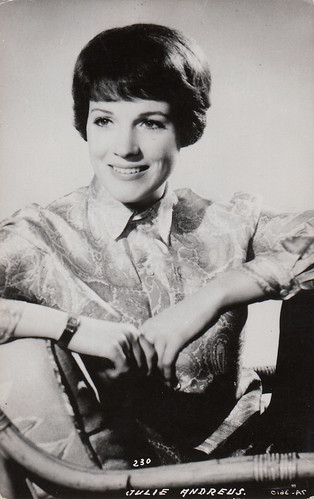
Mexican postcard by Sello, no. 230. Collection: Marlene Pilaete.
Julie Andrews (1935) won a best actress Academy Award for her film debut in Walt Disney’s Mary Poppins (1964). Her third film, The Sound of Music (1965), was also a huge box office hit for 20th Century Fox. Some fifteen years later, she won praise for her portrayal in Victor/Victoria (1982). Later in her career, she came back to the Disney studios for The Princess Diaries (2001) and The Princess Diaries II (2004). In 2003, she also appeared in two episodes of the TV series The World of Disney.
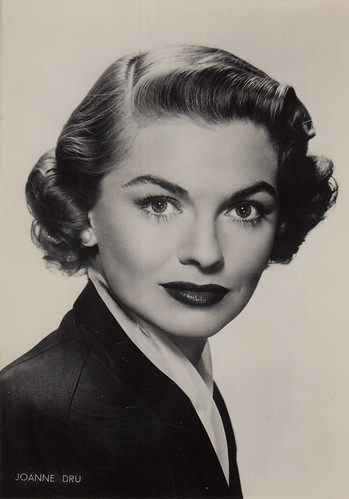
Italian postcard by Ediz. G. Ratti, Torino. Collection: Marlene Pilaete.
Joanne Dru (1922-1996) was a John Ford heroine in She Wore a Yellow Ribbon (1949) and Wagon Master (1950). Among her other westerns are Red River (1948), directed by Howard Hawks, Vengeance Valley (1951), The Siege at Red River (1954) or Drango (1957). She was also Fess Parker’s love interest in Disney’s Light in the Forest (1958). During her career, she played other kinds of roles, most notably in All the King’s Men (1949), which won a Best Picture Oscar. On the campy side, she was a secretary secretly in love with her boss, Liberace, in Sincerely Yours (1955), the movie which failed to make a movie star of this flamboyant and hugely popular pianist.
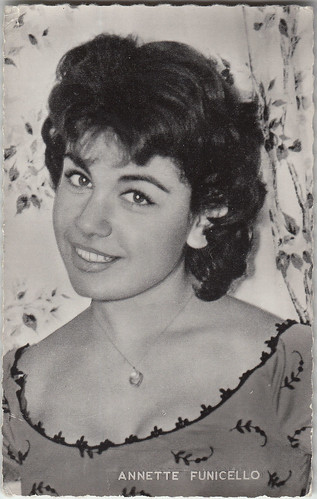
Postcard by Editions P.I. Produced for the Canadian company Photos-Vedettes. Collection: Marlene Pilaete.
Under contract with Disney, Annette Funicello (1942-2013) became one of the most renowned performers of the TV program The Mickey Mouse Club from 1955 to 1958. The Disney studios cashed on her popularity by featuring her on the big screen in four films: The Shaggy Dog (1959), Babes in Toyland (1961), The Misadventures of Merlin Jones (1964), and The Monkey’s Uncle (1965). At the same time, she continued her TV career, for example in The Horsemasters (1961) and several episodes of Zorro. Annette Funicello was also famous for the teen-oriented beach movies she made for the A.I.P. Company such as Beach Party (1963), Muscle Beach Party (1964), or Beach Blanket Bingo (1965).
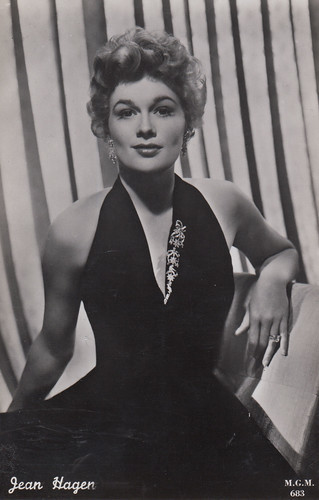
Dutch postcard by Int. Filmphoto Service, Amsterdam-C., no. 683. Photo: M.G.M. Collection: Marlene Pilaete.
Jean Hagen (1923-1977) was a versatile star, equally good in the classic Film Noir The Asphalt Jungle (1950) and the famous musical Singin' in the Rain (1952). The Disney studios featured her in The Shaggy Dog (1959), in which she played Fred MacMurray’s wife.
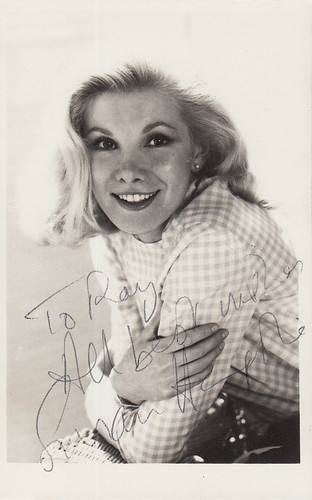
Vintage autographed card. Collection: Marlene Pilaete.
For TV audiences, the name of Susan Hampshire (1937) will forever be associated with the hugely popular BBC series The Forsyte Saga (1967), as the spoiled and wayward Fleur. On the big screen, she played alongside Orson Welles in Belgian director Harry Kümel’s Malpertuis (1971), based on a Jean Ray fantasy novel, and she notably portrayed the famous wildlife activist Joy Adamson in Living Free (1972). She also starred in The Three Lives of Tomasina (1963) and The Fighting Prince of Donegal (1966), two Disney features filmed in the U.K.
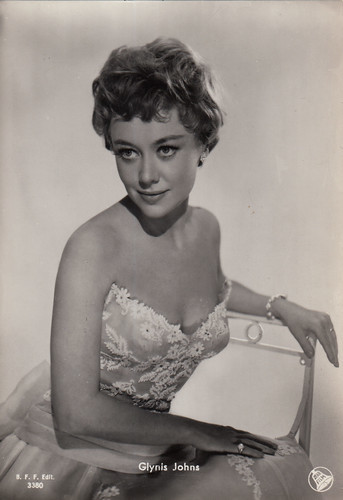
Italian postcard by B.F.F. Edit., no. 3380. Photo: Dear Film. Collection: Marlene Pilaete.
Charming star Glynis Johns (1923) was featured in two 1953 Walt Disney British adventure films, The Sword and the Rose (1953) and Rob Roy (1953). Later, she worked again for Disney with the role of Mrs. Banks in Mary Poppins (1964). Other highlights in her career include Miranda (1948), The Card (1952), The Sundowners (1960) or The Chapman Report (1962).
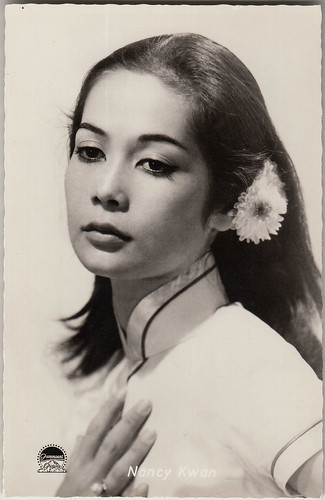
German postcard by Kolibri-Verlag G.m.b.H., no. 1827. Photo: Paramount. Collection: Marlene Pilaete.
Nancy Kwan (1939) became famous thanks to her title role in The World of Suzie Wong (1960). She later played a South Sea beauty in Lt. Robin Crusoe, U.S.N. (1966), produced by the Walt Disney studios and loosely based on the famous Daniel Defoe novel, 'Robinson Crusoe'.
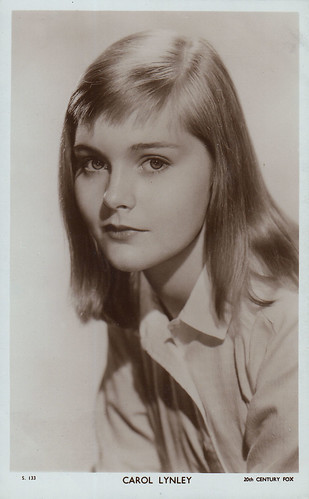
British postcard in the Picturegoer Series, London, no. S 133. Photo: 20th Century Fox. Collection: Marlene Pilaete.
Carol Lynley (1942-2019) made her film debut by playing the love interest of James McArthur in Walt Disney’s The Light in the Forest (1958). Later films include Otto Preminger’s Bunny Lake is Missing (1965) and the disaster movie The Poseidon Adventure (1972).
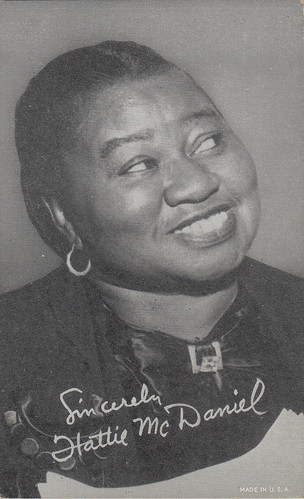
American Arcade postcard. Collection: Marlene Pilaete.
Hattie McDaniel (1893-1952) won an Academy Award in the Best Supporting Actress category for Gone With the Wind (1939). She was the first black performer to ever receive an Oscar. She played a maid called Aunt Tempy in Disney’s Song of the South (1946). The movie caused much controversy in its day and was accused of perpetuating racial stereotypes. Hattie McDaniel herself was criticized for having accepted such a role and, deeply hurt, she publicly made it clear that she found those attacks, especially from the NAACP, most unfair.
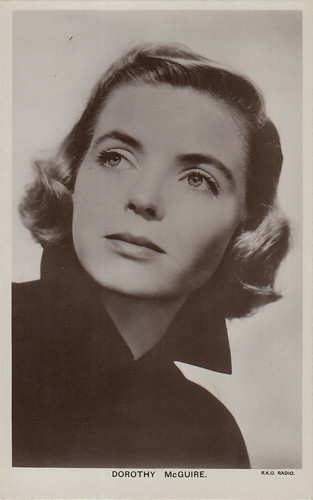
British postcard in the Picturegoer Series, London, no. W223. Photo: R.K.O. Radio. Collection: Marlene Pilaete.
Dorothy McGuire (1916-2001) won praise for her sensitive portrayals in films such as Claudia (1943), The Enchanted Cottage (1945), A Tree Grows in Brooklyn (1945), The Spiral Staircase (1946), Till the End of Time (1946), Gentleman’s Agreement (1947) or Friendly Persuasion (1956). With her quiet beauty and soothing cinematographic personality, she perfectly played mother roles in Disney’s Old Yeller (1957), Swiss Family Robinson (1960), and Summer Magic (1963).
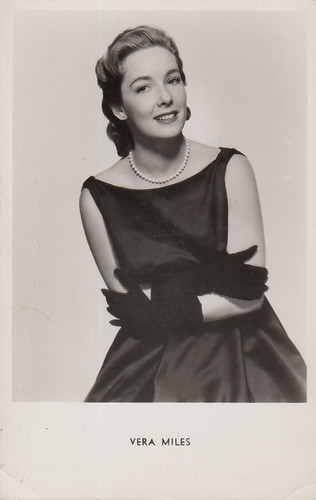
Vintage postcard no. 5052. Photo: R.K.O. Radio. Collection: Marlene Pilaete.
Vera Miles (1929) was one of those Hitchcock’s blonde heroines in The Wrong Man (1956) and Psycho (1960). John Ford also gave her interesting roles in The Searchers (1956) and The Man Who Shot Liberty Valance (1962). For Disney, she played mothers in A Tiger Walks (1964) and Those Calloways (1965) and was the object of Fred MacMurray’s affection in Follow Me Boys! (1966). The Disney studios seemed to like her very much as, after Walt’s death, they used her again in The Wild Country (1970), One Little Indian (1973), and The Castaway Cowboy (1974).
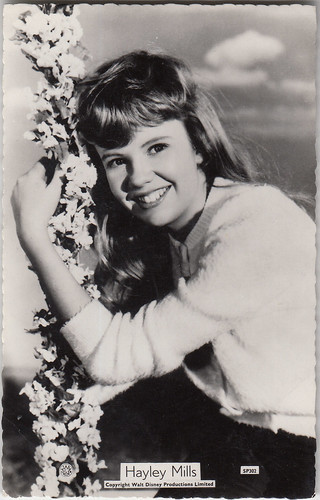
British postcard in the Star Pics series, no. SP302. Photo: Walt Disney Productions Limited. Collection: Marlene Pilaete.
Hayley Mills (1946) was a major box office draw for the Disney studios in the first half of the 1960s. She starred in Pollyanna (1960), The Parent Trap (1961), In Search of the Castaways (1962), Summer Magic (1963), The Moon-Spinners (1964), and That Darn Cat (1965). She later broke away from her clean Disney image by appearing for example in The Family Way (1966), in which she had a brief nude scene, and the controversial thriller Twisted Nerve (1968). In the 1980s, she worked again for the Disney studios by reprising her role in three TV movies which were sequels to one of her greatest successes: The Parent Trap II (1986), Parent Trap III (1989), and Parent Trap: Hawaiian Honeymoon (1989).
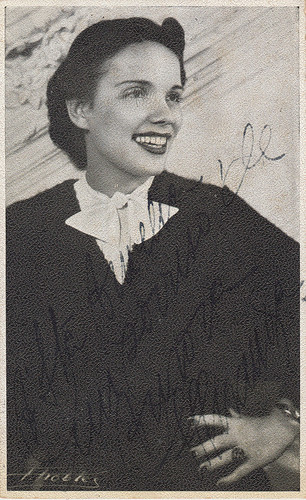
Vintage Brazilian autographed card. Photo: F. Robles. Collection: Marlene Pilaete.
Aurora Miranda (1915-2005) was Carmen Miranda’s sister and was a star in her own right in her native country, Brazil. When Walt Disney produced The Three Caballeros (1944), as part of the Good Neighbor policy towards Latin America initiated by Roosevelt, it was only natural that she would be featured in it. And the Brazilian segment perfectly showcased her dancing and singing talents.
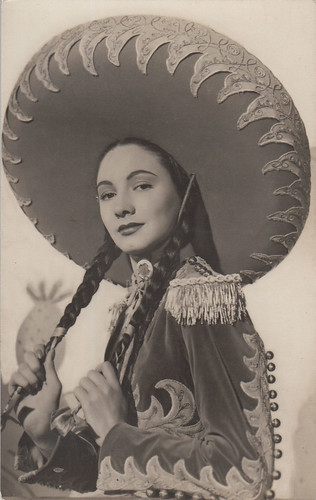
Spanish postcard by Soberanas, Barcelona, no. 283. Collection: Marlene Pilaete.
Carmen Molina (1920-1998) was a popular actress during the Golden Age of Mexican Cinema and played opposite such great names as Emilio Fernandez, Pedro Infante, German Valdes, or Arturo de Cordova. She was one of her native country‘s representatives in Disney’s The Three Caballeros (1944), in which she makes a great impression on Donald Duck, who shares two musical numbers with her.
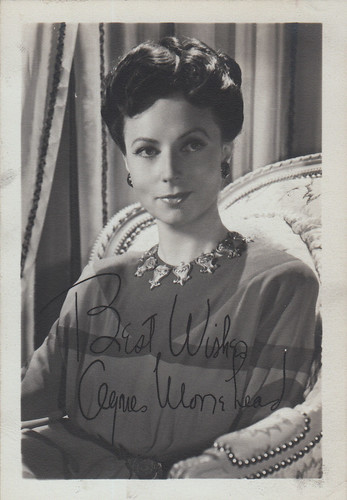
American fan card with facsimile autograph. This has been dated January 1946 on the back by a previous owner. Collection: Marlene Pilaete.
Everybody remembers Agnes Moorehead (1900-1974) as Endora in the TV series Bewitched (1964-1972). At the beginning of her brilliant career, she appeared in two classics directed by Orson Welles: Citizen Kane (1941), as Kane’s mother, and The Magnificent Ambersons (1942), as spinster aunt Fanny. Among scores of other interesting performances, is that of the grouchy and hypochondriac Mrs. Snow in Walt Disney’s Pollyanna (1960).
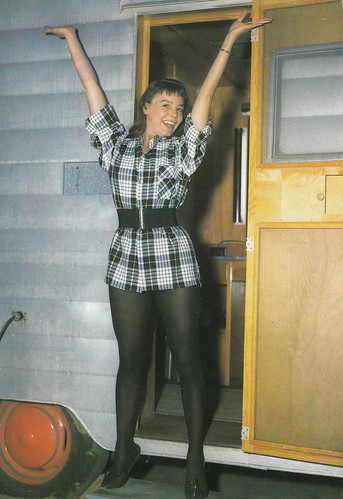
Spanish postcard by Oscarcolor S.L., no. 23. Collection: Marlene Pilaete.
Cute English actress Janet Munro (1934-1972) was signed by Walt Disney at the end of the 1950s and became famous thanks to Darby O’Gill and the Little People (1959), Third Man on the Mountain (1959), and Swiss Family Robinson (1960). For Disney, she was also featured in The Horsemasters (1961), which was shown on TV in the U.S.A. and released in the cinemas in the U.K. Wanting to escape from her wholesome Disney image, she later handled more dramatic roles, such as in Life for Ruth (1962) or Bitter Harvest (1963). Sadly, she died from heart disease in 1972.
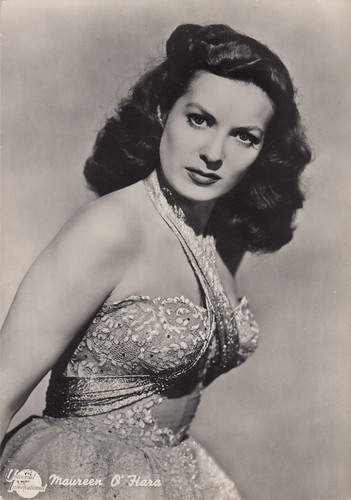
Italian postcard by Bromofoto, Milano, no. 297. Photo: Universal International. Collection: Marlene Pilaete.
Irish-born Maureen O’Hara (1920-2015) was said to have been John Ford’s favorite actress, although their relationship seems to have been quite stormy at times. He directed her in How Green Was My Valley (1941), Rio Bravo (1950), The Quiet Man (1952), The Long Gray Line (1955), and The Wings of Eagles (1957). She also made a perfect film couple with John Wayne, who appreciated her very much. From the end of the 1930s to the mid-1960s, this fiery redhead starred in 50 films. For Disney, she played the mother of Hayley Mills in the smash hit The Parent Trap (1961).
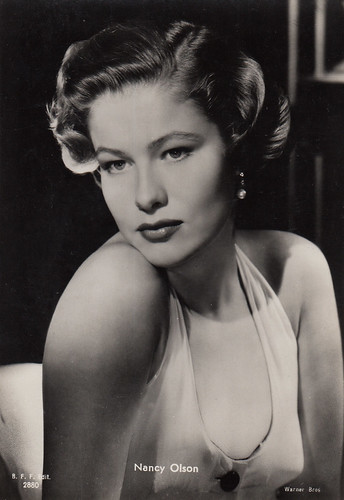
Italian postcard by B.F.F. Edit., no. 2880. Photo: Warner Bros. Collection: Marlene Pilaete.
Nancy Olson (1928) made a splash in Hollywood in 1950 thanks to the classic Sunset Boulevard (1950), the crime drama Union Station (1950), and the musical Mr. Music (1950). For Disney, she played an empathetic maid in Pollyanna (1960), Fred MacMurray’s love interest in The Absent-Minded Professor (1961), and his wife in the sequel, Son of Flubber (1963). After Walt’s death, she came back to the Disney studios for Smith (1969) and Snowball Express (1972). She also had an uncredited cameo in the Robin Williams vehicle Flubber (1997), a remake of The Absent-Minded Professor.
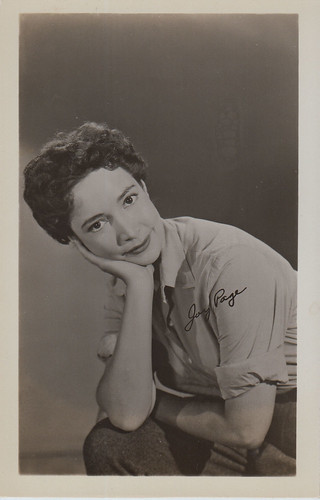
Vintage American postcard. Collection: Marlene Pilaete.
Joy Page (1924-2008) played Sal Mineo’s wise Native-American mother in Tonka (1958). She is probably better remembered by filmgoers as Annina Brandel, the young refugee contemplating giving herself to Claude Rains to obtain a visa in the classic Casablanca (1942). Her exotic looks, which she inherited from her father, actor Don Alvarado, also enabled her to play an Indian jungle girl in Man-Eater of Kumaon (1948), a Mexican senorita in The Bullfighter and the Lady (1951) or an Italian resistance fighter in Fighter Attack (1953).
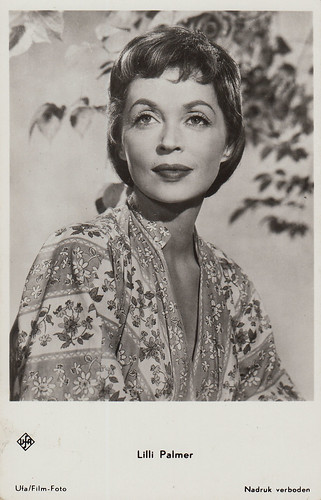
Dutch postcard. Photo: Ufa/Film-Foto. Collection: Marlene Pilaete.
During her long and brilliant career, international star Lilli Palmer (1914-1986) worked mostly in British, American, German, and French films. She won the Best Actress Volpi Cup for The Four-Poster (1952) and was awarded two Deutscher Filmpreis awards in the same category for Teufel in Seide (1955) and Anastasia - Die letzte zarentochter (1956). She was also Robert Taylor’s wife in Disney’s The Miracle of White Stallions (1963), filmed in Austria. In 2018, Netflix released The Other Side of the Wind, the last movie directed by Orson Welles, which was left unfinished by his death in 1985. In it, Lilli Palmer played an actress named Zarah Valeska, a role allegedly intended for Marlene Dietrich.
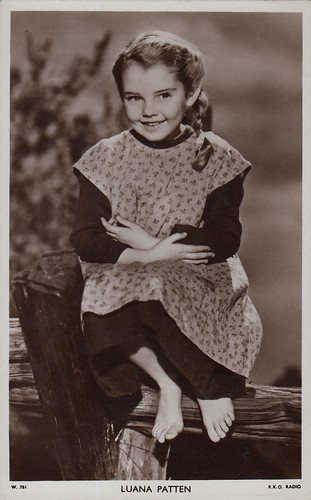
British postcard in the Picturegoer Series, no. W. 781. Photo: R.K.O. Radio. Collection: Marlene Pilaete.
Child star Luana Patten (1938-1996) appeared in the Disney productions Song of the South (1946), Fun and Fancy Free (1947), Melody Time (1948) and So Dear to My Heart (1948). She later became a ravishing young lady and worked again for Disney in Johnny Tremain (1957) and Follow Me Boys! (1966).
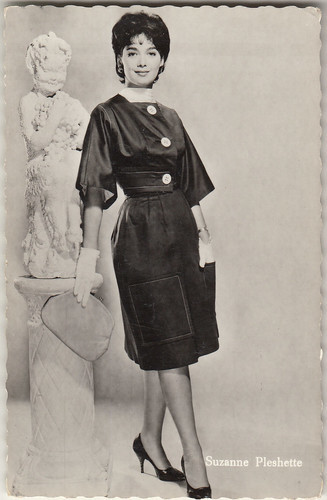
Dutch postcard, no. 1062. Collection: Marlene Pilaete.
A lovely brunette 1960s star, Suzanne Pleshette (1937-2008) will forever be remembered as the ill-fated Annie Hayworth in Hitchcock’s horror classic The Birds (1963). She played the wife of Dean Jones in Disney’s The Ugly Dachshund (1966). After Walt’s death, she worked again for the Disney studios in The Adventures of Bullwhip Griffin (1967), Blackbeard’s Ghost (1968), and The Shaggy D.A. (1976).
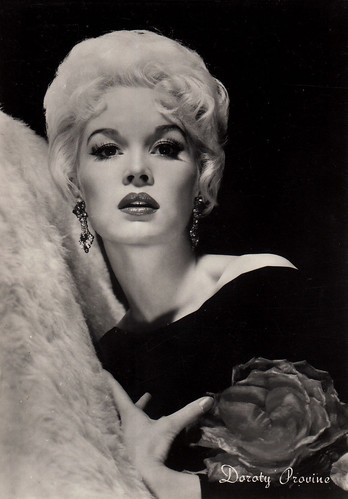
Italian postcard by Rotalfoto, Milano, no 1047. Collection: Marlene Pilaete.
Nine years before Faye Dunaway, Dorothy Provine (1935-2010) played the most famous female bank robber of all time in The Bonnie Parker Story (1958). She was also part of the all-star cast of Stanley Kramer’s comedy It’s a Mad, Mad, Mad, Mad World (1963). For the Disney studios, she was the older sister of Hayley Mills in That Darn Cat (1965), in which she is courted by a pompous and insufferable neighbour played by Roddy McDowall.
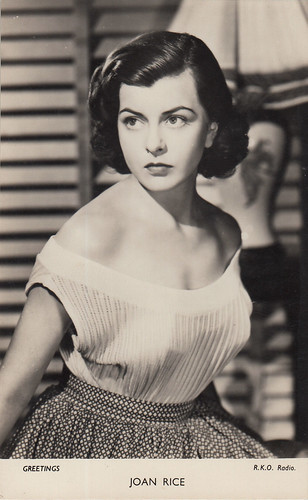
British postcard in the Greetings series. Photo: R.K.O. Radio. Collection: Marlene Pilaete.
Joan Rice (1930-1997) played Maid Marian in Story of Robin Hood (1952), a Walt Disney British production. But her best-known film is probably His Majesty O’Keefe (1954), co-starring Burt Lancaster.
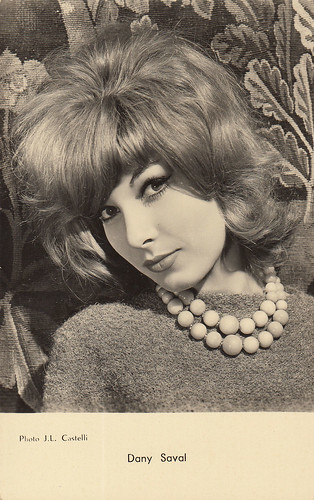
French postcard by Editions P.I., no. 1132. Photo: J.L. Castelli. Collection: Marlene Pilaete.
French star Dany Saval (1942) played a cute extra-terrestrial in Moon Pilot (1962). Three years later, American audiences had a second opportunity to enjoy her piquant charm in Paramount’s comedy Boeing Boeing (1965), in which she co-starred with Tony Curtis and Jerry Lewis.
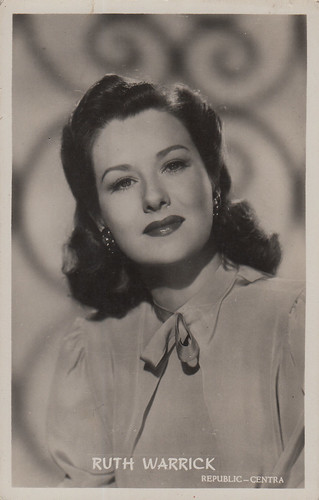
Dutch postcard. Photo: Republic / Centra. Collection: Marlene Pilaete.
Ruth Warrick (1916-2005) will forever be best remembered as the first wife of Orson Welles in the classic Citizen Kane (1941). Later, she played Bobby Driscoll’s mother in Disney’s Song of the South (1946).

Italian postcard by B.F.F. Edit., no. 2691. Photo: Paramount Films. Collection: Marlene Pilaete.
Jane Wyman (1917-2007) won an Academy Award in the Best Actress category for her performance as a deaf-mute in Johnny Belinda (1948). During her career, this great star, who was given a “World Film Favorite” Henrietta Award in 1951, worked twice for the Disney studios. She played the stern and dictatorial Aunt Polly, whose goodness is brought out in full by the cheerful heroine, in Pollyanna (1960). Two years later, she was Fred MacMurray’s wife and a mother of two in the comedy Bon Voyage! (1962).
Text: Marlene Pilaete. Check out Marlene's other La Collectionneuse posts.

Mexican postcard by Sello, no. 230. Collection: Marlene Pilaete.
Julie Andrews (1935) won a best actress Academy Award for her film debut in Walt Disney’s Mary Poppins (1964). Her third film, The Sound of Music (1965), was also a huge box office hit for 20th Century Fox. Some fifteen years later, she won praise for her portrayal in Victor/Victoria (1982). Later in her career, she came back to the Disney studios for The Princess Diaries (2001) and The Princess Diaries II (2004). In 2003, she also appeared in two episodes of the TV series The World of Disney.

Italian postcard by Ediz. G. Ratti, Torino. Collection: Marlene Pilaete.
Joanne Dru (1922-1996) was a John Ford heroine in She Wore a Yellow Ribbon (1949) and Wagon Master (1950). Among her other westerns are Red River (1948), directed by Howard Hawks, Vengeance Valley (1951), The Siege at Red River (1954) or Drango (1957). She was also Fess Parker’s love interest in Disney’s Light in the Forest (1958). During her career, she played other kinds of roles, most notably in All the King’s Men (1949), which won a Best Picture Oscar. On the campy side, she was a secretary secretly in love with her boss, Liberace, in Sincerely Yours (1955), the movie which failed to make a movie star of this flamboyant and hugely popular pianist.

Postcard by Editions P.I. Produced for the Canadian company Photos-Vedettes. Collection: Marlene Pilaete.
Under contract with Disney, Annette Funicello (1942-2013) became one of the most renowned performers of the TV program The Mickey Mouse Club from 1955 to 1958. The Disney studios cashed on her popularity by featuring her on the big screen in four films: The Shaggy Dog (1959), Babes in Toyland (1961), The Misadventures of Merlin Jones (1964), and The Monkey’s Uncle (1965). At the same time, she continued her TV career, for example in The Horsemasters (1961) and several episodes of Zorro. Annette Funicello was also famous for the teen-oriented beach movies she made for the A.I.P. Company such as Beach Party (1963), Muscle Beach Party (1964), or Beach Blanket Bingo (1965).

Dutch postcard by Int. Filmphoto Service, Amsterdam-C., no. 683. Photo: M.G.M. Collection: Marlene Pilaete.
Jean Hagen (1923-1977) was a versatile star, equally good in the classic Film Noir The Asphalt Jungle (1950) and the famous musical Singin' in the Rain (1952). The Disney studios featured her in The Shaggy Dog (1959), in which she played Fred MacMurray’s wife.

Vintage autographed card. Collection: Marlene Pilaete.
For TV audiences, the name of Susan Hampshire (1937) will forever be associated with the hugely popular BBC series The Forsyte Saga (1967), as the spoiled and wayward Fleur. On the big screen, she played alongside Orson Welles in Belgian director Harry Kümel’s Malpertuis (1971), based on a Jean Ray fantasy novel, and she notably portrayed the famous wildlife activist Joy Adamson in Living Free (1972). She also starred in The Three Lives of Tomasina (1963) and The Fighting Prince of Donegal (1966), two Disney features filmed in the U.K.

Italian postcard by B.F.F. Edit., no. 3380. Photo: Dear Film. Collection: Marlene Pilaete.
Charming star Glynis Johns (1923) was featured in two 1953 Walt Disney British adventure films, The Sword and the Rose (1953) and Rob Roy (1953). Later, she worked again for Disney with the role of Mrs. Banks in Mary Poppins (1964). Other highlights in her career include Miranda (1948), The Card (1952), The Sundowners (1960) or The Chapman Report (1962).

German postcard by Kolibri-Verlag G.m.b.H., no. 1827. Photo: Paramount. Collection: Marlene Pilaete.
Nancy Kwan (1939) became famous thanks to her title role in The World of Suzie Wong (1960). She later played a South Sea beauty in Lt. Robin Crusoe, U.S.N. (1966), produced by the Walt Disney studios and loosely based on the famous Daniel Defoe novel, 'Robinson Crusoe'.

British postcard in the Picturegoer Series, London, no. S 133. Photo: 20th Century Fox. Collection: Marlene Pilaete.
Carol Lynley (1942-2019) made her film debut by playing the love interest of James McArthur in Walt Disney’s The Light in the Forest (1958). Later films include Otto Preminger’s Bunny Lake is Missing (1965) and the disaster movie The Poseidon Adventure (1972).

American Arcade postcard. Collection: Marlene Pilaete.
Hattie McDaniel (1893-1952) won an Academy Award in the Best Supporting Actress category for Gone With the Wind (1939). She was the first black performer to ever receive an Oscar. She played a maid called Aunt Tempy in Disney’s Song of the South (1946). The movie caused much controversy in its day and was accused of perpetuating racial stereotypes. Hattie McDaniel herself was criticized for having accepted such a role and, deeply hurt, she publicly made it clear that she found those attacks, especially from the NAACP, most unfair.

British postcard in the Picturegoer Series, London, no. W223. Photo: R.K.O. Radio. Collection: Marlene Pilaete.
Dorothy McGuire (1916-2001) won praise for her sensitive portrayals in films such as Claudia (1943), The Enchanted Cottage (1945), A Tree Grows in Brooklyn (1945), The Spiral Staircase (1946), Till the End of Time (1946), Gentleman’s Agreement (1947) or Friendly Persuasion (1956). With her quiet beauty and soothing cinematographic personality, she perfectly played mother roles in Disney’s Old Yeller (1957), Swiss Family Robinson (1960), and Summer Magic (1963).

Vintage postcard no. 5052. Photo: R.K.O. Radio. Collection: Marlene Pilaete.
Vera Miles (1929) was one of those Hitchcock’s blonde heroines in The Wrong Man (1956) and Psycho (1960). John Ford also gave her interesting roles in The Searchers (1956) and The Man Who Shot Liberty Valance (1962). For Disney, she played mothers in A Tiger Walks (1964) and Those Calloways (1965) and was the object of Fred MacMurray’s affection in Follow Me Boys! (1966). The Disney studios seemed to like her very much as, after Walt’s death, they used her again in The Wild Country (1970), One Little Indian (1973), and The Castaway Cowboy (1974).

British postcard in the Star Pics series, no. SP302. Photo: Walt Disney Productions Limited. Collection: Marlene Pilaete.
Hayley Mills (1946) was a major box office draw for the Disney studios in the first half of the 1960s. She starred in Pollyanna (1960), The Parent Trap (1961), In Search of the Castaways (1962), Summer Magic (1963), The Moon-Spinners (1964), and That Darn Cat (1965). She later broke away from her clean Disney image by appearing for example in The Family Way (1966), in which she had a brief nude scene, and the controversial thriller Twisted Nerve (1968). In the 1980s, she worked again for the Disney studios by reprising her role in three TV movies which were sequels to one of her greatest successes: The Parent Trap II (1986), Parent Trap III (1989), and Parent Trap: Hawaiian Honeymoon (1989).

Vintage Brazilian autographed card. Photo: F. Robles. Collection: Marlene Pilaete.
Aurora Miranda (1915-2005) was Carmen Miranda’s sister and was a star in her own right in her native country, Brazil. When Walt Disney produced The Three Caballeros (1944), as part of the Good Neighbor policy towards Latin America initiated by Roosevelt, it was only natural that she would be featured in it. And the Brazilian segment perfectly showcased her dancing and singing talents.

Spanish postcard by Soberanas, Barcelona, no. 283. Collection: Marlene Pilaete.
Carmen Molina (1920-1998) was a popular actress during the Golden Age of Mexican Cinema and played opposite such great names as Emilio Fernandez, Pedro Infante, German Valdes, or Arturo de Cordova. She was one of her native country‘s representatives in Disney’s The Three Caballeros (1944), in which she makes a great impression on Donald Duck, who shares two musical numbers with her.

American fan card with facsimile autograph. This has been dated January 1946 on the back by a previous owner. Collection: Marlene Pilaete.
Everybody remembers Agnes Moorehead (1900-1974) as Endora in the TV series Bewitched (1964-1972). At the beginning of her brilliant career, she appeared in two classics directed by Orson Welles: Citizen Kane (1941), as Kane’s mother, and The Magnificent Ambersons (1942), as spinster aunt Fanny. Among scores of other interesting performances, is that of the grouchy and hypochondriac Mrs. Snow in Walt Disney’s Pollyanna (1960).

Spanish postcard by Oscarcolor S.L., no. 23. Collection: Marlene Pilaete.
Cute English actress Janet Munro (1934-1972) was signed by Walt Disney at the end of the 1950s and became famous thanks to Darby O’Gill and the Little People (1959), Third Man on the Mountain (1959), and Swiss Family Robinson (1960). For Disney, she was also featured in The Horsemasters (1961), which was shown on TV in the U.S.A. and released in the cinemas in the U.K. Wanting to escape from her wholesome Disney image, she later handled more dramatic roles, such as in Life for Ruth (1962) or Bitter Harvest (1963). Sadly, she died from heart disease in 1972.

Italian postcard by Bromofoto, Milano, no. 297. Photo: Universal International. Collection: Marlene Pilaete.
Irish-born Maureen O’Hara (1920-2015) was said to have been John Ford’s favorite actress, although their relationship seems to have been quite stormy at times. He directed her in How Green Was My Valley (1941), Rio Bravo (1950), The Quiet Man (1952), The Long Gray Line (1955), and The Wings of Eagles (1957). She also made a perfect film couple with John Wayne, who appreciated her very much. From the end of the 1930s to the mid-1960s, this fiery redhead starred in 50 films. For Disney, she played the mother of Hayley Mills in the smash hit The Parent Trap (1961).

Italian postcard by B.F.F. Edit., no. 2880. Photo: Warner Bros. Collection: Marlene Pilaete.
Nancy Olson (1928) made a splash in Hollywood in 1950 thanks to the classic Sunset Boulevard (1950), the crime drama Union Station (1950), and the musical Mr. Music (1950). For Disney, she played an empathetic maid in Pollyanna (1960), Fred MacMurray’s love interest in The Absent-Minded Professor (1961), and his wife in the sequel, Son of Flubber (1963). After Walt’s death, she came back to the Disney studios for Smith (1969) and Snowball Express (1972). She also had an uncredited cameo in the Robin Williams vehicle Flubber (1997), a remake of The Absent-Minded Professor.

Vintage American postcard. Collection: Marlene Pilaete.
Joy Page (1924-2008) played Sal Mineo’s wise Native-American mother in Tonka (1958). She is probably better remembered by filmgoers as Annina Brandel, the young refugee contemplating giving herself to Claude Rains to obtain a visa in the classic Casablanca (1942). Her exotic looks, which she inherited from her father, actor Don Alvarado, also enabled her to play an Indian jungle girl in Man-Eater of Kumaon (1948), a Mexican senorita in The Bullfighter and the Lady (1951) or an Italian resistance fighter in Fighter Attack (1953).

Dutch postcard. Photo: Ufa/Film-Foto. Collection: Marlene Pilaete.
During her long and brilliant career, international star Lilli Palmer (1914-1986) worked mostly in British, American, German, and French films. She won the Best Actress Volpi Cup for The Four-Poster (1952) and was awarded two Deutscher Filmpreis awards in the same category for Teufel in Seide (1955) and Anastasia - Die letzte zarentochter (1956). She was also Robert Taylor’s wife in Disney’s The Miracle of White Stallions (1963), filmed in Austria. In 2018, Netflix released The Other Side of the Wind, the last movie directed by Orson Welles, which was left unfinished by his death in 1985. In it, Lilli Palmer played an actress named Zarah Valeska, a role allegedly intended for Marlene Dietrich.

British postcard in the Picturegoer Series, no. W. 781. Photo: R.K.O. Radio. Collection: Marlene Pilaete.
Child star Luana Patten (1938-1996) appeared in the Disney productions Song of the South (1946), Fun and Fancy Free (1947), Melody Time (1948) and So Dear to My Heart (1948). She later became a ravishing young lady and worked again for Disney in Johnny Tremain (1957) and Follow Me Boys! (1966).

Dutch postcard, no. 1062. Collection: Marlene Pilaete.
A lovely brunette 1960s star, Suzanne Pleshette (1937-2008) will forever be remembered as the ill-fated Annie Hayworth in Hitchcock’s horror classic The Birds (1963). She played the wife of Dean Jones in Disney’s The Ugly Dachshund (1966). After Walt’s death, she worked again for the Disney studios in The Adventures of Bullwhip Griffin (1967), Blackbeard’s Ghost (1968), and The Shaggy D.A. (1976).

Italian postcard by Rotalfoto, Milano, no 1047. Collection: Marlene Pilaete.
Nine years before Faye Dunaway, Dorothy Provine (1935-2010) played the most famous female bank robber of all time in The Bonnie Parker Story (1958). She was also part of the all-star cast of Stanley Kramer’s comedy It’s a Mad, Mad, Mad, Mad World (1963). For the Disney studios, she was the older sister of Hayley Mills in That Darn Cat (1965), in which she is courted by a pompous and insufferable neighbour played by Roddy McDowall.

British postcard in the Greetings series. Photo: R.K.O. Radio. Collection: Marlene Pilaete.
Joan Rice (1930-1997) played Maid Marian in Story of Robin Hood (1952), a Walt Disney British production. But her best-known film is probably His Majesty O’Keefe (1954), co-starring Burt Lancaster.

French postcard by Editions P.I., no. 1132. Photo: J.L. Castelli. Collection: Marlene Pilaete.
French star Dany Saval (1942) played a cute extra-terrestrial in Moon Pilot (1962). Three years later, American audiences had a second opportunity to enjoy her piquant charm in Paramount’s comedy Boeing Boeing (1965), in which she co-starred with Tony Curtis and Jerry Lewis.

Dutch postcard. Photo: Republic / Centra. Collection: Marlene Pilaete.
Ruth Warrick (1916-2005) will forever be best remembered as the first wife of Orson Welles in the classic Citizen Kane (1941). Later, she played Bobby Driscoll’s mother in Disney’s Song of the South (1946).

Italian postcard by B.F.F. Edit., no. 2691. Photo: Paramount Films. Collection: Marlene Pilaete.
Jane Wyman (1917-2007) won an Academy Award in the Best Actress category for her performance as a deaf-mute in Johnny Belinda (1948). During her career, this great star, who was given a “World Film Favorite” Henrietta Award in 1951, worked twice for the Disney studios. She played the stern and dictatorial Aunt Polly, whose goodness is brought out in full by the cheerful heroine, in Pollyanna (1960). Two years later, she was Fred MacMurray’s wife and a mother of two in the comedy Bon Voyage! (1962).
Text: Marlene Pilaete. Check out Marlene's other La Collectionneuse posts.
Published on December 25, 2020 15:58
December 23, 2020
Directed by Alfred Hitchcock
British director Alfred Hitchcock (1899-1980) was known as 'The Master of Suspense'. He was one of the most influential and extensively studied filmmakers in the history of cinema. 'Hitch' had his first major success with The Lodger (1926), a silent thriller loosely based on Jack the Ripper. Hitchcock came to international attention with The Man Who Knew Too Much (1934), The 39 Steps (1935), and, most notably, The Lady Vanishes (1938). His first Hollywood film was the multi-Oscar-winning psychological thriller Rebecca (1940). Many classics followed including Spellbound (1945), Notorious (1946), Rear Window (1954), North by Northwest (1959), and The Birds (1963). In a career spanning six decades, he directed over 50 feature films which garnered a total of 46 Oscar nominations and 6 wins.
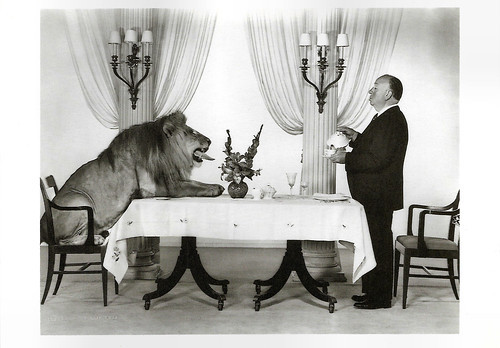
British postcard in the Black & Whites Gallery by Foto-Roff, London, no. 1255. Photo: Clarence Sinclair Bull / Kobal Collection, 1957. Caption: How many sugars?
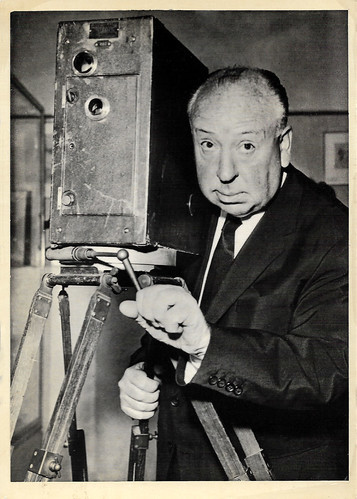
French postcard by Editions Gendre in the Alfred Hitchcock series, no. 6. Photo: Keystone. Caption: Alfred Hitchcock and the first Pathé camera.
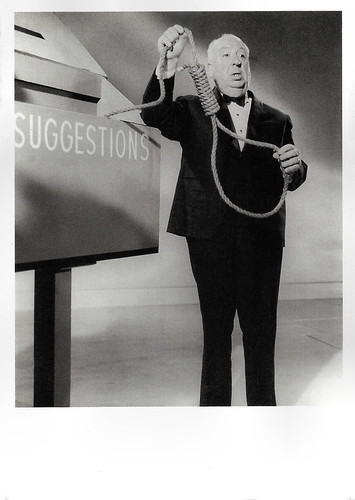
French postcard in the collection Magie Noire by Editions Hazan, no. 6489. Photo: Collection Dominique Lebrun D.R. Alfred Hitchcock promoting Rope (Alfred Hitchcock, 1948).
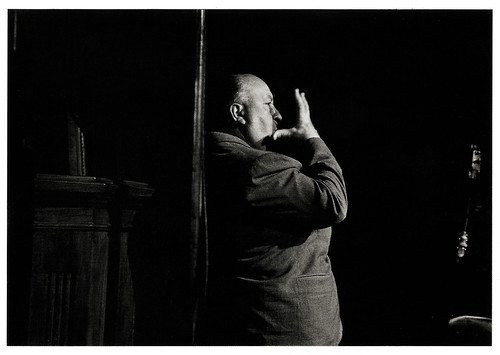
Swiss postcard by CVB Publishers / News Productions, Grandson, no. CP 46, 1996. Photo: Sam Shaw, 1953.
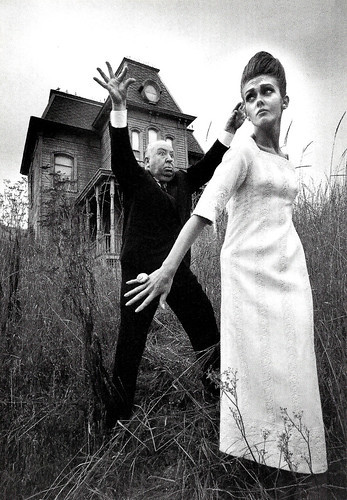
French postcard by Editions du désastre, Boulogne, no. JS 16, 1986. Photo: JeanLoup Sieff. Caption: Alfred Hitchcock. Hollywood, 1962. This photo was made at the set of Psycho (1960) for an article in Harper's Bazar. The name of the model was Ina.
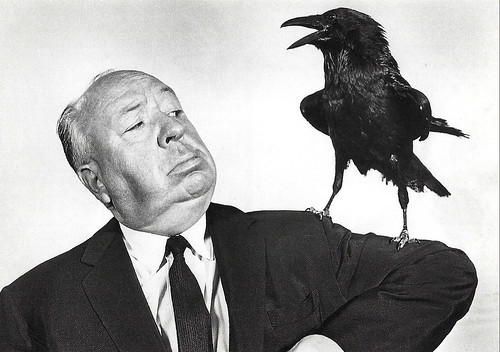
French postcard in the Collection Cinéma by Editions Art & Scene, Paris, no. CA 103, 1996. Alfred Hitchcock at the set of The Birds (1963).
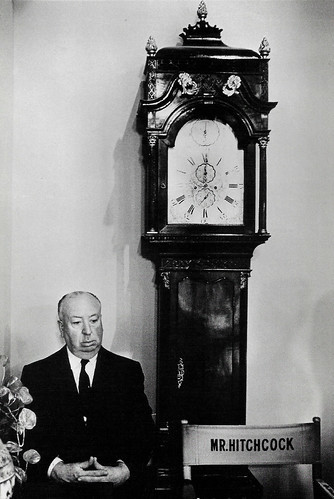
British postcard by ACME Cards, London, no. BW5. Photo: Bob Willoughby, 1964. Alfred Hitchcock on the set of Marnie (1964).
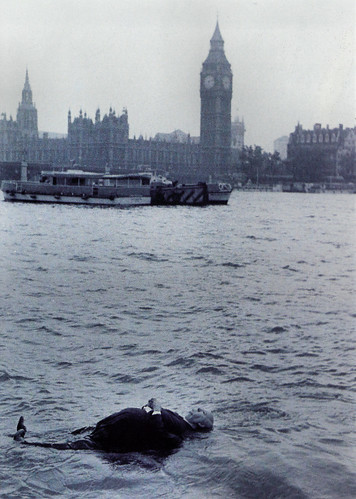
German postcard by Edition Tushita, no. B 491. Photo: Interphoto. Alfred Hitchcock in Frenzy (Alfred Hitchcock, 1972).
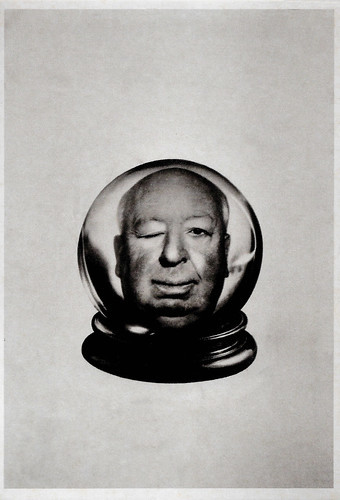
French postcard by Editions 'Humour à la Carte", Paris, no. ST-5. Photo: Alfred Hitchcock promoting Family Plot (Alfred Hitchcock, 1976). Sent by mail in 1986.
The quintessential English 'Hitchcock blonde'
Alfred Joseph Hitchcock was born in Leytonstone, on the outskirts of east London, in 1899. He was the son of Emma Jane Whelan and East End greengrocer William Hitchcock. His parents were both of half English and half Irish ancestry. He had two older siblings, William and Eileen Hitchcock. Raised as a strict Catholic and attending Saint Ignatius College, a school run by Jesuits, Hitch had very much of a regular upbringing.
In 1914, his father died. To support himself and his mother—his older siblings had left home by then—Hitchcock took a job in 1915 as an estimator for the Henley Telegraph and Cable Company. His interest in films began at around this time, frequently visiting the cinema and reading US trade journals.
In a trade paper, he read that Famous Players-Lasky, the production arm of Paramount Pictures, was opening a studio in London. They were planning to film 'The Sorrows of Satan' by Marie Corelli, so Hitch produced some drawings for the title cards and sent his work to the studio. They hired him, and in 1919 he began working for Islington Studios as a title-card designer.
Hitchcock soon gained experience as a co-writer, art director, and production manager on at least 18 silent films. After Hugh Croise, the director for Always Tell Your Wife (1923) fell ill, Hitchcock and star and producer Seymour Hicks finished the film together.
When Paramount pulled out of London in 1922, Hitchcock was hired as an assistant director by a new firm run in the same location by Michael Balcon, later known as Gainsborough Pictures. He began to collaborate with the editor and script girl Alma Reville, his future wife.
He worked as an assistant to director Graham Cutts on several films, including The Blackguard (1924), which was produced at the Babelsberg Studios in Potsdam. There Hitchcock watched part of the making of F. W. Murnau's film Der letzte Mann/The Last Laugh (1924). He was impressed with Murnau's work and later used many of his techniques for the set design in his own productions.
In the summer of 1925, Balcon asked Hitchcock to direct The Pleasure Garden (1925), starring Virginia Valli , a co-production of Gainsborough and the German firm Emelka. Reville, by then Hitchcock's fiancée, was assistant director-editor.
In 1927, Hitchcock made his first trademark film, the thriller The Lodger: A Story of the London Fog (1927) starring Ivor Novello . The Lodger is about the hunt for a serial killer who, wearing a black cloak and carrying a black bag, is murdering young blonde women in London, and only on Tuesdays. The Lodger was a commercial and critical success in the UK.
In the same year, Hitchcock married Alma Reville. They had one child, Patricia Hitchcock (1928). Reville became her husband's closest collaborator and wrote or co-wrote on many of his films.
Hitchcock made the transition to sound film with his tenth film, Blackmail (1929), the first British 'talkie'. Blackmail began the Hitchcock tradition of using famous landmarks as a backdrop for suspense sequences, with the climax taking place on the dome of the British Museum. He used an early sound recording as a special element of the film, stressing the word "knife" in a conversation with the woman ( Anny Ondra ) suspected of murder. It was followed by Murder! (1930).
In 1933 Hitchcock was once again working for Michael Balcon at Gaumont-British on The Man Who Knew Too Much (1934). It was a success. His second, The 39 Steps (1935), with Robert Donat , made him a star in the USA. It also established the quintessential English 'Hitchcock blonde' ( Madeleine Carroll ) as the template for his succession of ice-cold, elegant leading ladies. His next major success was The Lady Vanishes (1938), with Margaret Lockwood and Michael Redgrave . The film saw Hitchcock receive the 1938 New York Film Critics Circle Award for Best Director.
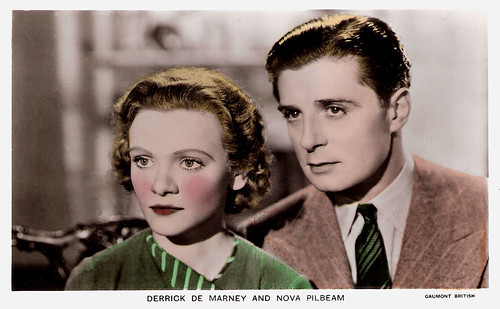
British hand-coloured postcard in the Film Partners Series, no PC 236. Photo: Gaumont British. Derrick De Marney and Nova Pilbeam in Young and Innocent/The Girl Was Young (Alfred Hitchcock, 1937).
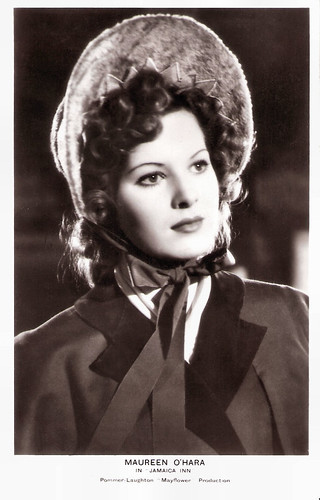
British postcard, London, no. FS 200. Photo: Pommer-Laughton 'Mayflower' production. Maureen O'Hara in Jamaica Inn (Alfred Hitchcock, 1939).
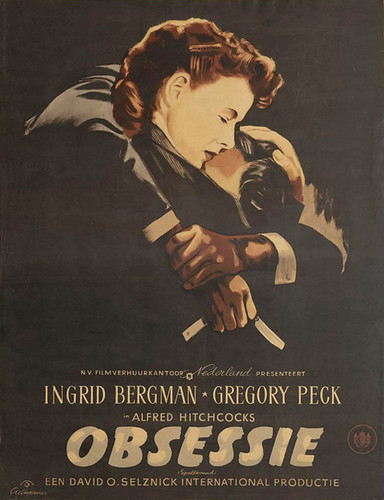
Dutch film poster by Ad Werner for the film Spellbound (Alfred Hitchcock, 1945). Pictured are Ingrid Bergman and Gregory Peck.
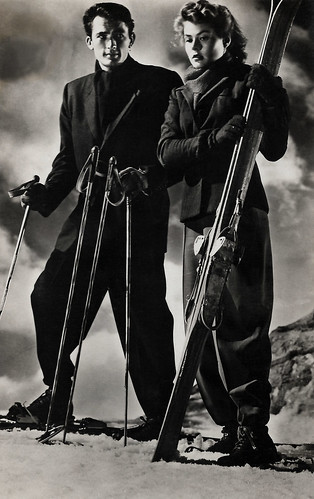
Spanish postcard, editor unknown, sent 1951. Ingrid Bergman and Gregory Peck in Spellbound (Alfred Hitchcock, 1945).
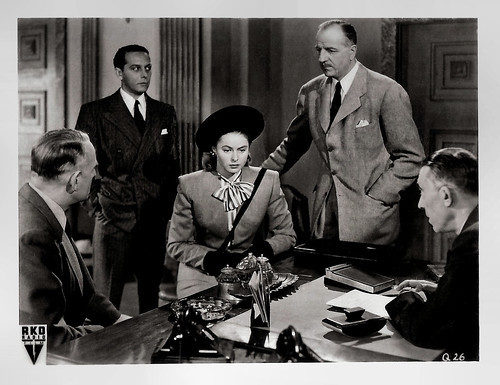
German collectors card. Photo: RKO Radio Film. Ingrid Bergman and Louis Calhern in Notorious (Alfred Hitchcock, 1946).
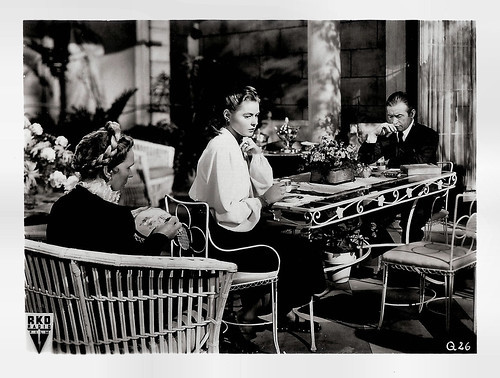
German collectors card. Photo: RKO Radio Film. Ingrid Bergman , Claude Rains, and Leopoldine Konstantin in Notorious (Alfred Hitchcock, 1946).
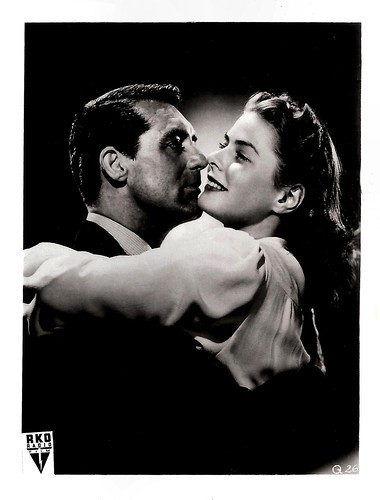
German collectors card. Photo: RKO Radio Film. Ingrid Bergman and Cary Grant in Notorious (Alfred Hitchcock, 1946).
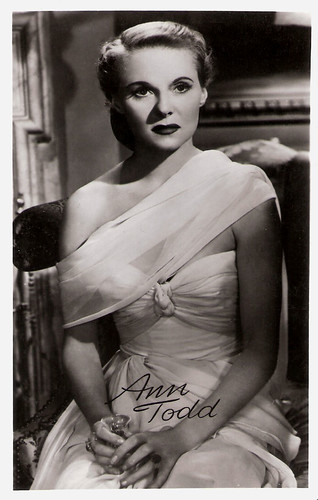
Dutch postcard, no. a.x. 206. Photo: Film en Toneel. Ann Todd in The Paradine Case (Alfred Hitchcock, 1947).
The Pygmalion-like obsessions of a man who crafts a woman into the woman he desires
David O. Selznick signed Hitchcock to a seven-year contract beginning in March 1939, and the Hitchcocks moved to Hollywood. He directed an adaptation of Daphne du Maurier's Rebecca (1940), starring Joan Fontaine and Laurence Olivier . Rebecca won the Oscar for Best Picture, although Hitchcock himself was only nominated as Best Director.
Hitchcock's second American film was the thriller Foreign Correspondent (1940), set in Europe, and produced by Walter Wanger. It was nominated for Best Picture that year Suspicion (1941) was the first of four projects on which Cary Grant worked with Hitchcock, and it is one of the rare occasions that Grant was cast in a sinister role. In one scene Hitchcock placed a light inside a glass of milk, perhaps poisoned, that Grant is bringing to his wife, played by Joan Fontaine. The light makes sure that the audience's attention is on the glass. Fontaine won the Best Actress Oscar for her performance.
Shadow of a Doubt (1943) was Hitchcock's personal favourite. Charlotte "Charlie" Newton (Teresa Wright) suspects her beloved uncle Charlie Oakley (Joseph Cotten) of being a serial killer. Hitchcock was again nominated for the Oscar for Best Director for Lifeboat (1944) and Spellbound (1945), but he never won the award. Spellbound (1945), starring Ingrid Bergman and Gregory Peck, explores psychoanalysis and features a dream sequence designed by Salvador Dalí. Notorious (1946) stars Ingrid Bergman and Cary Grant, both Hitchcock regulars, and features a plot about Nazis, uranium, and South America.
After a brief lull of commercial success in the late 1940s, Hitchcock returned to form with Strangers on a Train (1951), based on the novel by Patricia Highsmith. In the film, two men casually meet, one of whom speculates on a foolproof method to murder. He suggests that two people, each wishing to do away with someone, should each perform the other's murder. Farley Granger played the innocent victim of the scheme, while 'boy-next-door' Robert Walker played the villain.
I Confess (1953) was set in Quebec with Montgomery Clift as a Catholic priest. It was followed by three colour films starring Grace Kelly : the 3-D film Dial M for Murder (1954), Rear Window (1954), and To Catch a Thief (1955). From 1955 to 1965, Hitchcock was the host of the television series Alfred Hitchcock Presents. With his droll delivery, gallows humour, and iconic image, the series made Hitchcock a celebrity.
In his films, Hitchcock often used the "mistaken identity" theme, such as in The Wrong Man (1956), and North by Northwest (1959). In Vertigo (1958), James Stewart plays Scottie, a former police investigator suffering from acrophobia. He develops an obsession with a woman he has been hired to shadow (Kim Novak). His obsession leads to tragedy, and this time Hitchcock does not opt for a happy ending. Vertigo is one of his most personal and revealing films, dealing with the Pygmalion-like obsessions of a man who crafts a woman into the woman he desires.
Psycho (1960) was Hitchcock's great shock masterpiece, mostly for its haunting performances by Janet Leigh and Anthony Perkins and its shower scene, and The Birds (1963) became the unintended forerunner to an onslaught of films about nature-gone-mad, and booth films were phenomenally popular. Film companies began to refer to his films as 'Alfred Hitchcock's': Alfred Hitchcock's Psycho (1960), Alfred Hitchcock's Frenzy (1972), and Alfred Hitchcock's Family Plot (1976).
During the making of Frenzy (1972), Hitchcock's wife Alma suffered a paralysing stroke which made her unable to walk very well. In 1979, Hitchcock was knighted, making him Sir Alfred Hitchcock. A year later, in 1980, he died peacefully in his sleep due to renal failure. Hitchcock was survived by his wife and daughter. After the funeral, his body was cremated. His remains were scattered over the Pacific Ocean.
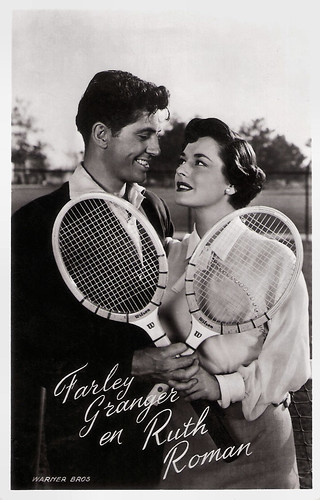
Dutch postcard by Takken, no. 566. Photo: Warner Bros. Farley Granger and Ruth Roman in Strangers on a Train (Alfred Hitchcock, 1951).
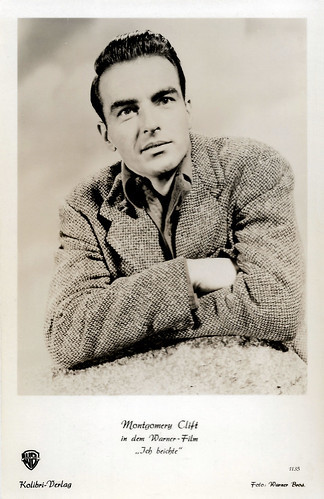
West-German by Kolibri-Verlag, no. 1135. Photo: Warner Bros. Montgomery Clift in I Confess (Alfred Hitchcock, 1953).
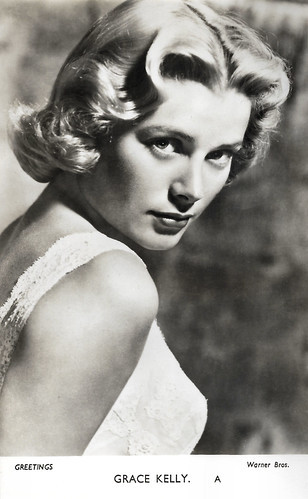
British postcard in the Greetings Series, A. Photo: Warner Bros. Grace Kelly in Dial M for Murder (Alfred Hitchcock, 1954).
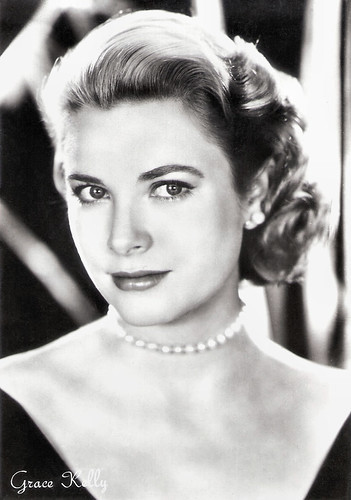
Italian postcard by Rotalfoto, Milano, no. 552. Grace Kelly in Rear Window (Alfred Hitchcock, 1954).
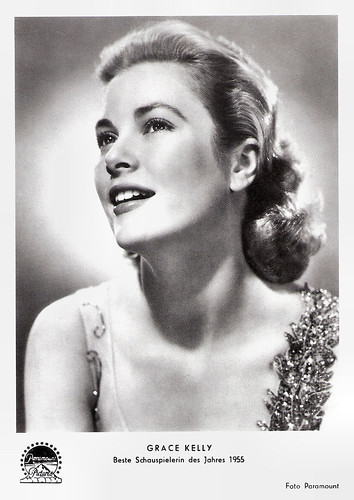
Modern German postcard by K & B / Filmwelt Berlin Archiv für Film-Geschichte, no. KB 55. Photo: Paramount. Grace Kelly in To Catch a Thief (Alfred Hitchcock, 1955). Caption: Best Actress of the Year 1955.
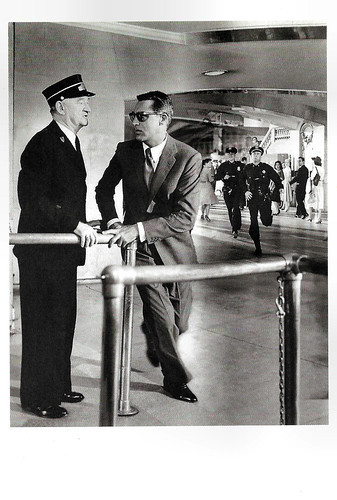
French postcard in the Collection Noire by Editions Hazan, Paris, no. 6492, 1996. Photo: Collection Dominique Lebrun D.R. Cary Grant in North by Northwest (Alfred Hitchcock, 1959).
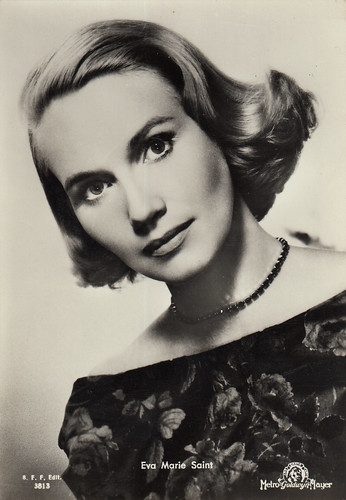
Italian postcard by B.F.F. Edit., no. 3813. Photo: Metro-Goldwyn-Mayer. Collection: Marlene Pilaete. Eva Marie Saint (1924) was the leading lady of Alfred Hitchcock's North by Northwest (1959).
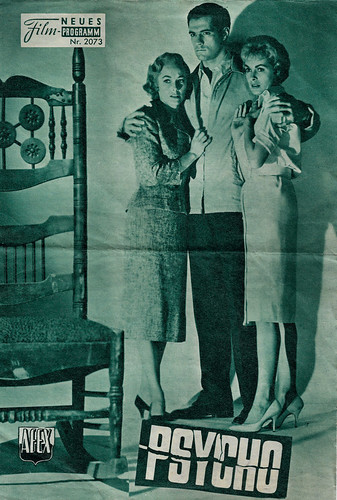
Austrian flyer (front) by Neues Film-programm, no. 2073, October 1960. Photo: Afex. Vera Miles, John Gavin, and Janet Leigh in Psycho (Alfred Hitchcock, 1960).
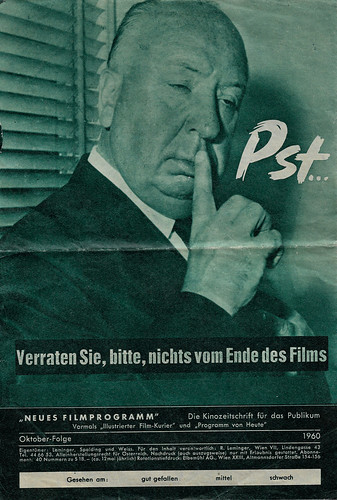
Austrian flyer (back) by Neues Film-programm, no. 2073, October 1960. Photo: Afex. Alfred Hitchcock in the trailer for Psycho (Alfred Hitchcock, 1960). Caption: Pst ... Please don't reveal anything about the end of the film.
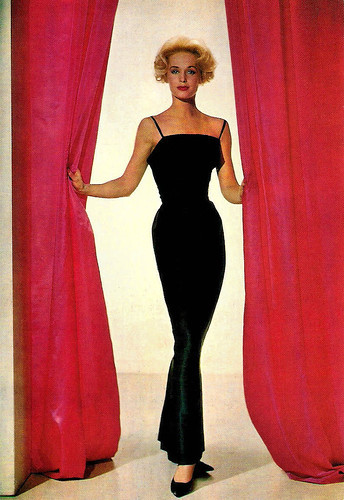
Spanish postcard by Postal Oscarcolor, S.L., no. 9. Tippi Hedren in The Birds (Alfred Hitchcock, 1963).
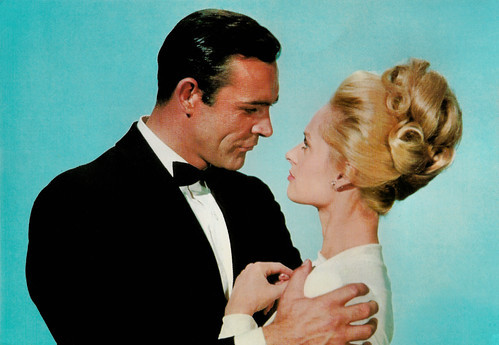
Spanish postcard by Postal Oscarcolor, no. 13. Sean Connery and Tippi Hedren in Marnie (Alfred Hitchcock, 1964).
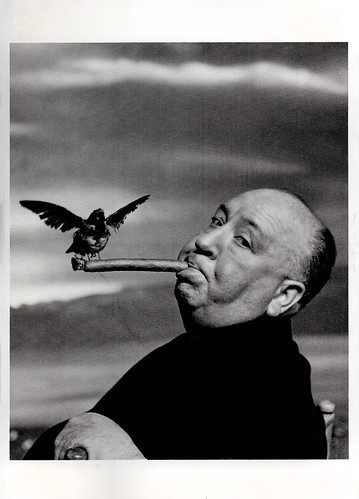
American postcard by Fotofolio, New York, N.Y., no. PH 18, 1981. Photo: Philippe Halsman, 1962 / Hastings Galleries Collection. Alfred Hitchcock at the set of The Birds (1963).
Sources: Bruce Eder (AllMovie), Wikipedia, and IMDb.

British postcard in the Black & Whites Gallery by Foto-Roff, London, no. 1255. Photo: Clarence Sinclair Bull / Kobal Collection, 1957. Caption: How many sugars?

French postcard by Editions Gendre in the Alfred Hitchcock series, no. 6. Photo: Keystone. Caption: Alfred Hitchcock and the first Pathé camera.

French postcard in the collection Magie Noire by Editions Hazan, no. 6489. Photo: Collection Dominique Lebrun D.R. Alfred Hitchcock promoting Rope (Alfred Hitchcock, 1948).

Swiss postcard by CVB Publishers / News Productions, Grandson, no. CP 46, 1996. Photo: Sam Shaw, 1953.

French postcard by Editions du désastre, Boulogne, no. JS 16, 1986. Photo: JeanLoup Sieff. Caption: Alfred Hitchcock. Hollywood, 1962. This photo was made at the set of Psycho (1960) for an article in Harper's Bazar. The name of the model was Ina.

French postcard in the Collection Cinéma by Editions Art & Scene, Paris, no. CA 103, 1996. Alfred Hitchcock at the set of The Birds (1963).

British postcard by ACME Cards, London, no. BW5. Photo: Bob Willoughby, 1964. Alfred Hitchcock on the set of Marnie (1964).

German postcard by Edition Tushita, no. B 491. Photo: Interphoto. Alfred Hitchcock in Frenzy (Alfred Hitchcock, 1972).

French postcard by Editions 'Humour à la Carte", Paris, no. ST-5. Photo: Alfred Hitchcock promoting Family Plot (Alfred Hitchcock, 1976). Sent by mail in 1986.
The quintessential English 'Hitchcock blonde'
Alfred Joseph Hitchcock was born in Leytonstone, on the outskirts of east London, in 1899. He was the son of Emma Jane Whelan and East End greengrocer William Hitchcock. His parents were both of half English and half Irish ancestry. He had two older siblings, William and Eileen Hitchcock. Raised as a strict Catholic and attending Saint Ignatius College, a school run by Jesuits, Hitch had very much of a regular upbringing.
In 1914, his father died. To support himself and his mother—his older siblings had left home by then—Hitchcock took a job in 1915 as an estimator for the Henley Telegraph and Cable Company. His interest in films began at around this time, frequently visiting the cinema and reading US trade journals.
In a trade paper, he read that Famous Players-Lasky, the production arm of Paramount Pictures, was opening a studio in London. They were planning to film 'The Sorrows of Satan' by Marie Corelli, so Hitch produced some drawings for the title cards and sent his work to the studio. They hired him, and in 1919 he began working for Islington Studios as a title-card designer.
Hitchcock soon gained experience as a co-writer, art director, and production manager on at least 18 silent films. After Hugh Croise, the director for Always Tell Your Wife (1923) fell ill, Hitchcock and star and producer Seymour Hicks finished the film together.
When Paramount pulled out of London in 1922, Hitchcock was hired as an assistant director by a new firm run in the same location by Michael Balcon, later known as Gainsborough Pictures. He began to collaborate with the editor and script girl Alma Reville, his future wife.
He worked as an assistant to director Graham Cutts on several films, including The Blackguard (1924), which was produced at the Babelsberg Studios in Potsdam. There Hitchcock watched part of the making of F. W. Murnau's film Der letzte Mann/The Last Laugh (1924). He was impressed with Murnau's work and later used many of his techniques for the set design in his own productions.
In the summer of 1925, Balcon asked Hitchcock to direct The Pleasure Garden (1925), starring Virginia Valli , a co-production of Gainsborough and the German firm Emelka. Reville, by then Hitchcock's fiancée, was assistant director-editor.
In 1927, Hitchcock made his first trademark film, the thriller The Lodger: A Story of the London Fog (1927) starring Ivor Novello . The Lodger is about the hunt for a serial killer who, wearing a black cloak and carrying a black bag, is murdering young blonde women in London, and only on Tuesdays. The Lodger was a commercial and critical success in the UK.
In the same year, Hitchcock married Alma Reville. They had one child, Patricia Hitchcock (1928). Reville became her husband's closest collaborator and wrote or co-wrote on many of his films.
Hitchcock made the transition to sound film with his tenth film, Blackmail (1929), the first British 'talkie'. Blackmail began the Hitchcock tradition of using famous landmarks as a backdrop for suspense sequences, with the climax taking place on the dome of the British Museum. He used an early sound recording as a special element of the film, stressing the word "knife" in a conversation with the woman ( Anny Ondra ) suspected of murder. It was followed by Murder! (1930).
In 1933 Hitchcock was once again working for Michael Balcon at Gaumont-British on The Man Who Knew Too Much (1934). It was a success. His second, The 39 Steps (1935), with Robert Donat , made him a star in the USA. It also established the quintessential English 'Hitchcock blonde' ( Madeleine Carroll ) as the template for his succession of ice-cold, elegant leading ladies. His next major success was The Lady Vanishes (1938), with Margaret Lockwood and Michael Redgrave . The film saw Hitchcock receive the 1938 New York Film Critics Circle Award for Best Director.

British hand-coloured postcard in the Film Partners Series, no PC 236. Photo: Gaumont British. Derrick De Marney and Nova Pilbeam in Young and Innocent/The Girl Was Young (Alfred Hitchcock, 1937).

British postcard, London, no. FS 200. Photo: Pommer-Laughton 'Mayflower' production. Maureen O'Hara in Jamaica Inn (Alfred Hitchcock, 1939).

Dutch film poster by Ad Werner for the film Spellbound (Alfred Hitchcock, 1945). Pictured are Ingrid Bergman and Gregory Peck.

Spanish postcard, editor unknown, sent 1951. Ingrid Bergman and Gregory Peck in Spellbound (Alfred Hitchcock, 1945).

German collectors card. Photo: RKO Radio Film. Ingrid Bergman and Louis Calhern in Notorious (Alfred Hitchcock, 1946).

German collectors card. Photo: RKO Radio Film. Ingrid Bergman , Claude Rains, and Leopoldine Konstantin in Notorious (Alfred Hitchcock, 1946).

German collectors card. Photo: RKO Radio Film. Ingrid Bergman and Cary Grant in Notorious (Alfred Hitchcock, 1946).

Dutch postcard, no. a.x. 206. Photo: Film en Toneel. Ann Todd in The Paradine Case (Alfred Hitchcock, 1947).
The Pygmalion-like obsessions of a man who crafts a woman into the woman he desires
David O. Selznick signed Hitchcock to a seven-year contract beginning in March 1939, and the Hitchcocks moved to Hollywood. He directed an adaptation of Daphne du Maurier's Rebecca (1940), starring Joan Fontaine and Laurence Olivier . Rebecca won the Oscar for Best Picture, although Hitchcock himself was only nominated as Best Director.
Hitchcock's second American film was the thriller Foreign Correspondent (1940), set in Europe, and produced by Walter Wanger. It was nominated for Best Picture that year Suspicion (1941) was the first of four projects on which Cary Grant worked with Hitchcock, and it is one of the rare occasions that Grant was cast in a sinister role. In one scene Hitchcock placed a light inside a glass of milk, perhaps poisoned, that Grant is bringing to his wife, played by Joan Fontaine. The light makes sure that the audience's attention is on the glass. Fontaine won the Best Actress Oscar for her performance.
Shadow of a Doubt (1943) was Hitchcock's personal favourite. Charlotte "Charlie" Newton (Teresa Wright) suspects her beloved uncle Charlie Oakley (Joseph Cotten) of being a serial killer. Hitchcock was again nominated for the Oscar for Best Director for Lifeboat (1944) and Spellbound (1945), but he never won the award. Spellbound (1945), starring Ingrid Bergman and Gregory Peck, explores psychoanalysis and features a dream sequence designed by Salvador Dalí. Notorious (1946) stars Ingrid Bergman and Cary Grant, both Hitchcock regulars, and features a plot about Nazis, uranium, and South America.
After a brief lull of commercial success in the late 1940s, Hitchcock returned to form with Strangers on a Train (1951), based on the novel by Patricia Highsmith. In the film, two men casually meet, one of whom speculates on a foolproof method to murder. He suggests that two people, each wishing to do away with someone, should each perform the other's murder. Farley Granger played the innocent victim of the scheme, while 'boy-next-door' Robert Walker played the villain.
I Confess (1953) was set in Quebec with Montgomery Clift as a Catholic priest. It was followed by three colour films starring Grace Kelly : the 3-D film Dial M for Murder (1954), Rear Window (1954), and To Catch a Thief (1955). From 1955 to 1965, Hitchcock was the host of the television series Alfred Hitchcock Presents. With his droll delivery, gallows humour, and iconic image, the series made Hitchcock a celebrity.
In his films, Hitchcock often used the "mistaken identity" theme, such as in The Wrong Man (1956), and North by Northwest (1959). In Vertigo (1958), James Stewart plays Scottie, a former police investigator suffering from acrophobia. He develops an obsession with a woman he has been hired to shadow (Kim Novak). His obsession leads to tragedy, and this time Hitchcock does not opt for a happy ending. Vertigo is one of his most personal and revealing films, dealing with the Pygmalion-like obsessions of a man who crafts a woman into the woman he desires.
Psycho (1960) was Hitchcock's great shock masterpiece, mostly for its haunting performances by Janet Leigh and Anthony Perkins and its shower scene, and The Birds (1963) became the unintended forerunner to an onslaught of films about nature-gone-mad, and booth films were phenomenally popular. Film companies began to refer to his films as 'Alfred Hitchcock's': Alfred Hitchcock's Psycho (1960), Alfred Hitchcock's Frenzy (1972), and Alfred Hitchcock's Family Plot (1976).
During the making of Frenzy (1972), Hitchcock's wife Alma suffered a paralysing stroke which made her unable to walk very well. In 1979, Hitchcock was knighted, making him Sir Alfred Hitchcock. A year later, in 1980, he died peacefully in his sleep due to renal failure. Hitchcock was survived by his wife and daughter. After the funeral, his body was cremated. His remains were scattered over the Pacific Ocean.

Dutch postcard by Takken, no. 566. Photo: Warner Bros. Farley Granger and Ruth Roman in Strangers on a Train (Alfred Hitchcock, 1951).

West-German by Kolibri-Verlag, no. 1135. Photo: Warner Bros. Montgomery Clift in I Confess (Alfred Hitchcock, 1953).

British postcard in the Greetings Series, A. Photo: Warner Bros. Grace Kelly in Dial M for Murder (Alfred Hitchcock, 1954).

Italian postcard by Rotalfoto, Milano, no. 552. Grace Kelly in Rear Window (Alfred Hitchcock, 1954).

Modern German postcard by K & B / Filmwelt Berlin Archiv für Film-Geschichte, no. KB 55. Photo: Paramount. Grace Kelly in To Catch a Thief (Alfred Hitchcock, 1955). Caption: Best Actress of the Year 1955.

French postcard in the Collection Noire by Editions Hazan, Paris, no. 6492, 1996. Photo: Collection Dominique Lebrun D.R. Cary Grant in North by Northwest (Alfred Hitchcock, 1959).

Italian postcard by B.F.F. Edit., no. 3813. Photo: Metro-Goldwyn-Mayer. Collection: Marlene Pilaete. Eva Marie Saint (1924) was the leading lady of Alfred Hitchcock's North by Northwest (1959).

Austrian flyer (front) by Neues Film-programm, no. 2073, October 1960. Photo: Afex. Vera Miles, John Gavin, and Janet Leigh in Psycho (Alfred Hitchcock, 1960).

Austrian flyer (back) by Neues Film-programm, no. 2073, October 1960. Photo: Afex. Alfred Hitchcock in the trailer for Psycho (Alfred Hitchcock, 1960). Caption: Pst ... Please don't reveal anything about the end of the film.

Spanish postcard by Postal Oscarcolor, S.L., no. 9. Tippi Hedren in The Birds (Alfred Hitchcock, 1963).

Spanish postcard by Postal Oscarcolor, no. 13. Sean Connery and Tippi Hedren in Marnie (Alfred Hitchcock, 1964).

American postcard by Fotofolio, New York, N.Y., no. PH 18, 1981. Photo: Philippe Halsman, 1962 / Hastings Galleries Collection. Alfred Hitchcock at the set of The Birds (1963).
Sources: Bruce Eder (AllMovie), Wikipedia, and IMDb.
Published on December 23, 2020 22:00
December 22, 2020
Claude Brasseur (1936-2020)
French character actor Claude Brasseur died yesterday, 22 December 2020. Coming from a dynasty of comedians and actors, the actor has appeared in more than a hundred films and numerous plays and received two Cesars. He died in peace and serenity surrounded by his family, at the age of 84.
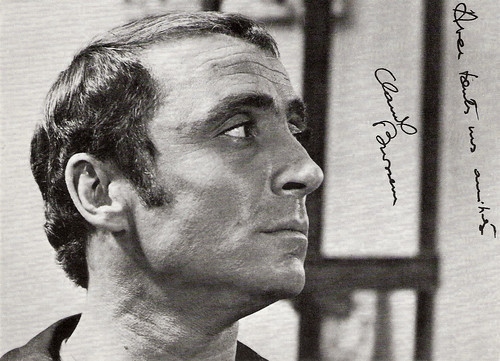
French postcard by La Roue Tourne, Paris / Imp. Rivier, no. 961-14-01.
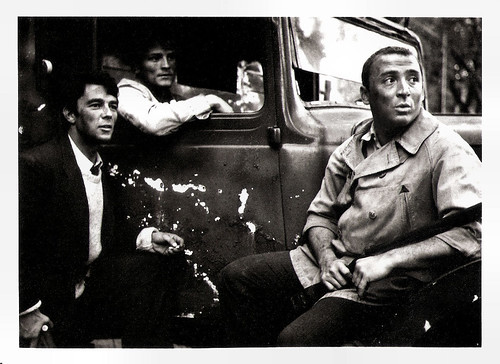
French postcard by Edition Librairie de la Fontaine, Paris, no. 141 (limited edition of 250 ex.). Photo: Claude Schwartz / Spadem. Gérard Blain , Jacques Perrin and Claude Brasseur in Un homme de trop/Shock Troops (Costa-Gravas, 1966).
"You cannot remain a journalist with a name like that"
Claude Brasseur born as Claude Pierre Espinasse, in Neuilly-sur-Seine, France, in 1936. He was the son of the film actors Pierre Brasseur and Odette Joyeux .
Claude grew up surrounded by French celebrities, Malraux, Jouvet, Sartre, Casarès. His godfather was Ernest Hemingway, who was a friend of his father. His childhood was a painful memory: his parents did never take care of him. His egocentric parents separated very quickly. Odette Joyeux retained such bad memories of Pierre Brasseur that she resented her son for adopting his pseudonym, Brasseur.
Jean-Luc Douin in Le Monde : "'Brasseur Father and Son, House founded in 1820': the subtitle of the memoirs 'Merci !, Flammarion', he published in 2014, underlines the importance in his eyes of having belonged to a dynasty. His real name Claude Espinasse, the man who became popular by playing Vidocq for television in the early 1970s will therefore have inherited a family pseudonym."
The first Brasseur was Jules Dumont, a clerk who converted to the stage, comic actor, and founder of the Théâtre des Nouvelles. His son Albert became a star of the Théâtre du Palais-Royal. he was the father of Pierre Brasseur , the unforgettable seducer of Arletty in Marcel Carné's classic film Les Enfants du Paradis/Children of Paradise (1945).
In boarding school, Claude Brasseur met Philippe Noiret , the future actor, and Jacques Mesrine, the future gangster. He did not focus on his studies and the boy didn't dare to admit that he wanted to be an actor. His father helped him to become a journalist at Paris Match and an assistant to photographer Walter Carone.
During an interview with actress Elvire Popesco , his destiny changes. Popescu told him: "You cannot remain a journalist with a name like that. You have to be an actor!" Popescu had just bought the Théâtre de Paris and offered him a contract. In 1955, he appeared in three small roles in Marcel Pagnol's 'Judas' that Popesco staged. After that, Brasseur entered the Conservatory and started to play in the cinema. In 1959, he was the son of Jean Gabin and a track cyclist in Rue des prairies/Rue de Paris (Denys de La Patellière, 1959).
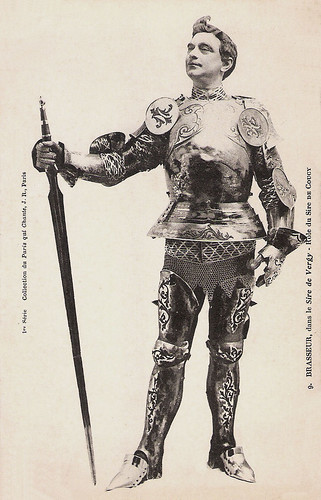
Albert Brasseur. French postcard in the first series of the Collection Paris qui chante by J.R., Paris, no. 9. Photo: publicity still for the original stage production of the operetta Sire de Vergy (1903) with Albert Brasseur as Sire de Coucy.
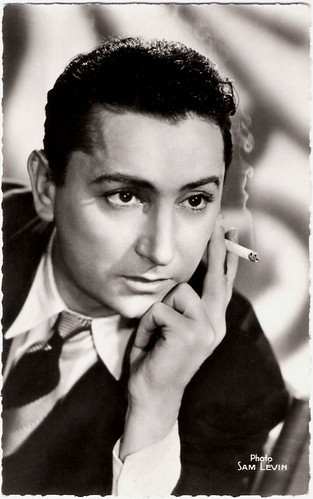
Pierre Brasseur . French postcard by Editions du Globe, no. 125. Photo: Sam Lévin.
Acting opposite his real and fictitious father
Claude and Pierre Brasseur met on the set of the horror film Les Yeux sans visage/Eyes Without a Face (Georges Franju, 1960) and again on the set of the crime film Lucky Jo (Michel Deville,1964) with Eddie Constantine , in which the real father played a fictitious father. Although the two men failed each other on an emotional level, Claude respected the career of his father.
Claude played a big role in the comedy Le Caporal épinglé/The Elusive Corporal (Jean Renoir, 1962), starring Jean-Pierre Cassel . One of his first well-known film roles was as Arthur in the Nouvelle Vague classic Bande à part (Jean-Luc Godard, 1964) with Anna Karina and Sami Frey .
His other films included the French-Italian drama Un homme de trop/Shock Troops (Costa-Gavras, 1967) with Charles Vanel , Une belle fille comme moi/A Gorgeous Kid Like Me (François Truffaut, 1972), starring Bernadette Lafont , and the romantic thriller Barocco (André Téchiné, 1976), starring Isabelle Adjani and Gérard Depardieu .
Claude Brasseur played the title role in the popular historical crime series Les nouvelles aventures de Vidocq/The New Adventures of Vidocq (1971-1973). Brasseur starred as Eugène François Vidocq, an early nineteenth-century criminal turned crime-fighter.
He co-starred with Jean Rochefort and Guy Bedos in the comedy Un éléphant ça trompe énormément/Pardon Mon Affaire (Yves Robert, 1976), later remade in Hollywood as The Woman in Red (1984). For his role he won a César Award - the French Oscar. Brasseur won another César for his leading role in the police drama La guerre des polices/The Police War (Robin Davis, 1980) with Claude Rich and Marlène Jobert.
Big international box-office hits were the comedies La Boum/The Party (Claude Pinoteau, 1980) and La Boum 2/The Party 2 (Claude Pinoteau, 1982), in which he played the father of Sophie Marceau 's teenage character. Brasseur was a regular participant as co-driver in the Paris-Dakar Rally. He won the Paris-Dakar Rally in 1983 as co-driver of Jacky Ickx.
On-screen, he reunited with Godard for the crime film Détective (Jean-Luc Godard, 1985) with Nathalie Baye and Johnny Hallyday . His final film was the comedy Tout le monde debout/Rolling to You (Franck Dubosc, 2018).
Claude Brasseur died on 22 December 2020. He was not a Covid victim. He will be buried in Paris in accordance with sanitary rules and will rest alongside his father in the Père-Lachaise cemetery in Paris. He was married to Peggy Roche and Michèle Cambon. He was the father of Alexandre Brasseur, with whom he appeared on stage in 2007 in 'My father was right', by Sacha Guitry .
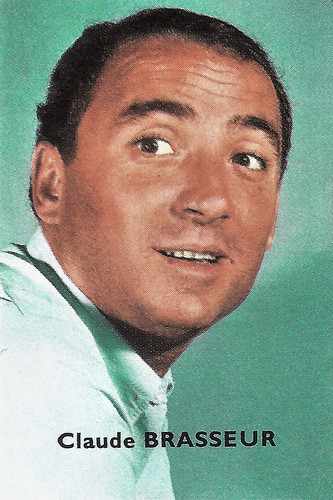
Small Belgian collectors card by Uitg. Best, Antwerp, for Victoria, Brussels, no. 493, Album 3.
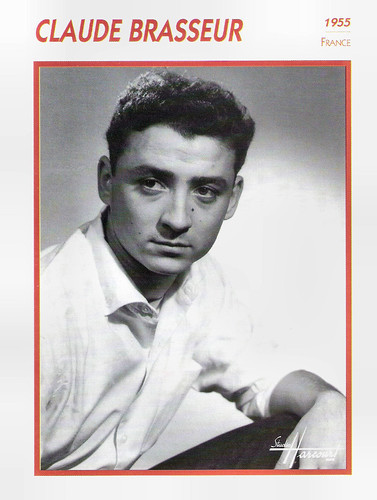
French collectors card in the 'Portrait des Stars: L'encyclopédie du Cinéma' by Edito-Service, 1991, no. D2 482 01-20. Photo: Studio Harcourt.
Sources: Jean-Luc Douin (Le Monde - French), Wikipedia, and .

French postcard by La Roue Tourne, Paris / Imp. Rivier, no. 961-14-01.

French postcard by Edition Librairie de la Fontaine, Paris, no. 141 (limited edition of 250 ex.). Photo: Claude Schwartz / Spadem. Gérard Blain , Jacques Perrin and Claude Brasseur in Un homme de trop/Shock Troops (Costa-Gravas, 1966).
"You cannot remain a journalist with a name like that"
Claude Brasseur born as Claude Pierre Espinasse, in Neuilly-sur-Seine, France, in 1936. He was the son of the film actors Pierre Brasseur and Odette Joyeux .
Claude grew up surrounded by French celebrities, Malraux, Jouvet, Sartre, Casarès. His godfather was Ernest Hemingway, who was a friend of his father. His childhood was a painful memory: his parents did never take care of him. His egocentric parents separated very quickly. Odette Joyeux retained such bad memories of Pierre Brasseur that she resented her son for adopting his pseudonym, Brasseur.
Jean-Luc Douin in Le Monde : "'Brasseur Father and Son, House founded in 1820': the subtitle of the memoirs 'Merci !, Flammarion', he published in 2014, underlines the importance in his eyes of having belonged to a dynasty. His real name Claude Espinasse, the man who became popular by playing Vidocq for television in the early 1970s will therefore have inherited a family pseudonym."
The first Brasseur was Jules Dumont, a clerk who converted to the stage, comic actor, and founder of the Théâtre des Nouvelles. His son Albert became a star of the Théâtre du Palais-Royal. he was the father of Pierre Brasseur , the unforgettable seducer of Arletty in Marcel Carné's classic film Les Enfants du Paradis/Children of Paradise (1945).
In boarding school, Claude Brasseur met Philippe Noiret , the future actor, and Jacques Mesrine, the future gangster. He did not focus on his studies and the boy didn't dare to admit that he wanted to be an actor. His father helped him to become a journalist at Paris Match and an assistant to photographer Walter Carone.
During an interview with actress Elvire Popesco , his destiny changes. Popescu told him: "You cannot remain a journalist with a name like that. You have to be an actor!" Popescu had just bought the Théâtre de Paris and offered him a contract. In 1955, he appeared in three small roles in Marcel Pagnol's 'Judas' that Popesco staged. After that, Brasseur entered the Conservatory and started to play in the cinema. In 1959, he was the son of Jean Gabin and a track cyclist in Rue des prairies/Rue de Paris (Denys de La Patellière, 1959).

Albert Brasseur. French postcard in the first series of the Collection Paris qui chante by J.R., Paris, no. 9. Photo: publicity still for the original stage production of the operetta Sire de Vergy (1903) with Albert Brasseur as Sire de Coucy.

Pierre Brasseur . French postcard by Editions du Globe, no. 125. Photo: Sam Lévin.
Acting opposite his real and fictitious father
Claude and Pierre Brasseur met on the set of the horror film Les Yeux sans visage/Eyes Without a Face (Georges Franju, 1960) and again on the set of the crime film Lucky Jo (Michel Deville,1964) with Eddie Constantine , in which the real father played a fictitious father. Although the two men failed each other on an emotional level, Claude respected the career of his father.
Claude played a big role in the comedy Le Caporal épinglé/The Elusive Corporal (Jean Renoir, 1962), starring Jean-Pierre Cassel . One of his first well-known film roles was as Arthur in the Nouvelle Vague classic Bande à part (Jean-Luc Godard, 1964) with Anna Karina and Sami Frey .
His other films included the French-Italian drama Un homme de trop/Shock Troops (Costa-Gavras, 1967) with Charles Vanel , Une belle fille comme moi/A Gorgeous Kid Like Me (François Truffaut, 1972), starring Bernadette Lafont , and the romantic thriller Barocco (André Téchiné, 1976), starring Isabelle Adjani and Gérard Depardieu .
Claude Brasseur played the title role in the popular historical crime series Les nouvelles aventures de Vidocq/The New Adventures of Vidocq (1971-1973). Brasseur starred as Eugène François Vidocq, an early nineteenth-century criminal turned crime-fighter.
He co-starred with Jean Rochefort and Guy Bedos in the comedy Un éléphant ça trompe énormément/Pardon Mon Affaire (Yves Robert, 1976), later remade in Hollywood as The Woman in Red (1984). For his role he won a César Award - the French Oscar. Brasseur won another César for his leading role in the police drama La guerre des polices/The Police War (Robin Davis, 1980) with Claude Rich and Marlène Jobert.
Big international box-office hits were the comedies La Boum/The Party (Claude Pinoteau, 1980) and La Boum 2/The Party 2 (Claude Pinoteau, 1982), in which he played the father of Sophie Marceau 's teenage character. Brasseur was a regular participant as co-driver in the Paris-Dakar Rally. He won the Paris-Dakar Rally in 1983 as co-driver of Jacky Ickx.
On-screen, he reunited with Godard for the crime film Détective (Jean-Luc Godard, 1985) with Nathalie Baye and Johnny Hallyday . His final film was the comedy Tout le monde debout/Rolling to You (Franck Dubosc, 2018).
Claude Brasseur died on 22 December 2020. He was not a Covid victim. He will be buried in Paris in accordance with sanitary rules and will rest alongside his father in the Père-Lachaise cemetery in Paris. He was married to Peggy Roche and Michèle Cambon. He was the father of Alexandre Brasseur, with whom he appeared on stage in 2007 in 'My father was right', by Sacha Guitry .

Small Belgian collectors card by Uitg. Best, Antwerp, for Victoria, Brussels, no. 493, Album 3.

French collectors card in the 'Portrait des Stars: L'encyclopédie du Cinéma' by Edito-Service, 1991, no. D2 482 01-20. Photo: Studio Harcourt.
Sources: Jean-Luc Douin (Le Monde - French), Wikipedia, and .
Published on December 22, 2020 22:00
December 20, 2020
River Phoenix
American actor River Phoenix (1970-1993) was noted for the depth, sensitivity, and intelligence that he brought to his roles during his teens. He began his acting career at age 10 in television commercials and had his first notable role in the coming-of-age film Stand by Me (1986). Phoenix made a transition into more adult-oriented roles with Running on Empty (1988), which earned him an Oscar nomination for Best Supporting Actor, and My Own Private Idaho (1991), for which he won the Volpi Cup for Best Actor at the Venice Film Festival. He was on the cusp of becoming a major star when he overdosed on drugs and died on Halloween night, 1993. At the time of his death, he was filming Dark Blood, which was released incomplete 19 years later, in 2012.
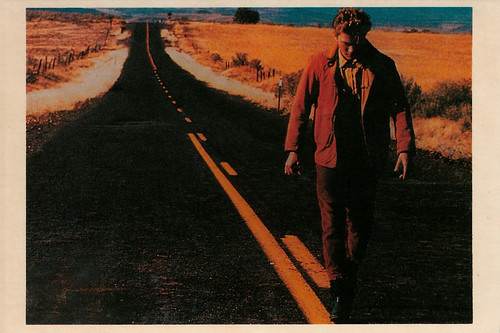
British postcard, no. PC0479. River Phoenix in My Own Private Idaho (Gus Van Sant, 1991).
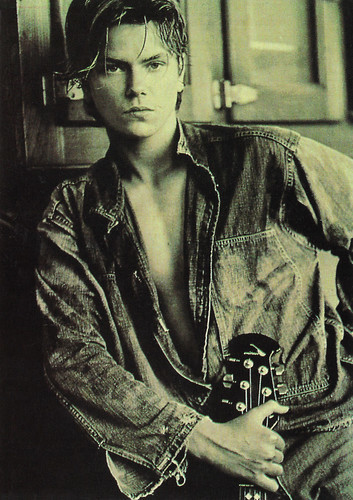
British postcard by Heroes Publishing LTD, London, no. SPC2618. Photo: Lance Staedler, 1987.
The penniless archbishop of Venezuela and the Caribbean
River Phoenix was born River Jude Bottom in 1970, in a log cabin on a mint farm in Madras, Oregan. He was the first child of Arlyn Dunetz and John Bottom. His parents named him after the "river of life" that flowed through Hermann Hesse's novel 'Siddhartha' and for the Beatles ' song 'Hey Jude'.
From the time Phoenix was born, his parents lived the hippie life, moving to several communes until they joined the controversial Children of God cult. They became missionaries for their new church and spent a couple of years wandering Latin America before landing in Venezuela. Phoenix never attended formal school.
Along the way, three more children were born: Rain, Joaquin Rafael (who grew up to be actor Joaquin Phoenix), and Libertad Mariposa. Though John Bottom had been designated the "Archbishop of Venezuela and the Caribbean," he and his family received no missionary funds from their church and lived in poverty. Phoenix and his siblings often sang and performed on street corners for food.
His family hit their lowest point when Phoenix was seven and the penniless brood was forced to move into a beach hut until a local priest showed mercy and arranged for them to be stowed away on a Florida-bound freighter. The crew discovered the family during the voyage but treated them kindly.
Shortly after their arrival in Florida in 1978, the family legally changed its name to Phoenix, after the mythical bird that rises from its own ashes, symbolising a new beginning. While the family was in Florida, another child, Summer Joy Phoenix, was born.
River Phoenix had originally wanted to be a musician and did not become interested in acting until 1979 when he and Rain were spotted in a talent show and invited to audition at Hollywood's Paramount Studios. Believing that the opportunity was worth more than the possible risks involved, the Phoenix family headed West in a battered station wagon.
Their arrival in Burbank was disappointing, as the Paramount people reneged on what the family had believed to be an offer to audition the children. Once again the family was destitute and the children returned to busking for change. Matters improved when agent Iris Burton spotted the four children singing for spare change in Westwood, Los Angeles, and was so charmed by the family that she soon represented the four siblings. She started finding work for Phoenix in television commercials and in series such as Real Kids (1980), for which he and Rain worked as a warm-up act.
Phoenix's first real break came when he won a leading role in the TV series Seven Brides for Seven Brothers (1982) with Richard Dean Anderson. From there, he made guest appearances on such television series as Family Ties and in such TV movies as Robert Kennedy: The Man and His Times (Marvin J. Chomsky, 1985) in which he played Robert Kennedy Jr., and Brad Davis Kennedy's father.
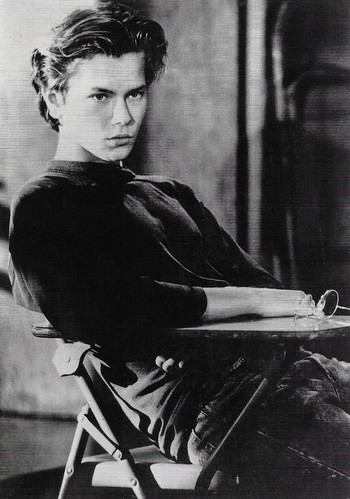
Vintage postcard, no. 1029.
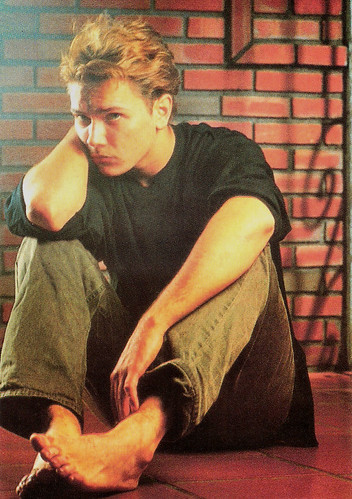
French postcard, Réf. 926.
A stunningly sensitive performance, poignant and comic at once
River Phoenix made his feature-film debut as geeky boy-scientist Wolfgang Müller in the Science-Fiction Fantasy Explorers (Joe Dante, 1985). The film, which also starred a debuting Ethan Hawke, was not a tremendous box-office success, but Phoenix received favourable notices.
He earned even more acclaim in the bittersweet coming-of-age story Stand By Me (Rob Reiner, 1986), based on the novella 'The Body' by Stephen King. The same year, he played opposite Harrison Ford in The Mosquito Coast (Peter Weir, 1986).
By the late 1980s, Phoenix found himself a top-ranked teen idol, having added films like Running on Empty (Sidney Lumet, 1988), Little Nikita (Richard Benhamin, 1988) with Sidney Poitier, and Indiana Jones and the Last Crusade (Steven Spielberg, 1989) to his resumé.
Harrison Ford personally recommended him for the part of the young Indy in Indiana Jones and the Last Crusade (1989) after working with him on The Mosquito Coast (1986). For his part in Running on Empty, he was nominated for an Oscar for Best Supporting Actor and a Golden Globe and received the Best Supporting Actor honor from the National Board of Review.
Phoenix met Keanu Reeves while Reeves was filming Parenthood (Ron Howard, 1989) with Phoenix's brother, Joaquin. Phoenix had reportedly auditioned for the part of Bill in Reeves' Bill & Ted's Excellent Adventure (Stephen Herek, 1989) before the role was taken by Alex Winter. The two starred together for the first time in I Love You to Death (Lawrence Kasdan, 1990).
His breakthrough as an adult actor came when he was cast as a narcoleptic street hustler opposite Reeves in My Own Private Idaho (Gus Van Sant, 1991). In his review for Newsweek, David Ansen praised Phoenix's performance: "The campfire scene in which Mike awkwardly declares his unrequited love for Scott is a marvel of delicacy. In this and every scene, Phoenix immerses himself so deeply inside his character you almost forget you've seen him before: it's a stunningly sensitive performance, poignant and comic at once".
For his role, Phoenix won Best Actor honors at the Venice Film Festival, the National Society of Film Critics, and the Independent Spirit Awards. The film and its success solidified Phoenix's image as an actor with edgy, leading man potential. Allegedly, it was during the production of that film that Phoenix started taking drugs. Before his death, he won further acclaim for roles in the romantic coming-of-age drama Dogfight (Nancy Savoca, 1991) and the espionage thriller Sneakers (Phil Alden Robinson, 1992) with Robert Redford and again with Sidney Poitier.
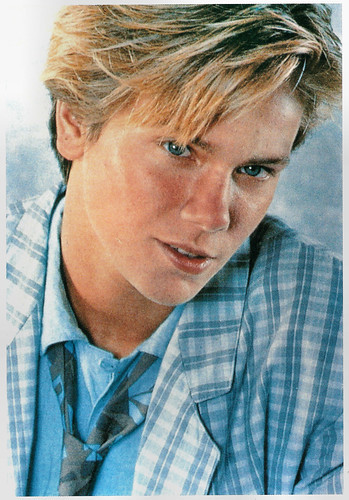
British postcard by Santoro Graphics Ltd., London, no. C 297.
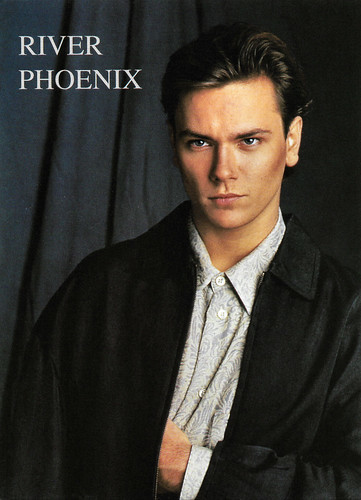
English postcard by Heroes Publishing Ltd., London, no. SPC 2728.
A drug-induced heart failure on the boardwalk outside of the Viper Room
River Phoenix was a dedicated animal-rights activist and environmentalist, and a strict vegetarian, and a member of PETA (People for the Ethical Treatment of Animals). He was also a talented musician. He had played guitar, sang, and wrote songs for his band, Aleka's Attic, which also included his sister Rain Phoenix, while living in Gainsville, Florida.
He sang and played guitar in the country music-themed film The Thing Called Love (Peter Bogdanovich, 1993), the last completed picture before his death. On the set, Phoenix began a relationship with co-star Samantha Mathis.
In late October 1993, Phoenix returned to Los Angeles, only there for 1 day, after flying back from 1 week in New Mexico and before that 6 to 7 weeks in Utah to complete the three weeks of interior shots left on his last project, the American-Dutch thriller Dark Blood (George Sluizer, 1993-2012), with Judy Davis and Jonathan Pryce.
On the evening of 30 October 1993, Phoenix was to perform with the band P; which featured his good friends Johnny Depp , Flea from the Red Hot Chili Peppers, Gibby Haynes of the Butthole Surfers along with Al Jourgensen of Ministry at The Viper Room, a Hollywood nightclub partly owned at the time by Depp.
Later that night Phoenix died of drug-induced heart failure on the boardwalk outside of the Viper Room in the company of Mathis, his sister, Rain, and his brother, Joaquin. He was only 23. Joaquin Phoenix and his partner Rooney Mara later named their son, River, after him.
After 19 years, River's last film, Dark Blood, was finally completed in 2012. For the 2012 release, roughly four to six missing scenes were replaced with director George Sluizer providing narration. It was revealed in October 2011 that Sluizer had held onto the footage, fearing it would be destroyed, and that he had re-edited the material and believed that with some adjustments a completed film could be released. In 1999 the insurance company that owned the negatives wanted to stop paying storage costs, so they considered having the film destroyed. Sluizer entered the storage area that held the negative and removed it.
Geoffrey Macnab from The Guardian: "Dark Blood is fragmentary, uneven and downright odd in parts but it also has huge curiosity value. The director's solution for bridging the considerable gaps is to read out descriptions of what is missing. It's a simple but surprisingly effective tactic. His narration ensures that the film is just about coherent. (...) Phoenix brings a wild physical energy to his role – in truth, his character verges on the preposterous but Phoenix tackles it with such commitment that he just about keeps absurdity at bay."
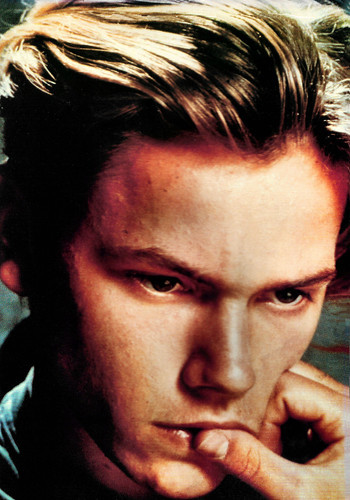
English postcard, no. MM377.

British postcard by Pyramid, Leicester, no. PC0088, 2000.
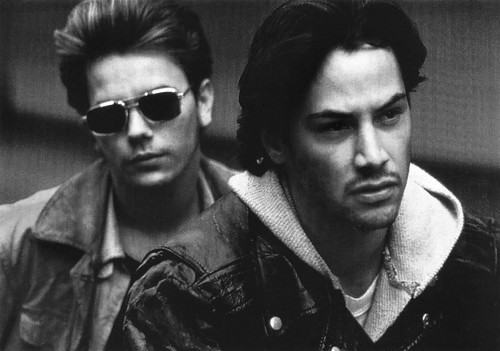
French postcard, no. 1035. Photo: River Phoenix and Keanu Reeves in My Own Private Idaho (Gus Van Sant, 1991).
Sources: Sandra Brennan (AllMovie), Geoffrey Macnab (The Guardian), Wikipedia, and .

British postcard, no. PC0479. River Phoenix in My Own Private Idaho (Gus Van Sant, 1991).

British postcard by Heroes Publishing LTD, London, no. SPC2618. Photo: Lance Staedler, 1987.
The penniless archbishop of Venezuela and the Caribbean
River Phoenix was born River Jude Bottom in 1970, in a log cabin on a mint farm in Madras, Oregan. He was the first child of Arlyn Dunetz and John Bottom. His parents named him after the "river of life" that flowed through Hermann Hesse's novel 'Siddhartha' and for the Beatles ' song 'Hey Jude'.
From the time Phoenix was born, his parents lived the hippie life, moving to several communes until they joined the controversial Children of God cult. They became missionaries for their new church and spent a couple of years wandering Latin America before landing in Venezuela. Phoenix never attended formal school.
Along the way, three more children were born: Rain, Joaquin Rafael (who grew up to be actor Joaquin Phoenix), and Libertad Mariposa. Though John Bottom had been designated the "Archbishop of Venezuela and the Caribbean," he and his family received no missionary funds from their church and lived in poverty. Phoenix and his siblings often sang and performed on street corners for food.
His family hit their lowest point when Phoenix was seven and the penniless brood was forced to move into a beach hut until a local priest showed mercy and arranged for them to be stowed away on a Florida-bound freighter. The crew discovered the family during the voyage but treated them kindly.
Shortly after their arrival in Florida in 1978, the family legally changed its name to Phoenix, after the mythical bird that rises from its own ashes, symbolising a new beginning. While the family was in Florida, another child, Summer Joy Phoenix, was born.
River Phoenix had originally wanted to be a musician and did not become interested in acting until 1979 when he and Rain were spotted in a talent show and invited to audition at Hollywood's Paramount Studios. Believing that the opportunity was worth more than the possible risks involved, the Phoenix family headed West in a battered station wagon.
Their arrival in Burbank was disappointing, as the Paramount people reneged on what the family had believed to be an offer to audition the children. Once again the family was destitute and the children returned to busking for change. Matters improved when agent Iris Burton spotted the four children singing for spare change in Westwood, Los Angeles, and was so charmed by the family that she soon represented the four siblings. She started finding work for Phoenix in television commercials and in series such as Real Kids (1980), for which he and Rain worked as a warm-up act.
Phoenix's first real break came when he won a leading role in the TV series Seven Brides for Seven Brothers (1982) with Richard Dean Anderson. From there, he made guest appearances on such television series as Family Ties and in such TV movies as Robert Kennedy: The Man and His Times (Marvin J. Chomsky, 1985) in which he played Robert Kennedy Jr., and Brad Davis Kennedy's father.

Vintage postcard, no. 1029.

French postcard, Réf. 926.
A stunningly sensitive performance, poignant and comic at once
River Phoenix made his feature-film debut as geeky boy-scientist Wolfgang Müller in the Science-Fiction Fantasy Explorers (Joe Dante, 1985). The film, which also starred a debuting Ethan Hawke, was not a tremendous box-office success, but Phoenix received favourable notices.
He earned even more acclaim in the bittersweet coming-of-age story Stand By Me (Rob Reiner, 1986), based on the novella 'The Body' by Stephen King. The same year, he played opposite Harrison Ford in The Mosquito Coast (Peter Weir, 1986).
By the late 1980s, Phoenix found himself a top-ranked teen idol, having added films like Running on Empty (Sidney Lumet, 1988), Little Nikita (Richard Benhamin, 1988) with Sidney Poitier, and Indiana Jones and the Last Crusade (Steven Spielberg, 1989) to his resumé.
Harrison Ford personally recommended him for the part of the young Indy in Indiana Jones and the Last Crusade (1989) after working with him on The Mosquito Coast (1986). For his part in Running on Empty, he was nominated for an Oscar for Best Supporting Actor and a Golden Globe and received the Best Supporting Actor honor from the National Board of Review.
Phoenix met Keanu Reeves while Reeves was filming Parenthood (Ron Howard, 1989) with Phoenix's brother, Joaquin. Phoenix had reportedly auditioned for the part of Bill in Reeves' Bill & Ted's Excellent Adventure (Stephen Herek, 1989) before the role was taken by Alex Winter. The two starred together for the first time in I Love You to Death (Lawrence Kasdan, 1990).
His breakthrough as an adult actor came when he was cast as a narcoleptic street hustler opposite Reeves in My Own Private Idaho (Gus Van Sant, 1991). In his review for Newsweek, David Ansen praised Phoenix's performance: "The campfire scene in which Mike awkwardly declares his unrequited love for Scott is a marvel of delicacy. In this and every scene, Phoenix immerses himself so deeply inside his character you almost forget you've seen him before: it's a stunningly sensitive performance, poignant and comic at once".
For his role, Phoenix won Best Actor honors at the Venice Film Festival, the National Society of Film Critics, and the Independent Spirit Awards. The film and its success solidified Phoenix's image as an actor with edgy, leading man potential. Allegedly, it was during the production of that film that Phoenix started taking drugs. Before his death, he won further acclaim for roles in the romantic coming-of-age drama Dogfight (Nancy Savoca, 1991) and the espionage thriller Sneakers (Phil Alden Robinson, 1992) with Robert Redford and again with Sidney Poitier.

British postcard by Santoro Graphics Ltd., London, no. C 297.

English postcard by Heroes Publishing Ltd., London, no. SPC 2728.
A drug-induced heart failure on the boardwalk outside of the Viper Room
River Phoenix was a dedicated animal-rights activist and environmentalist, and a strict vegetarian, and a member of PETA (People for the Ethical Treatment of Animals). He was also a talented musician. He had played guitar, sang, and wrote songs for his band, Aleka's Attic, which also included his sister Rain Phoenix, while living in Gainsville, Florida.
He sang and played guitar in the country music-themed film The Thing Called Love (Peter Bogdanovich, 1993), the last completed picture before his death. On the set, Phoenix began a relationship with co-star Samantha Mathis.
In late October 1993, Phoenix returned to Los Angeles, only there for 1 day, after flying back from 1 week in New Mexico and before that 6 to 7 weeks in Utah to complete the three weeks of interior shots left on his last project, the American-Dutch thriller Dark Blood (George Sluizer, 1993-2012), with Judy Davis and Jonathan Pryce.
On the evening of 30 October 1993, Phoenix was to perform with the band P; which featured his good friends Johnny Depp , Flea from the Red Hot Chili Peppers, Gibby Haynes of the Butthole Surfers along with Al Jourgensen of Ministry at The Viper Room, a Hollywood nightclub partly owned at the time by Depp.
Later that night Phoenix died of drug-induced heart failure on the boardwalk outside of the Viper Room in the company of Mathis, his sister, Rain, and his brother, Joaquin. He was only 23. Joaquin Phoenix and his partner Rooney Mara later named their son, River, after him.
After 19 years, River's last film, Dark Blood, was finally completed in 2012. For the 2012 release, roughly four to six missing scenes were replaced with director George Sluizer providing narration. It was revealed in October 2011 that Sluizer had held onto the footage, fearing it would be destroyed, and that he had re-edited the material and believed that with some adjustments a completed film could be released. In 1999 the insurance company that owned the negatives wanted to stop paying storage costs, so they considered having the film destroyed. Sluizer entered the storage area that held the negative and removed it.
Geoffrey Macnab from The Guardian: "Dark Blood is fragmentary, uneven and downright odd in parts but it also has huge curiosity value. The director's solution for bridging the considerable gaps is to read out descriptions of what is missing. It's a simple but surprisingly effective tactic. His narration ensures that the film is just about coherent. (...) Phoenix brings a wild physical energy to his role – in truth, his character verges on the preposterous but Phoenix tackles it with such commitment that he just about keeps absurdity at bay."

English postcard, no. MM377.

British postcard by Pyramid, Leicester, no. PC0088, 2000.

French postcard, no. 1035. Photo: River Phoenix and Keanu Reeves in My Own Private Idaho (Gus Van Sant, 1991).
Sources: Sandra Brennan (AllMovie), Geoffrey Macnab (The Guardian), Wikipedia, and .
Published on December 20, 2020 22:00
Paul van Yperen's Blog
- Paul van Yperen's profile
- 13 followers
Paul van Yperen isn't a Goodreads Author
(yet),
but they
do have a blog,
so here are some recent posts imported from
their feed.



